Author: James Williams
Toile Construction
It is now time to construct the full body muslin. The purpose of this fitting is to ensure the seam lines are in the correct place, and that all of the pieces fit together properly. It’s also one last chance to catch any errors you missed during the close fitting wrapper stage.
Before you begin, you should have constructed at least one close-fitting wrapper, and corrected that on the original paper pattern.
Construction is slightly different because of the added pieces, and make sure to press each seam before continuing on.
Before commencing construction, draw the lapel line on the forepart fabric in chalk.
Forepart Darts
Begin by sewing the darts closed on the forepart – the lapel, gorge, and armscye or waist if necessary. Remember that the seam lines are directly on the construction lines of the dart. The fabric should not be cut out from the dart area until after it is sewn. Also sew on the lapel if constructing a double-breasted coat.

Side Body to Forepart
Sew the side bodies to the forepart. Press open the seams.

Front to Skirt
With right sides together, pin the skirt to the forepart and sew. The back seam of the side piece should overlap the inlay we added in the skirt by 1/4 inch – the seam allowance. Sew the seam all the way across. There should be about 5 inches extra fabric in the front of skirt.

You can measure off the extra 5 inches and mark with chalk, and then trim off the extra amount in the front. This extra amount is only needed when sewing the actual coat.


Front to Back
The front in then carefully pinned to the back, making sure the tension is neither too tight or two loose in either piece. At the top, the side body should extend out 1/4″. At the waist seam, the two pieces should line up with the little spring we gave to both the skirt and back pieces. And the bottoms should match as well, although this is commonly off by 1/4″ either way.


On the underside, the skirt seam allowance should be clipped just 3/8 of an inch past where the seam will be sewn. This allows the inlay area to remain flat, and reduce bulk.


You can see the back side of the seam and the shape it should take. Note how it follows the edge by 1/4 throughout, and the ‘step’ that the seam takes.

When pressing open the curved side seam, clip the seam allowance of the back piece to allow it to lay flat.

Here is the view from the right side of the pieces sewn together. The next step is to sew the shoulder seam together using the same method discussed for the close fitting wrapper.

Notice that it does not want to lay flat on the table. That’s a sign of good tailoring and that you are moulding the shape to the human body.
Back Seam
Finally, pin and sew the two sides together at the back seam, sewing 1/4″ past the ‘step’ at the waistline. Clip the corner to the stitching, and press open.

The muslin is now complete. When trying on, check that the waist seam is at the appropriate place. Check also for any fitting errors as discussed in the last section and correct if necessary on the original draft, and recopy the pieces in question.

When fitting the draft, the seam connecting the forepart to the lapel should meet at the waist, while having a little bit of ease at the chest line, where it’s fullest.
I love the back view. The skirt, which I cut a little fuller than usual, drapes almost perfectly.
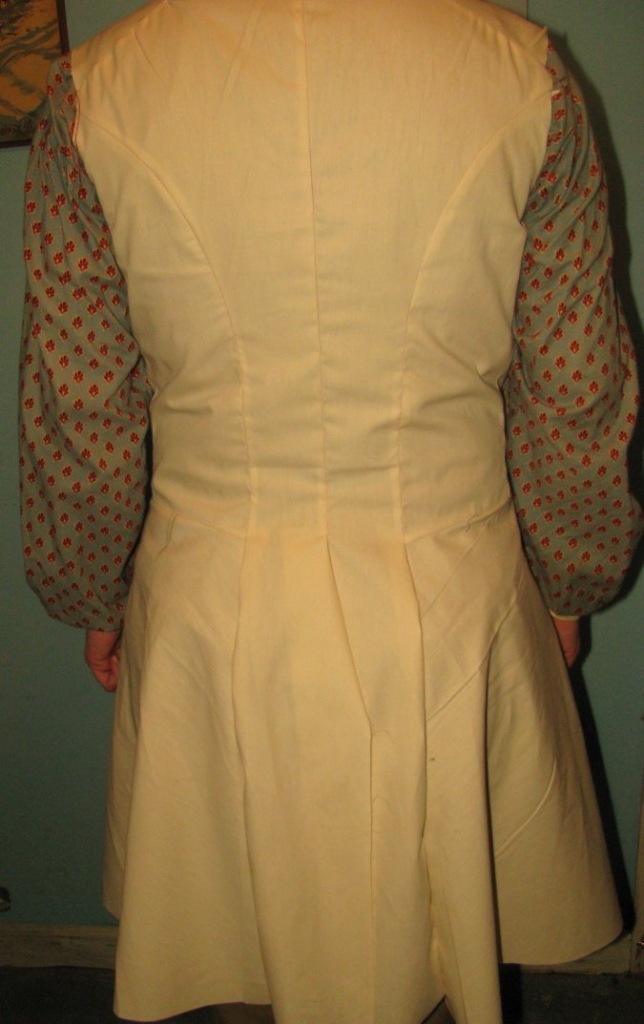
Notice how the armscye comes right up to the bottom of the arm. This was the practice back then, and is still used on higher end coats today.
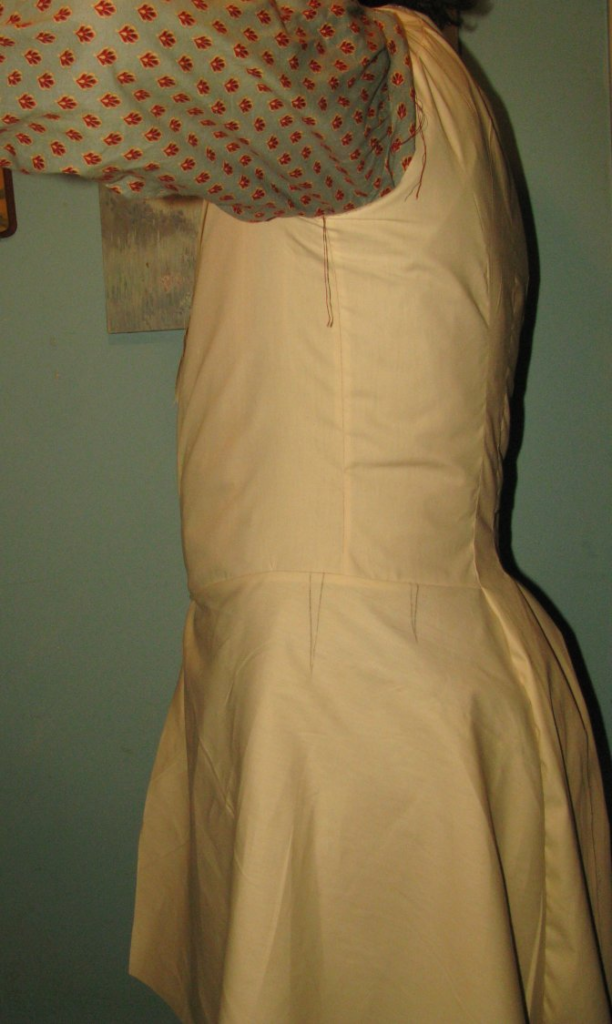
I need to shorten the back about 1/2 an inch.
Front view with arms raised to show how there is almost no movement of the coat. Try that with yours and see if the results are the same. A close fitting armscye gives much more mobility, contrary to what most people think.
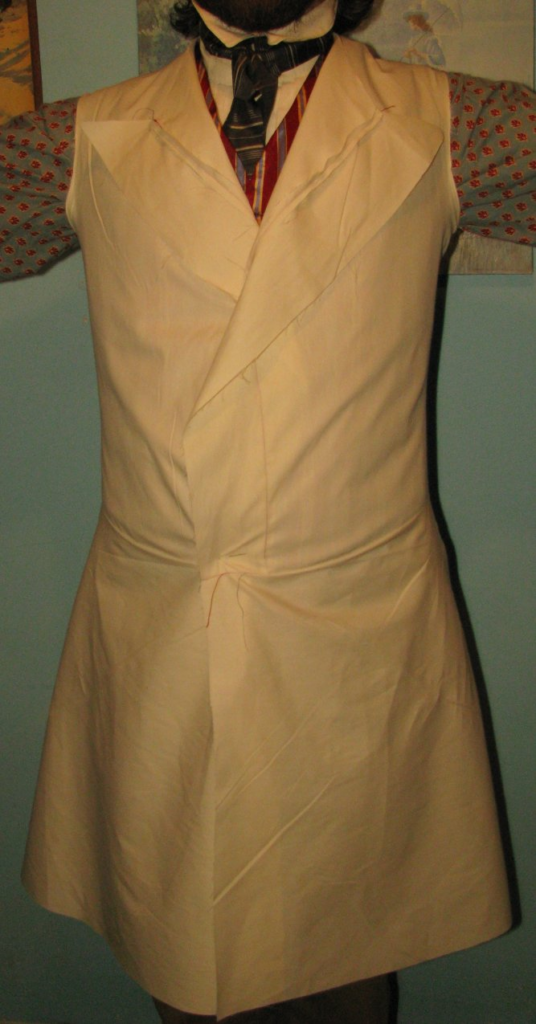
Seam Allowances
At the end of this drafting process, you should have the following pattern pieces. Note the seam allowances that have been added to the sides and bottom of the forepart and side piece, the sides of the back piece, and the top of the skirt seam. These are the basic seam allowances used for any frock coat. We will be adding inlays later on to account for fitting issues.
The dart lines in the forepart indicate sewing lines, not seam allowances.
All seams are .25 inches.

The Top Collar
It’s now time to install the top collar, which must be basted into place much like the front facings were, in order to ensure that it drapes correctly.
Begin by pressing and basting the under collar seam allowance 1/2″ along the top edge.
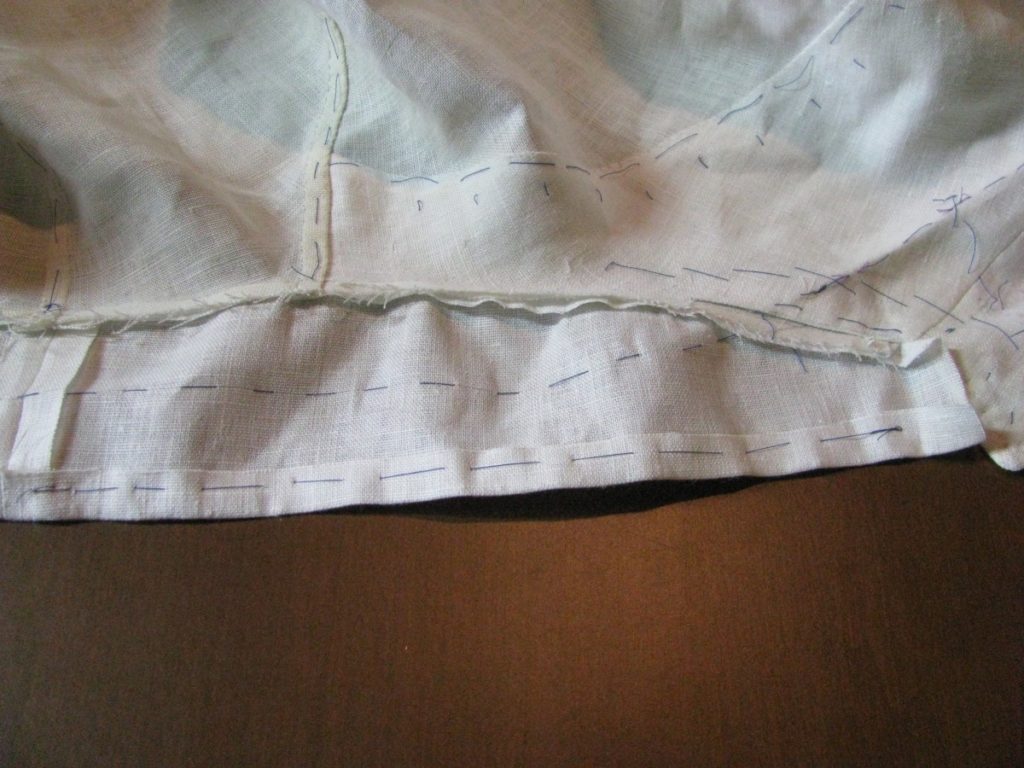
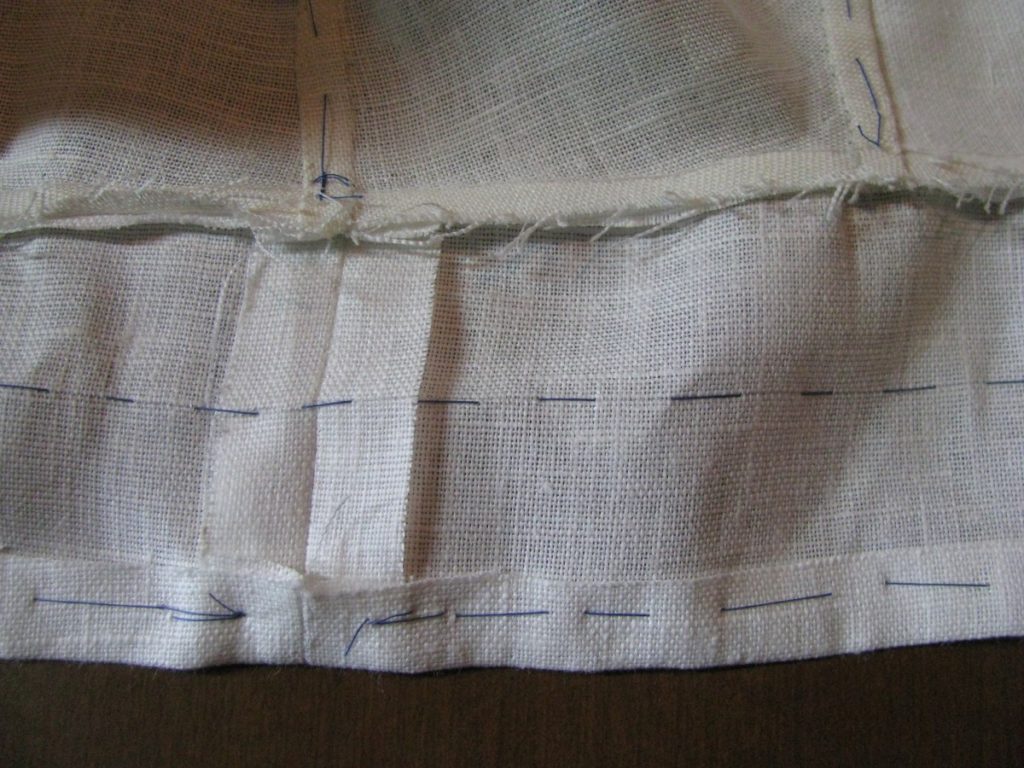
Do the same thing to each end. By doing the ends second, you ensure that the folded seam allowance angles inward so that it will not be seen in the finished collar.
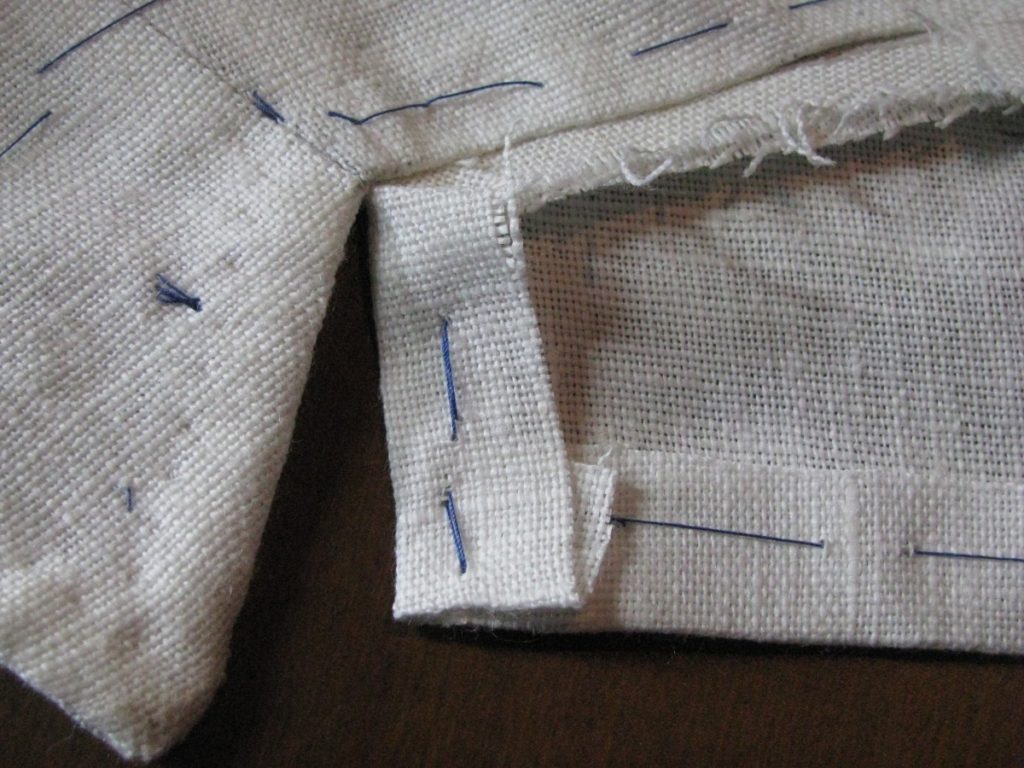
A view from the right side showing the seam allowances basted in place. You want this to be as neat as possible as it gives you the finished position of the collar.
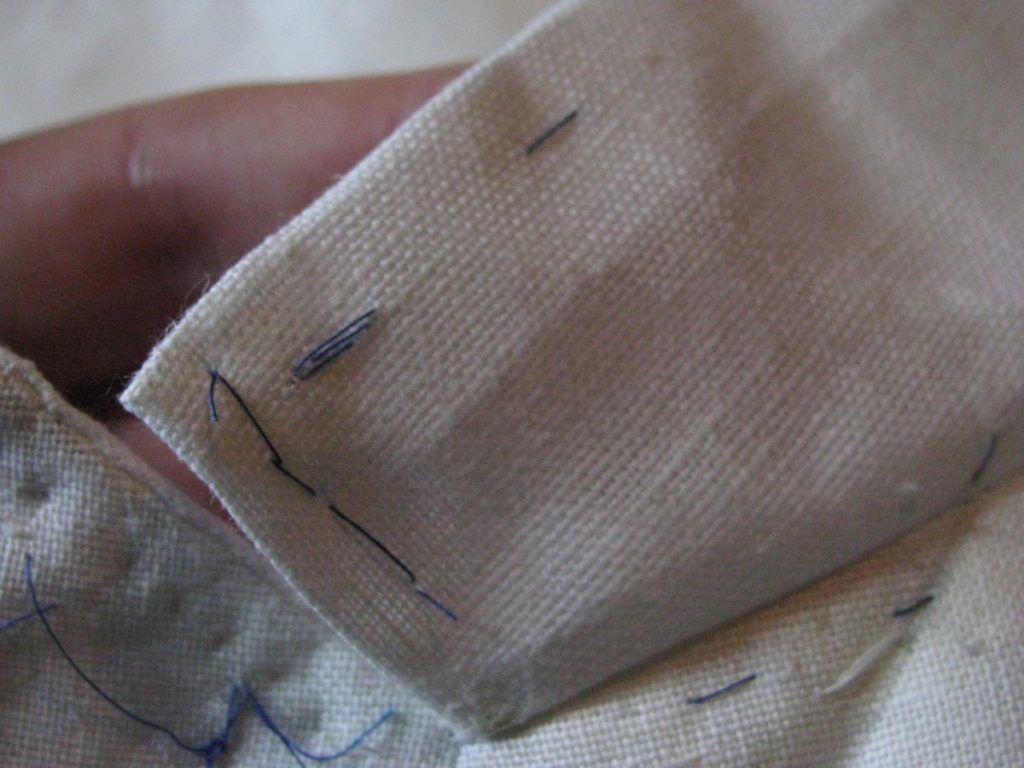
Also note how the lapel, coat body, and collar all meet precisely at the same point.
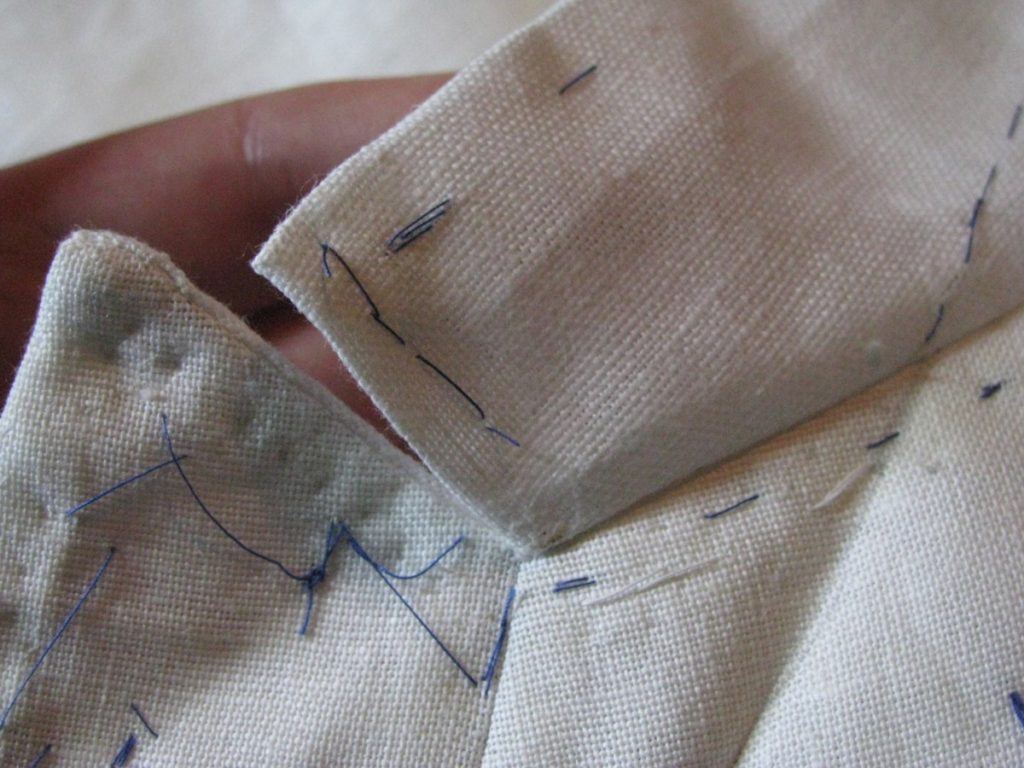
It’s time to cut out the top collar, with the center line on the fold. Lay the pattern down, and then mark a line 1″ all the way around. Cut out the collar. This extra material gives you room to fit the top collar properly.
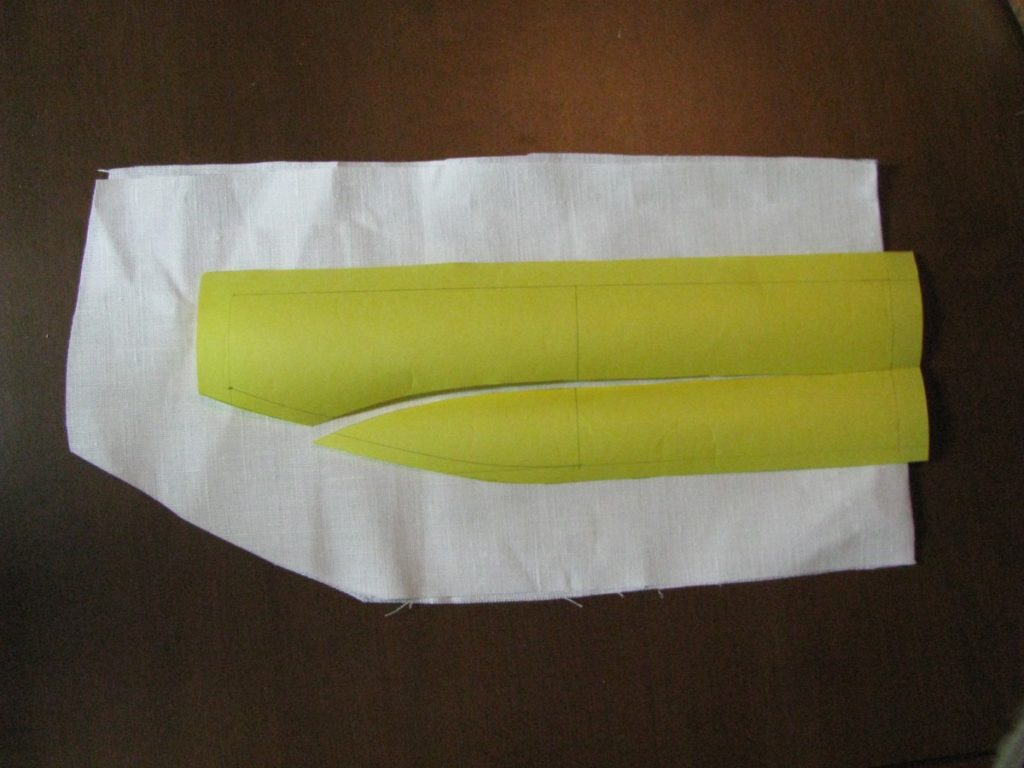
Lay the top collar wrong side up on the table and lay the coat wrong side down, on top of it. Make sure the flat edge of the top collar is positioned towards the top of the collar.
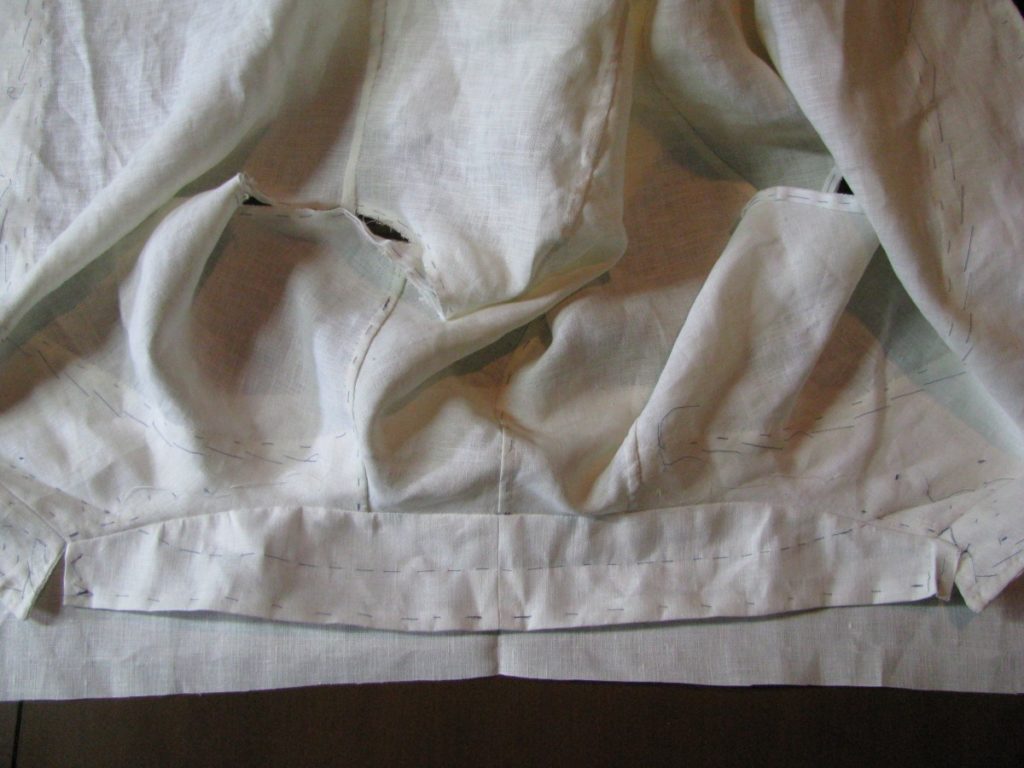
Not really much to photograph here, but starting about an inch from the edge of the collar, baste along the roll line of the under collar, catching the top collar underneath.
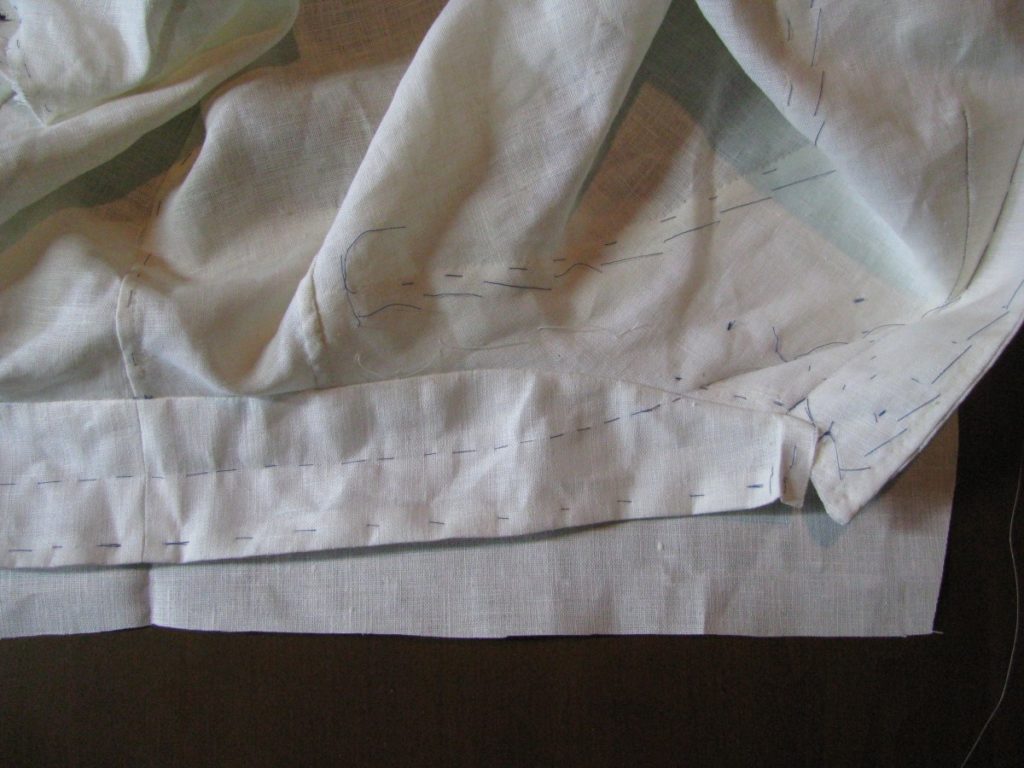
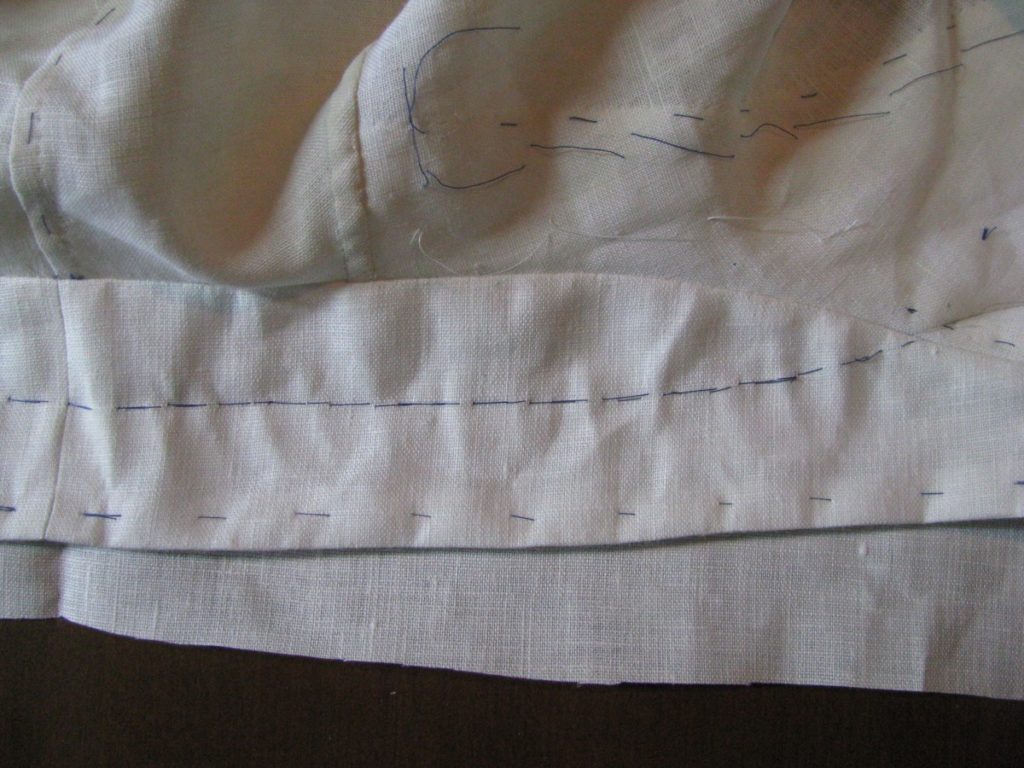
Stop 1″ from the other side.
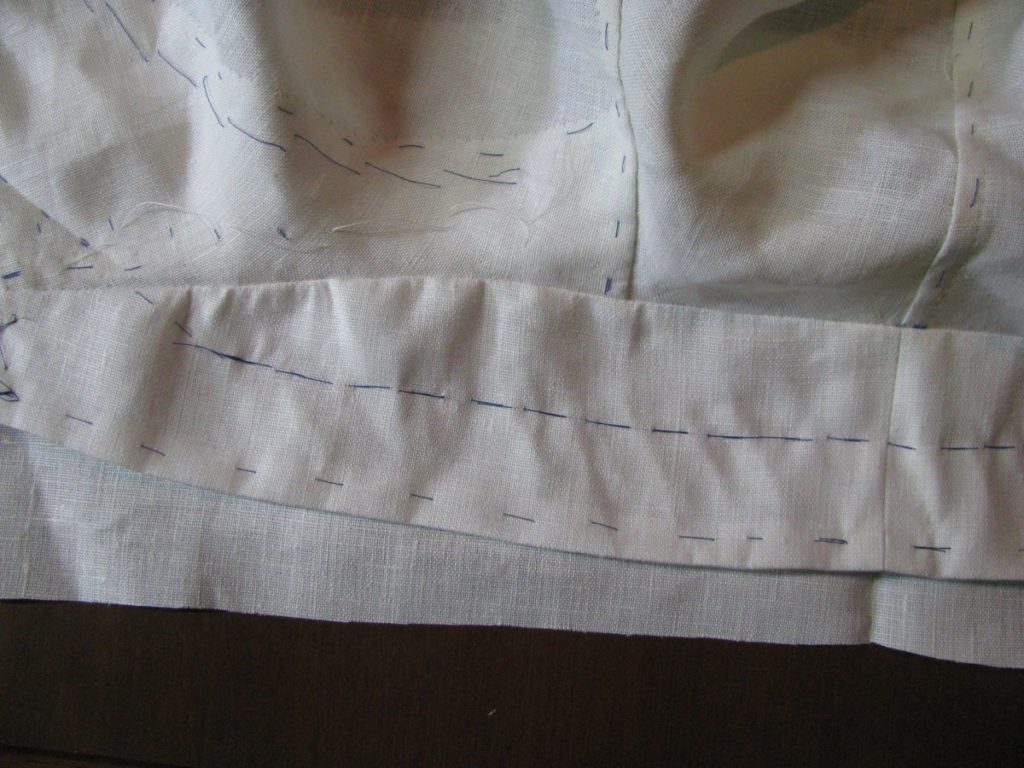
Again, about 1″ from the end of the collar, and about 3/4″ from the folded seam edge of the collar, baste along the collar catching the top collar beneath it.
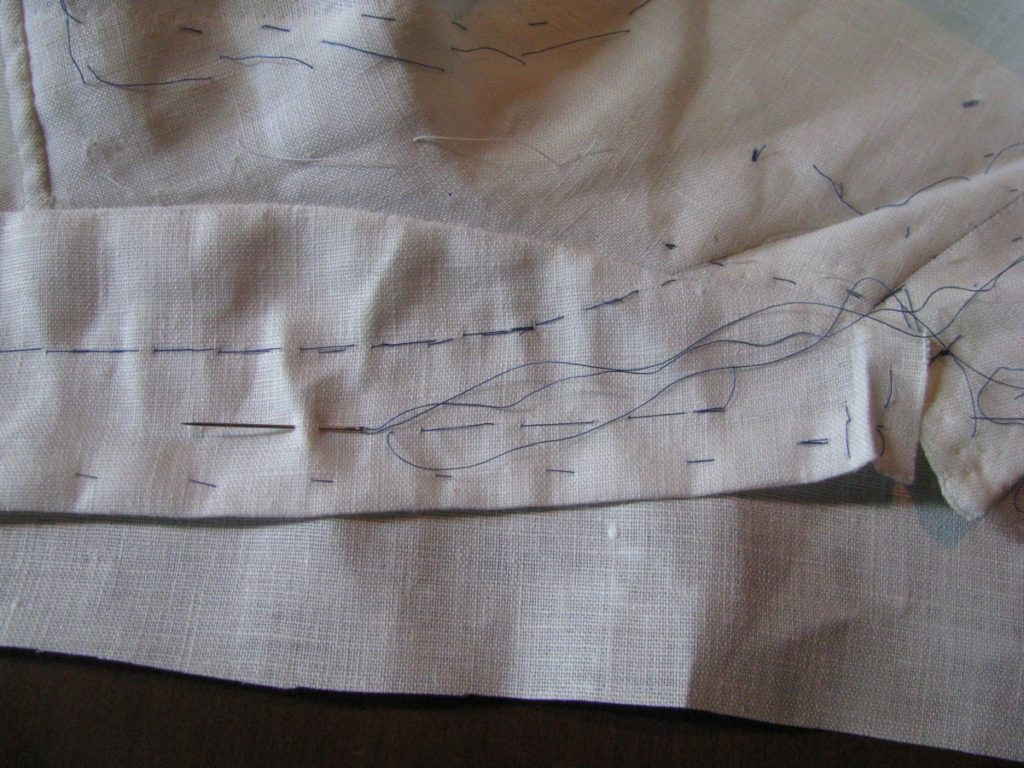
Keep the entire collar flat on the table as you work to ensure the correct tension.
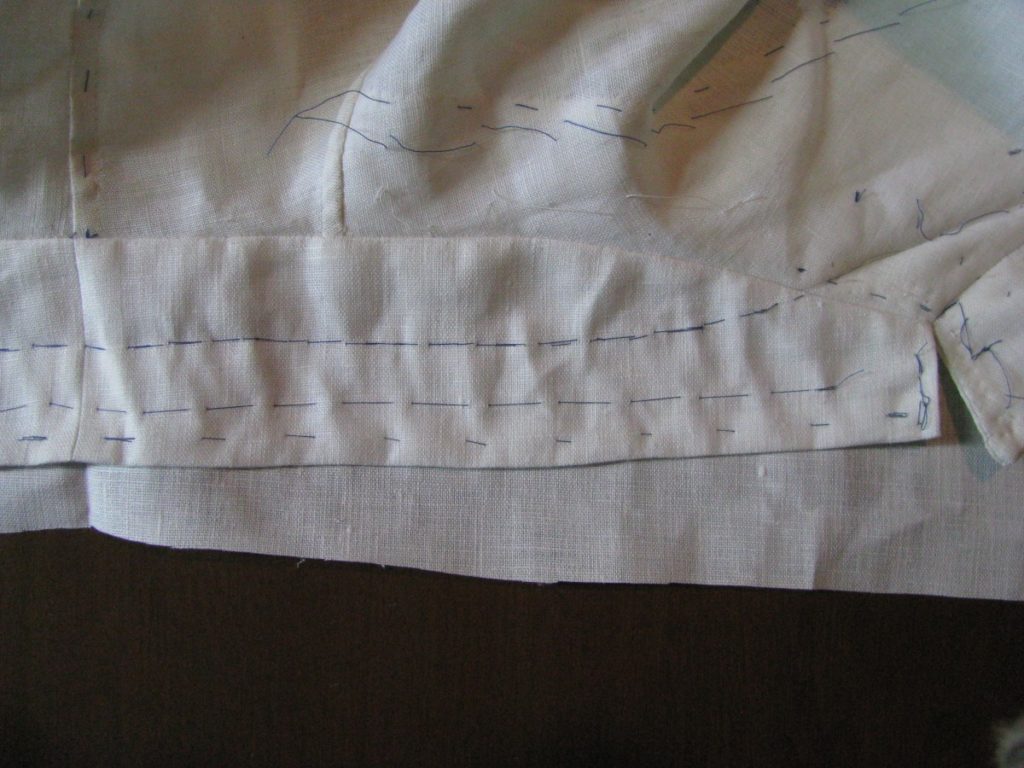
Stop 1″ from the other side of the collar.

Now carefully trim the excess away, leaving 1/2″ at the edge of the collar, and 1″ at each end. The hidden edge of the top collar is not touched at this point.

Fold under the ends of the top collar and baste, leaving 1/8″ of the top collar showing underneath.
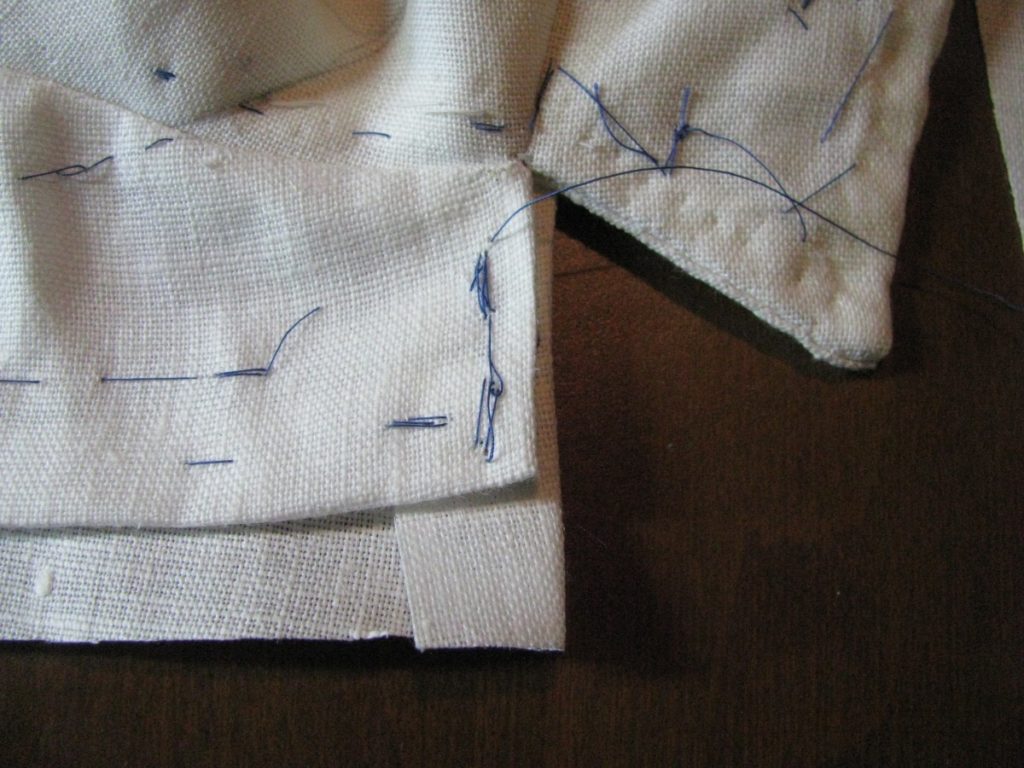
Do the same thing for the other end, then along the outer edge of the collar, keeping that same 1/8″ of the top collar visible.
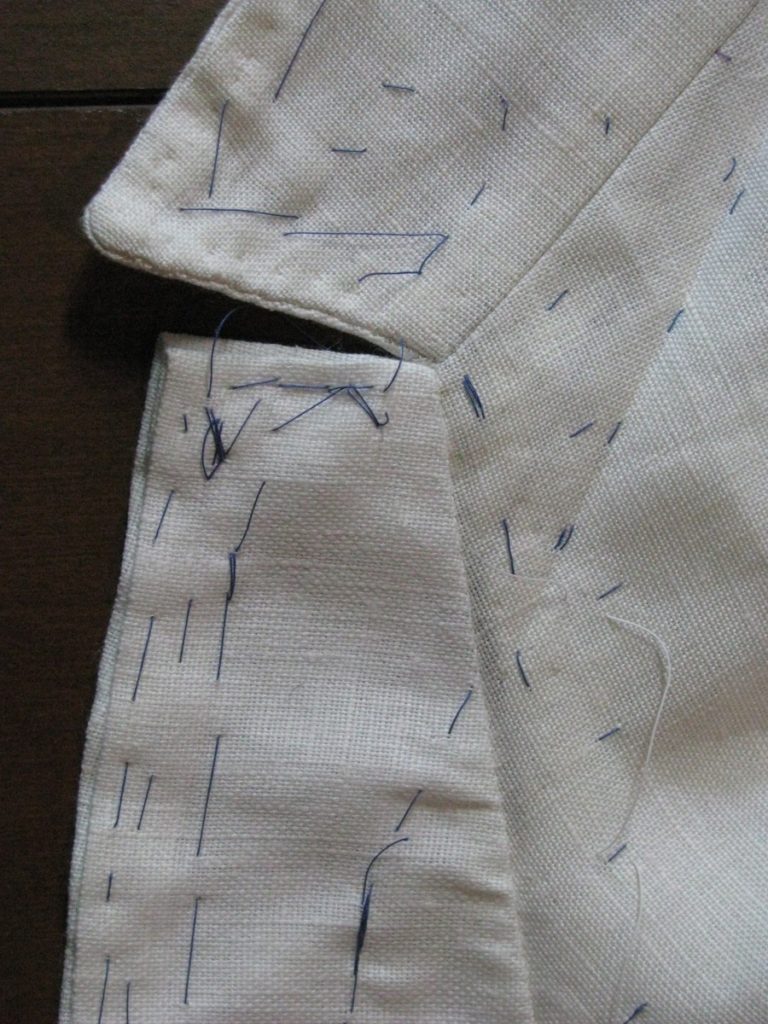
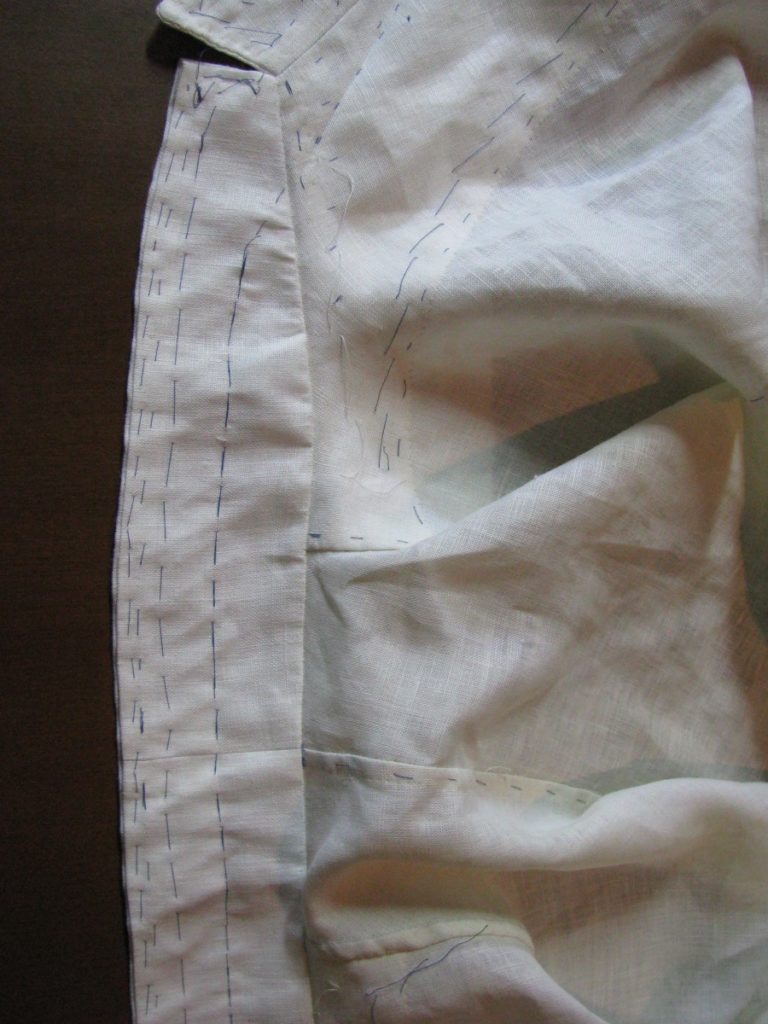
Turn the coat over so that the top collar is fully visible. At each end, crease the top collar back along the gorge line just to give you an idea of where to trim in the next step.
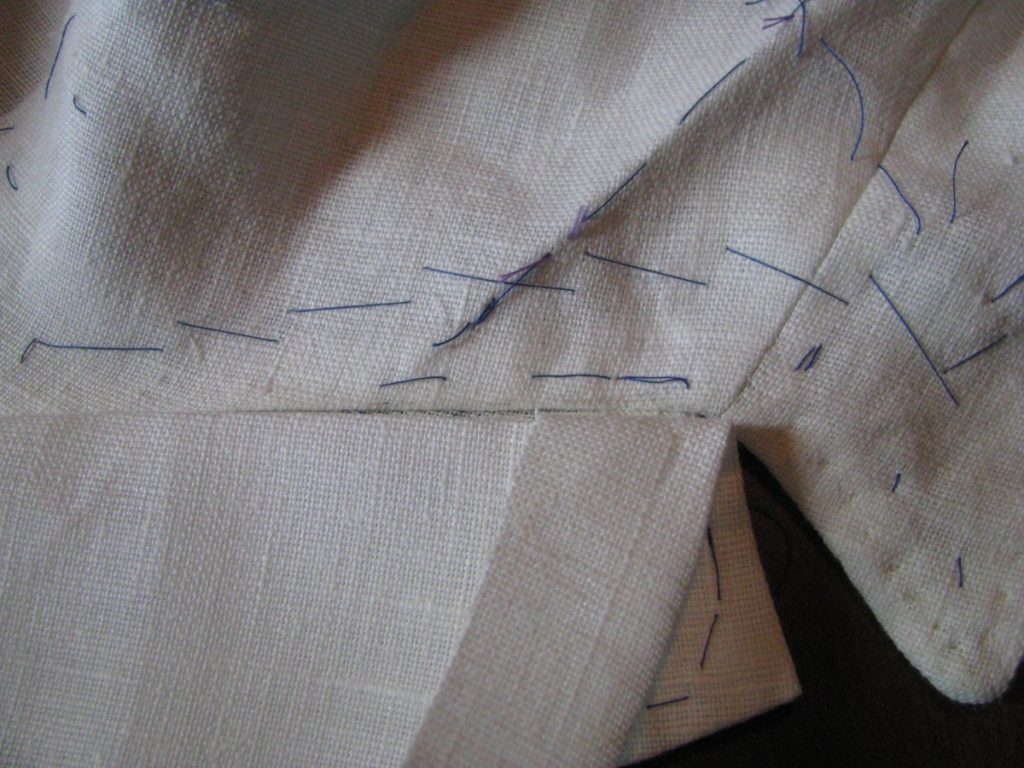
After both gorge lines are creased, continue the crease along the middle of the collar, so both creases meet up.
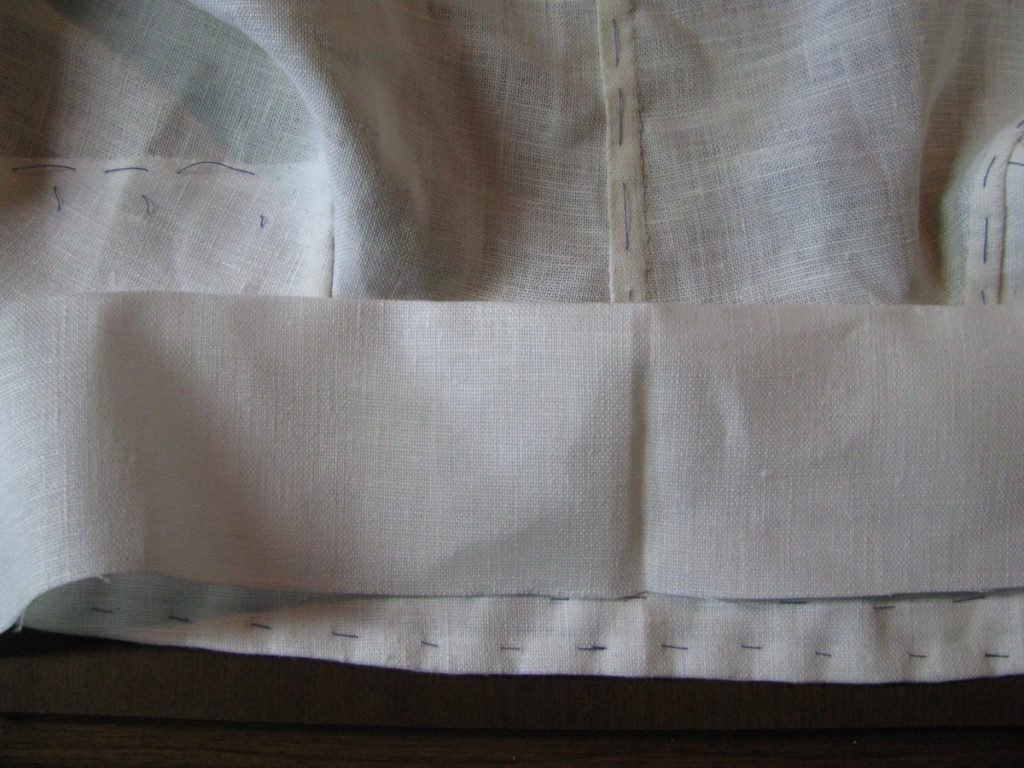
Keeping 1/2″ away from the crease line, trim off the extra fabric from the top collar.
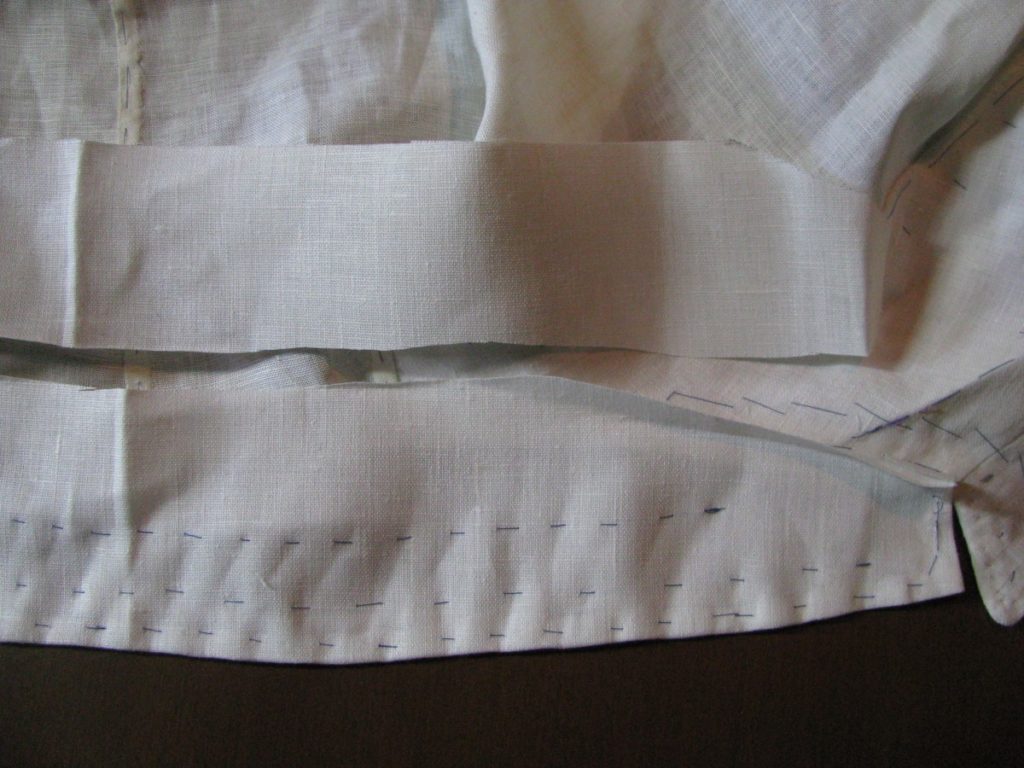
Now fold under the 1/2″ seam allowance at each gorge line and baste securely closed.
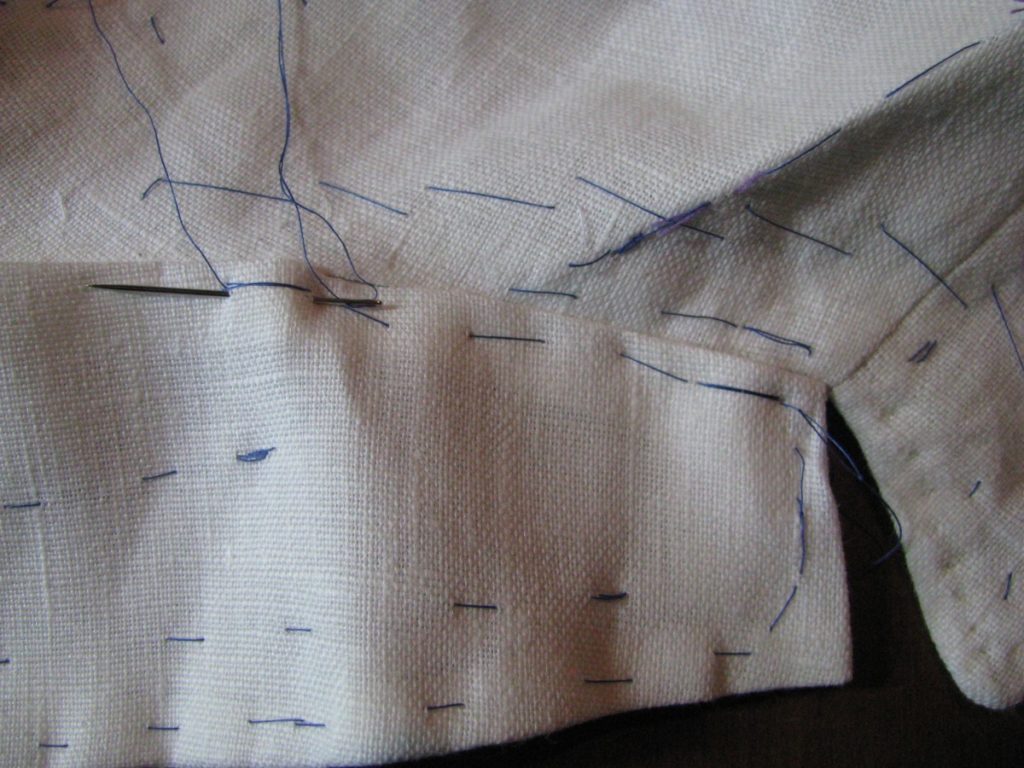
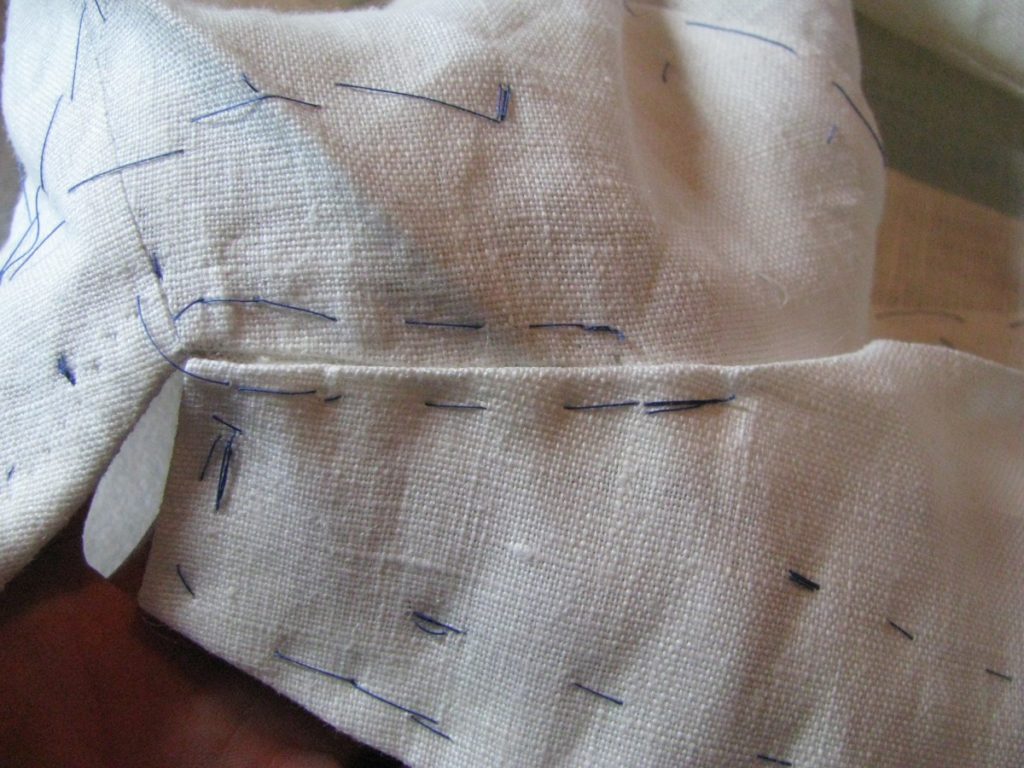
Turn the coat back over so that the top collar is next to the table again. On the inside of the roll line, beginning about an inch from the edge of the collar, baste across the under collar, again catching the top collar underneath. This row of basting is about 1/2″ from the roll line.
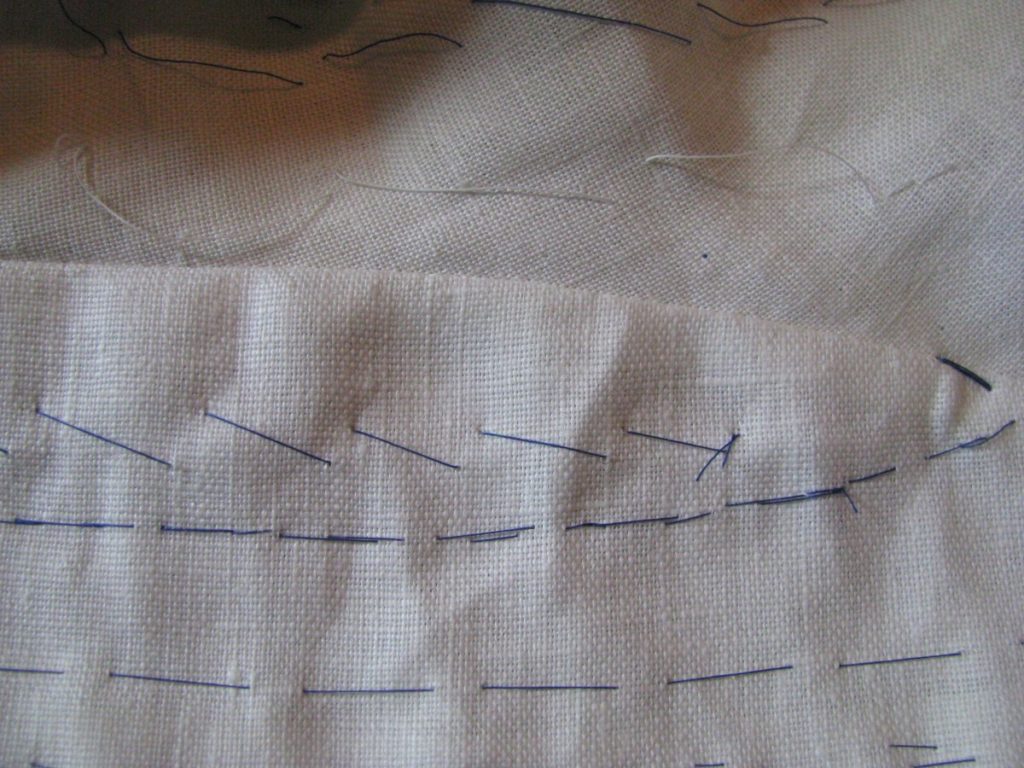
Continue all the way across.
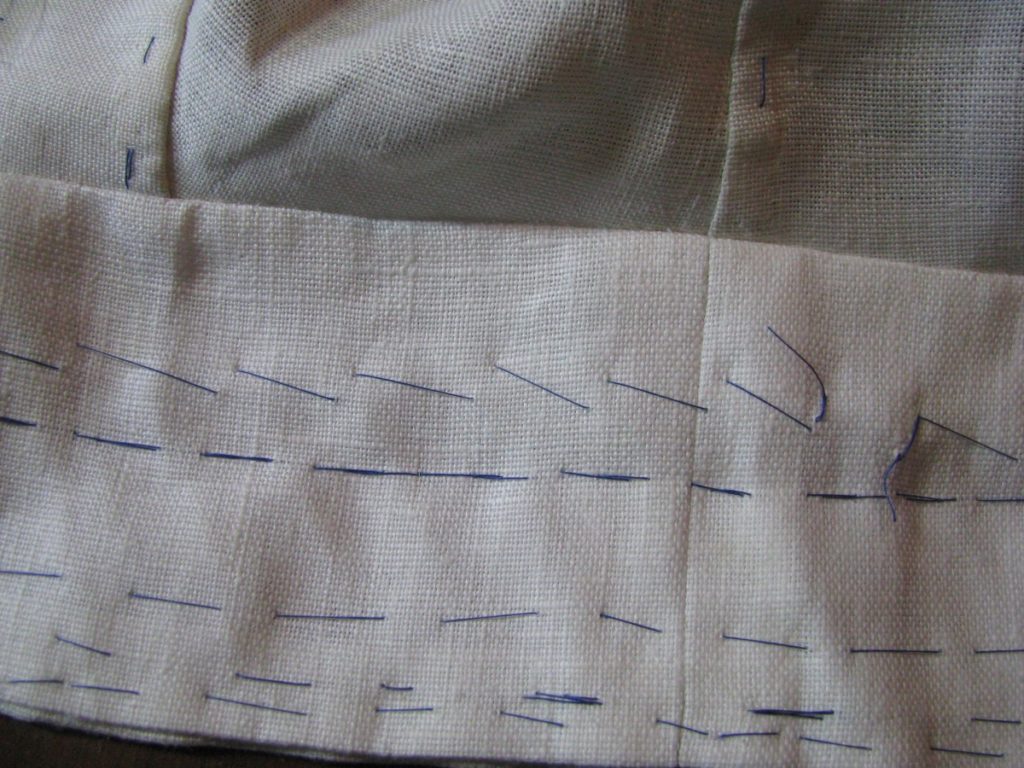

Turn the coat over so that the top collar is again facing you, and fold under the remaining raw edge of the collar so that it aligns with the stitching holding the under collar in place. Baste securely.
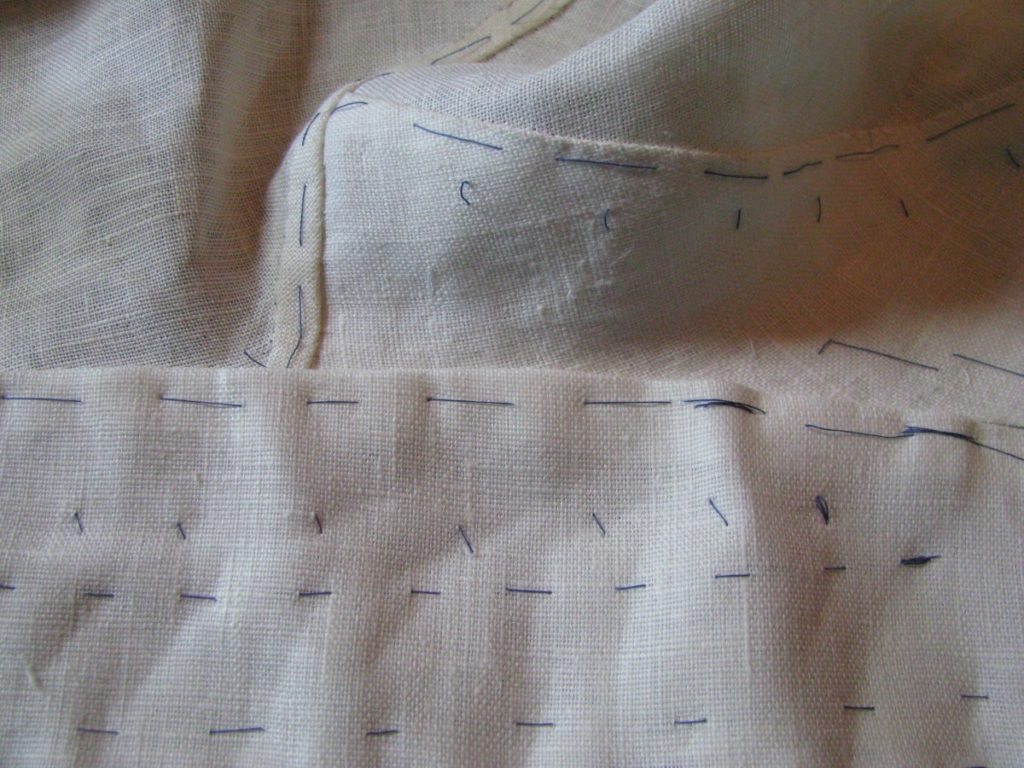
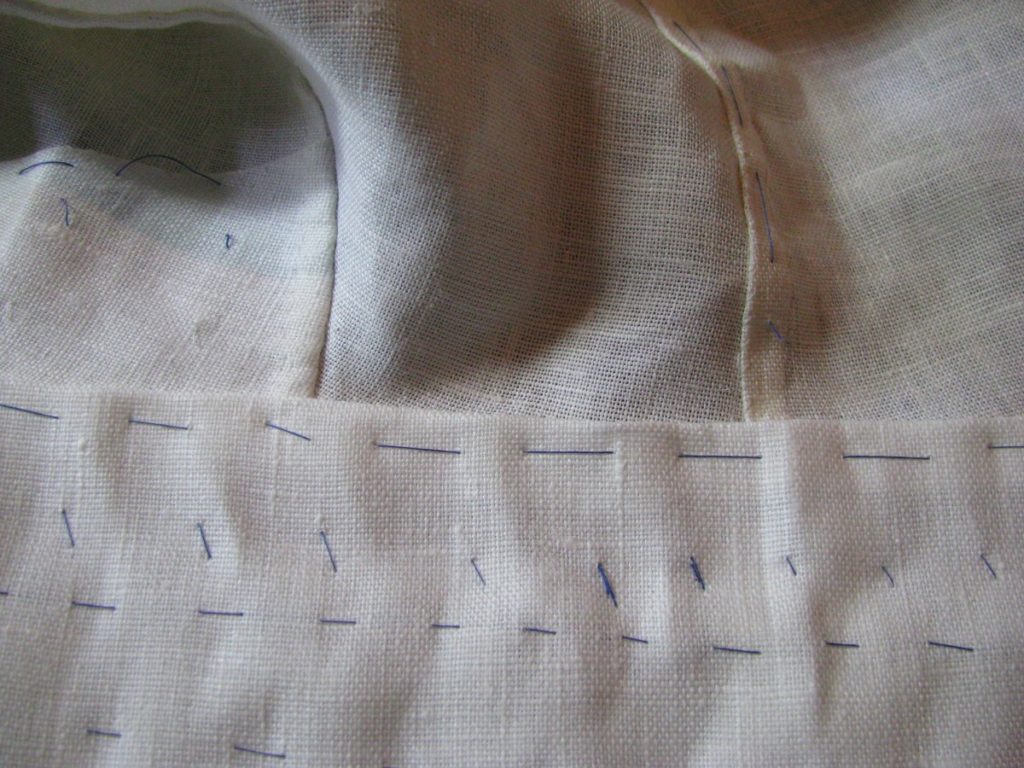
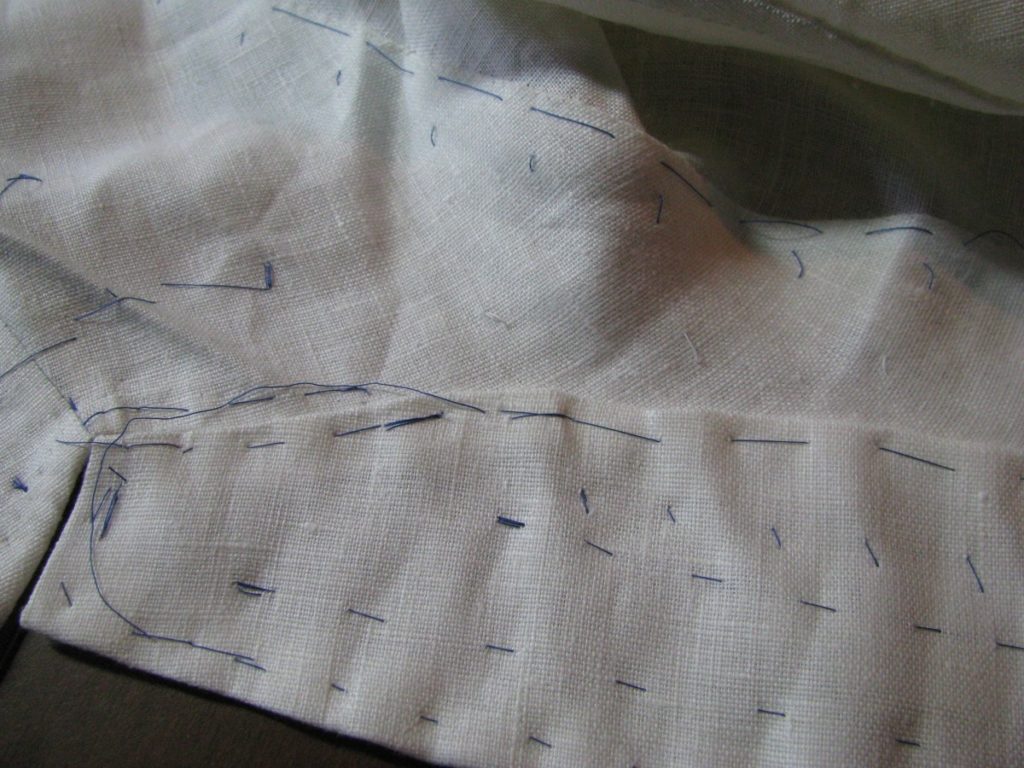
Working from the underside of the collar, carefully fell the top collar to the under collar, beginning at the outside edge of the collar, across the top, to the other end.
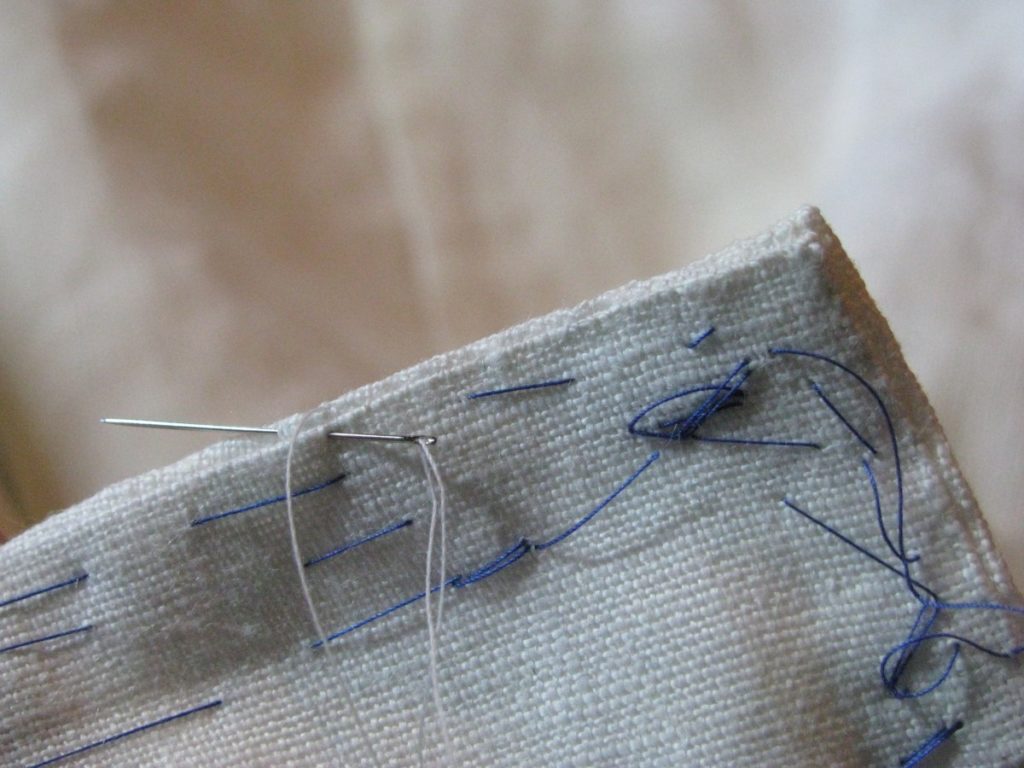
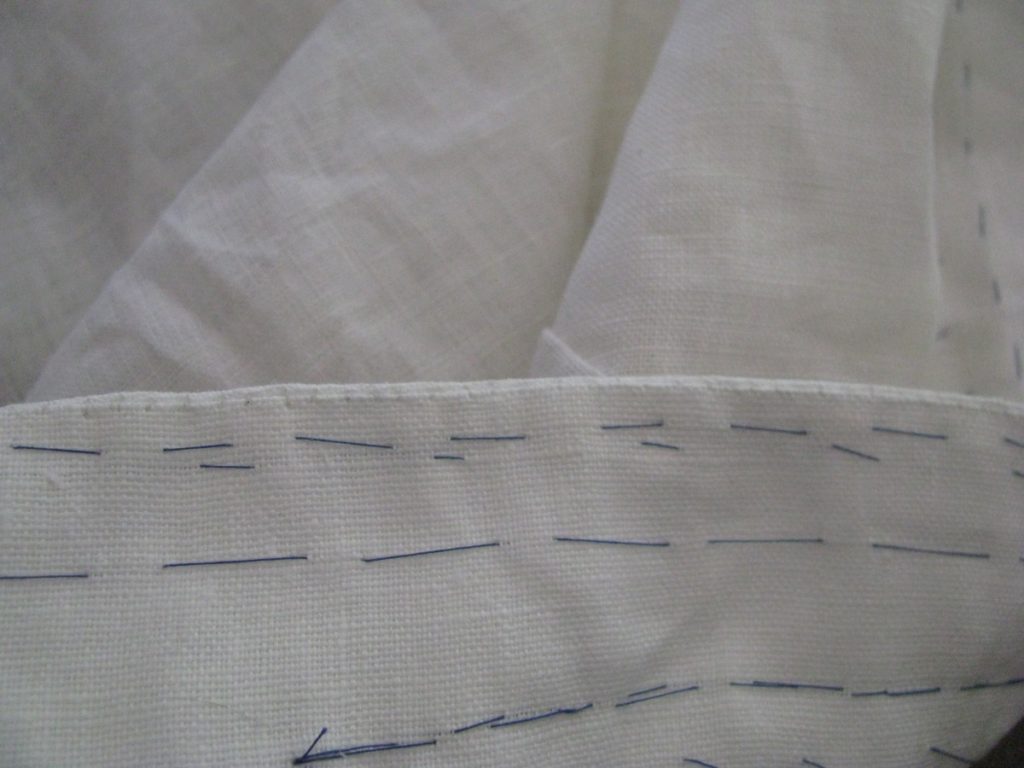
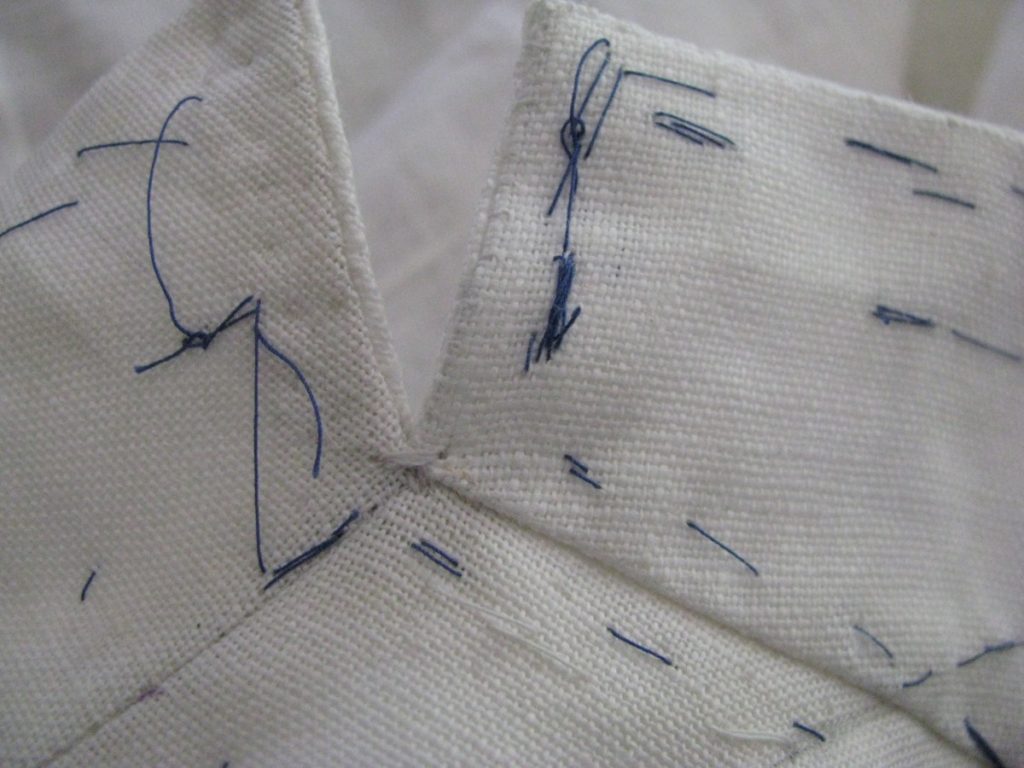
At one end of the collar (depends on whether you’re right or left handed, your preference), make about 4 or 5 backstitches in place at the point where the collar meets the lapel. This just firms up the area and prevents tearing.

Pass the needle and thread through to the top side of the collar. We’re in position now to start the ladder stitch, which is used to close up the collar and lapel along the gorge line.
Here’s a video demonstrating the ladder stitch:
Start by taking a stitch just above the crease, on the top of the lapel.
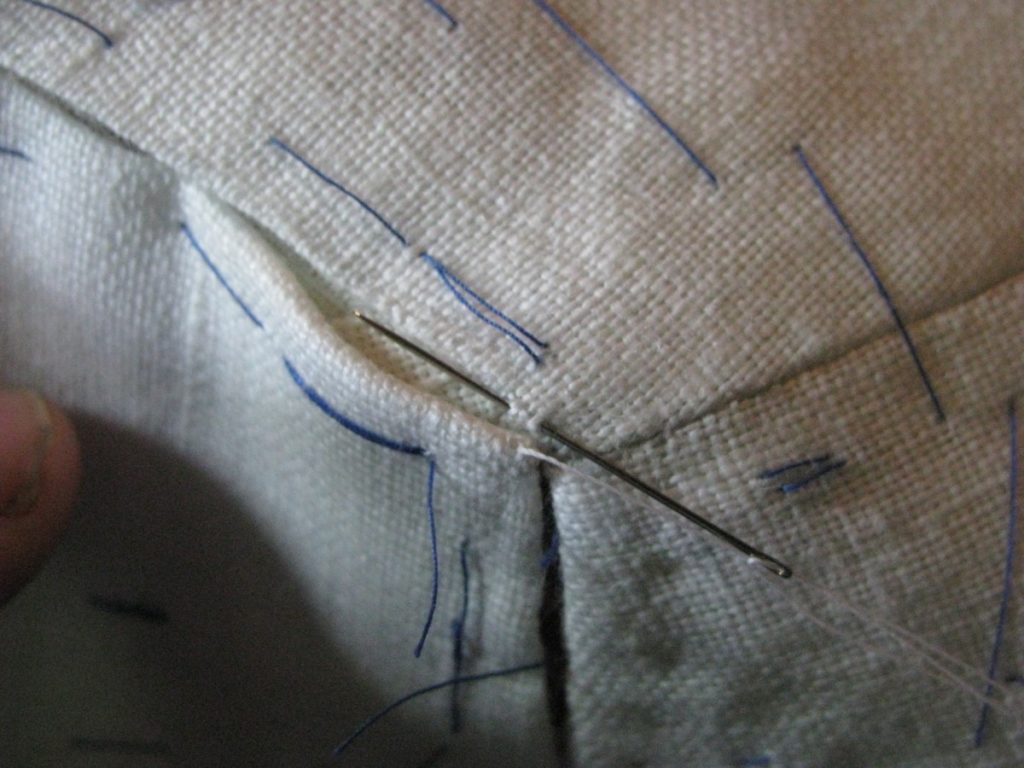
Then do the same to the collar side, entering the collar just across from where the last stitch exited. Repeat the last two stitches.
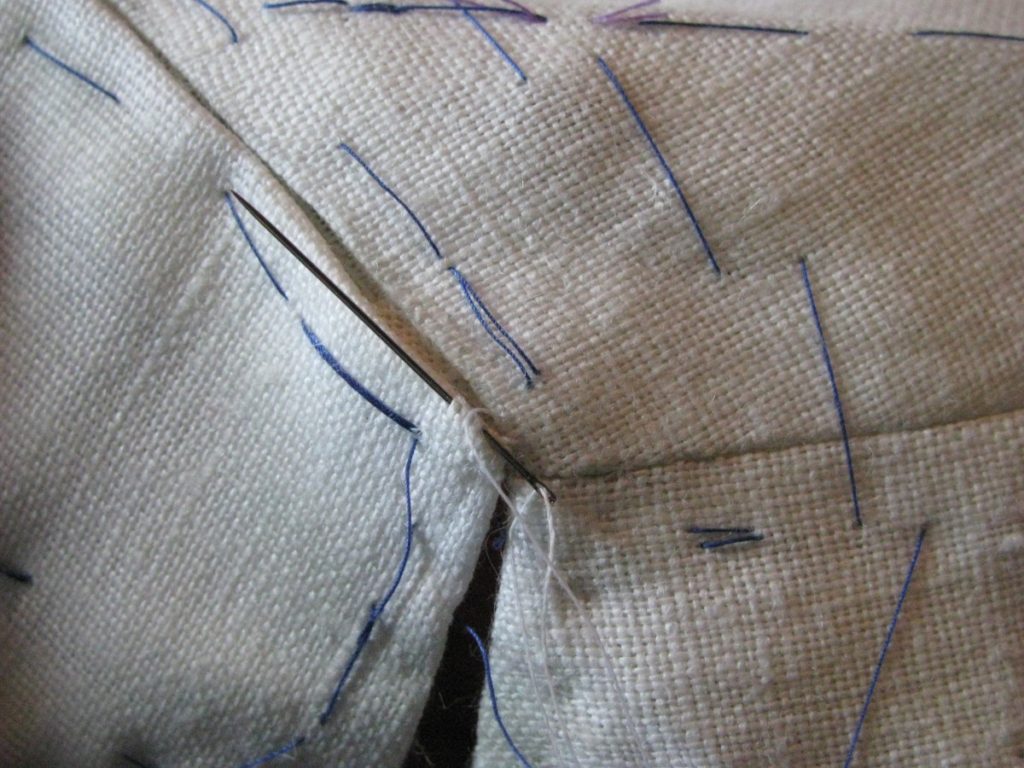
Every four stitches or so, take a stitch through the under collar, in between the two folded edges that you are sewing together. This holds everything more firmly in place. Pull the thread taught (but not too tight), right after you make this stitch.
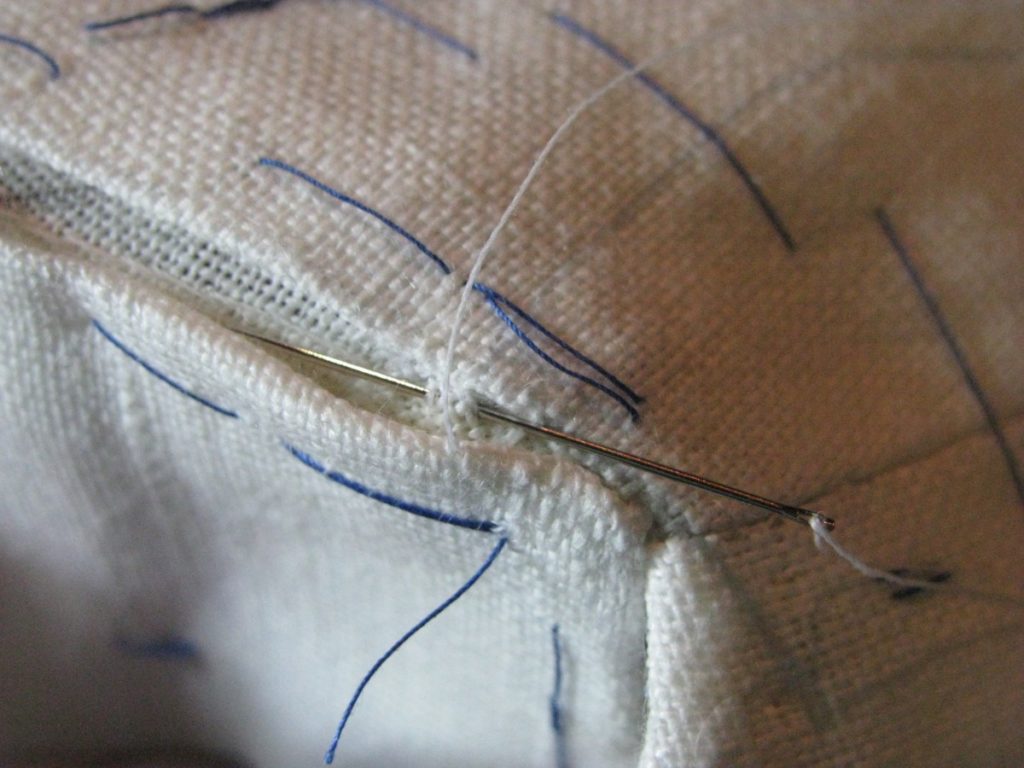
Continue the entire process until you reach the end of the gorge line (which is where that snip was made in the facing).
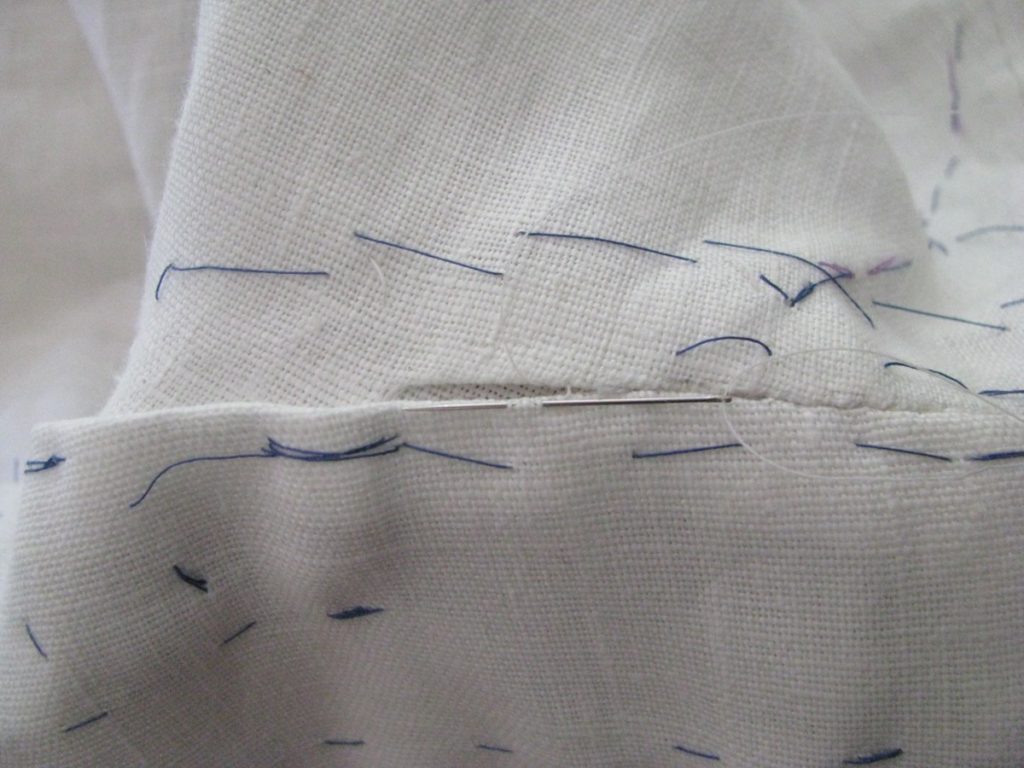
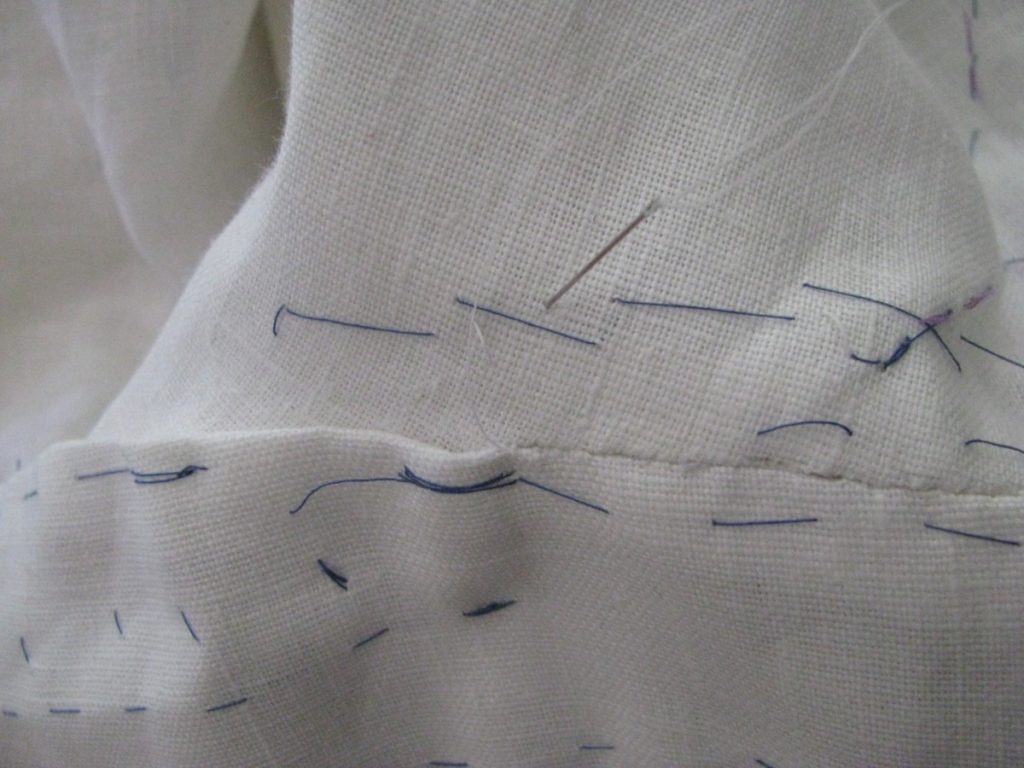
When you reach the end of the gorge line, simply continue by felling the top-collar down to the neck along the shoulders and back. Continue until you reach the other gorge line.
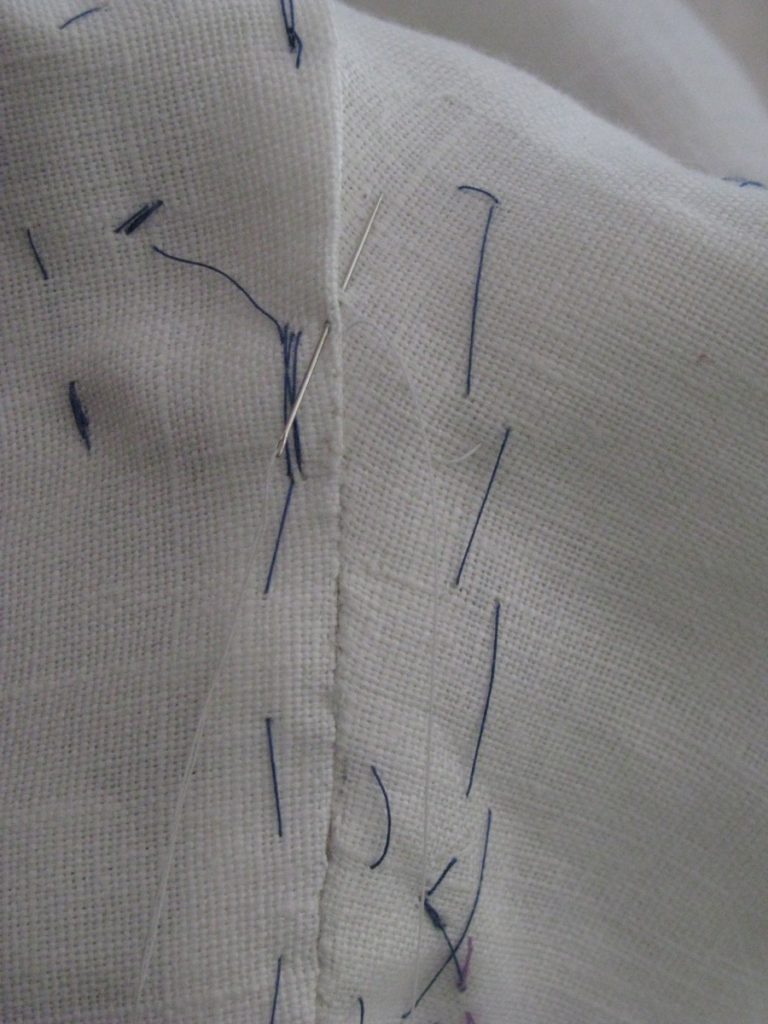
And then continue with more ladder stitching, finishing up with another bar tack on the underside, as before.
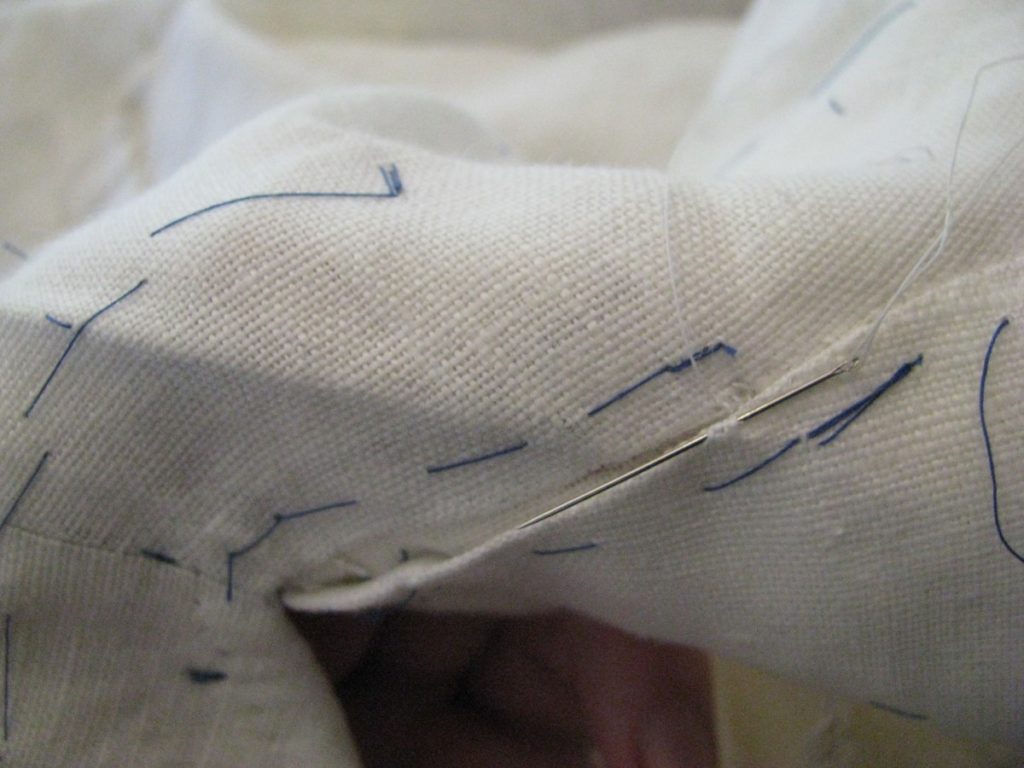
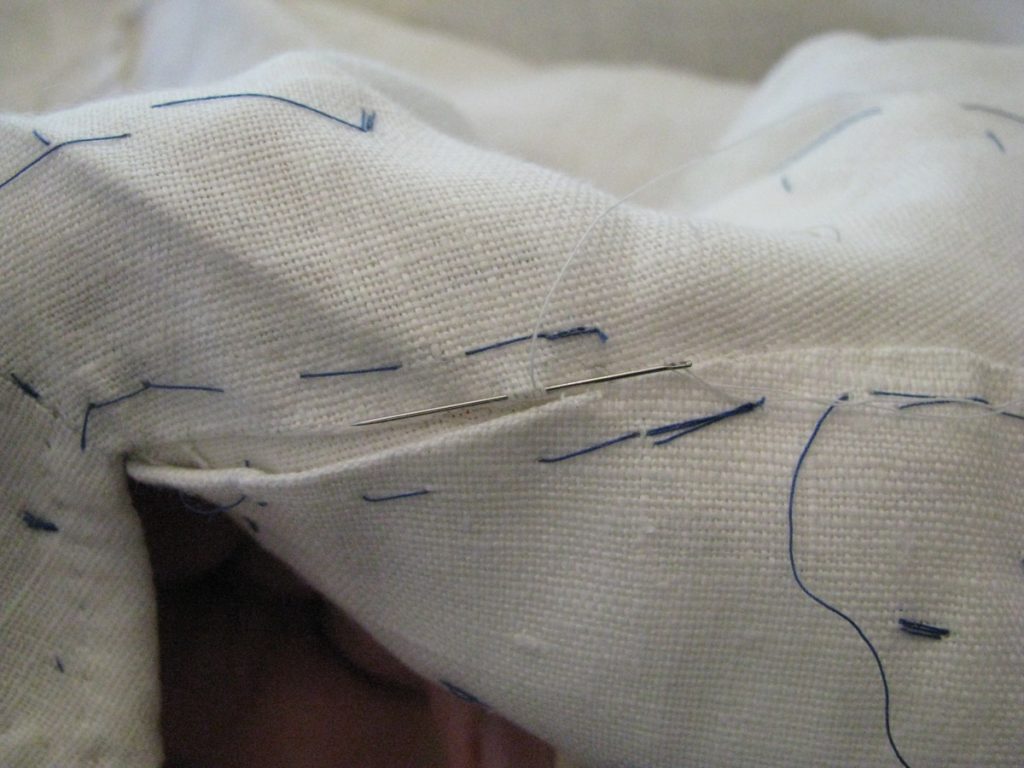
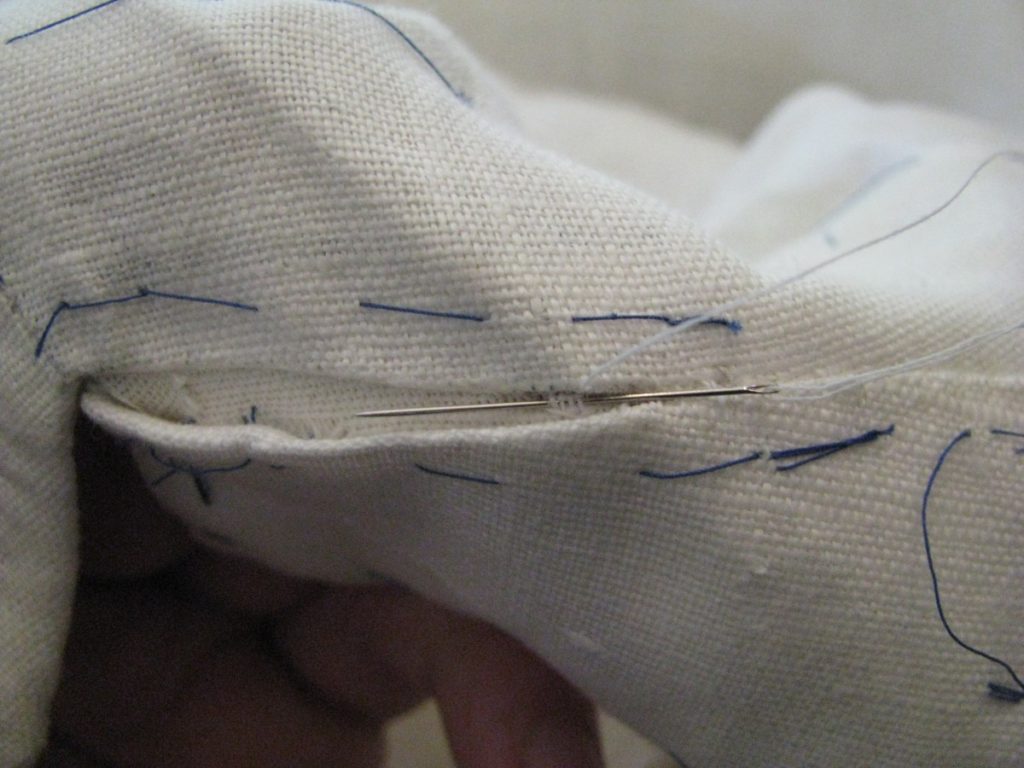
Here’s a photo of the stitches before they are pulled tight.

The last stitch before passing the thread to the other side for a bar tack.
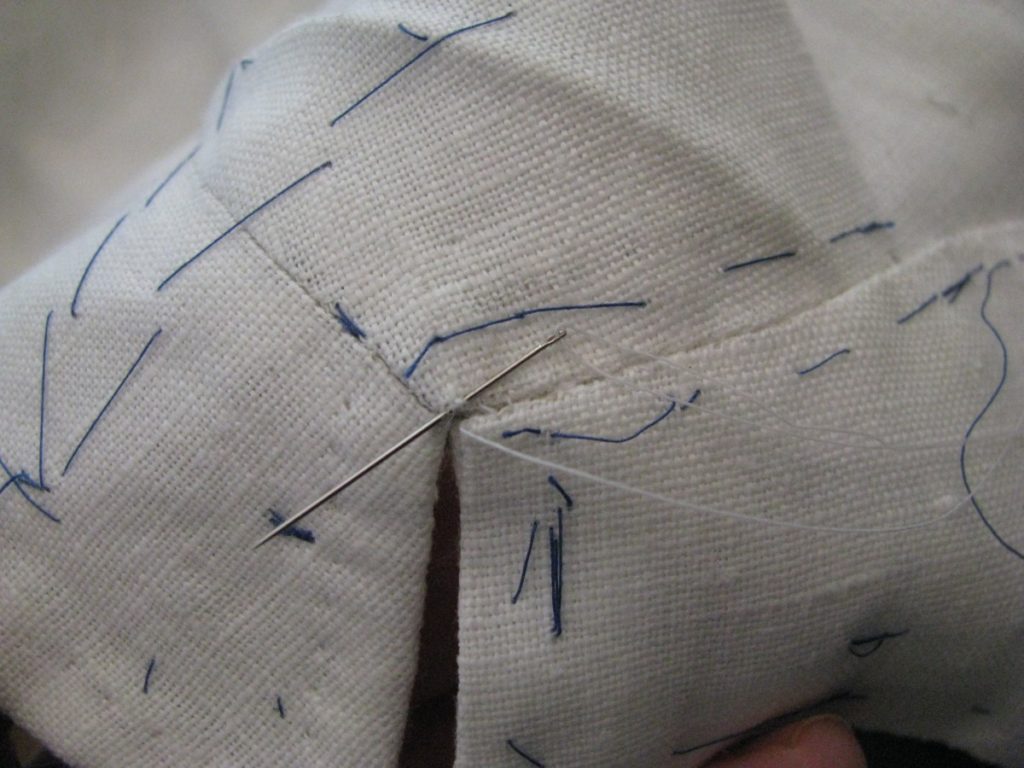
Finish the collar by top stitching using a side stitch, 1/4″ from the edge, just as you did with the facing.
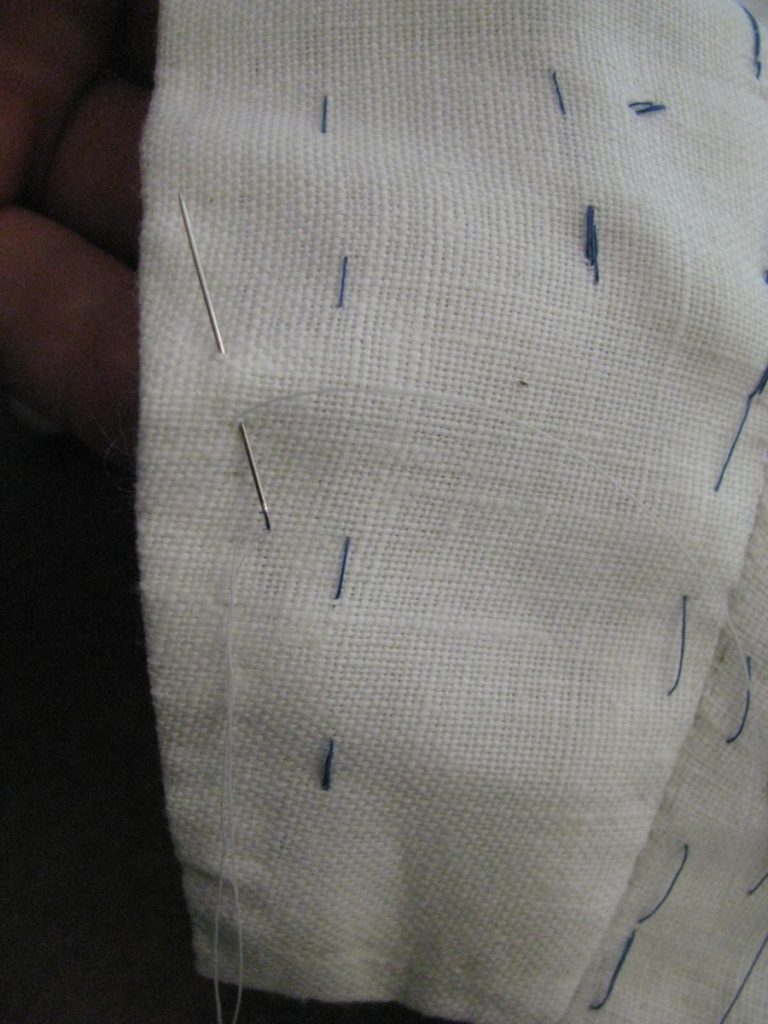
The Under Collar
If you have not done so yet, now is the time to draft your collar pattern using my guide in the Frock Drafting series. Here is my pattern, freshly drafted:
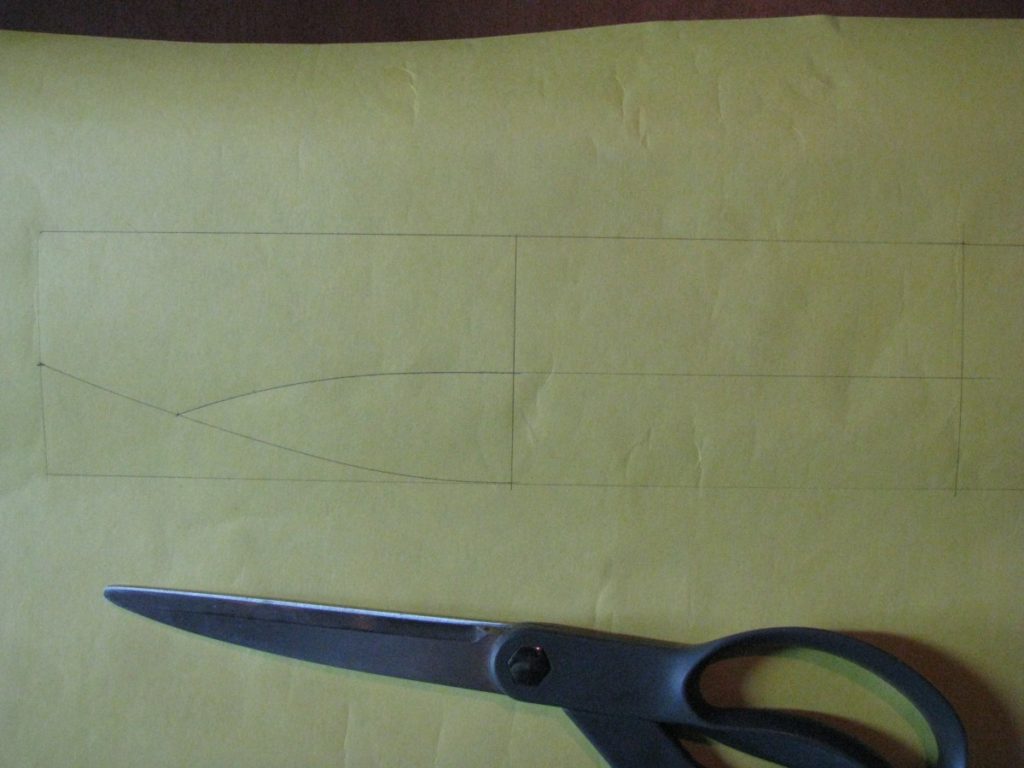
Before cutting out the pattern, add a 1/4″ seam allowance along the bottom curved edge (or whatever you used for the neck seam allowance). Add 1/2″ seam allowance along the top edge, and two sides. This simply makes it easier to finish later on.
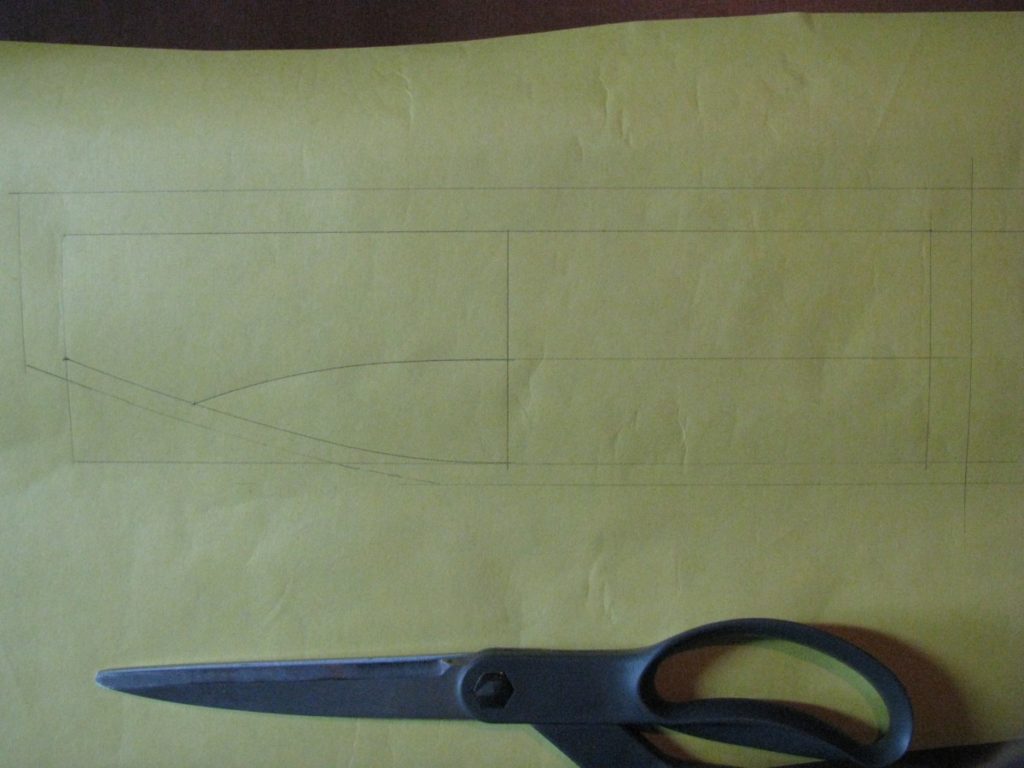
Cut out the pattern, and then the undercollar, which is made of two halves. Draw in the 1/2″ seam allowance along the center back (which is the wider side).
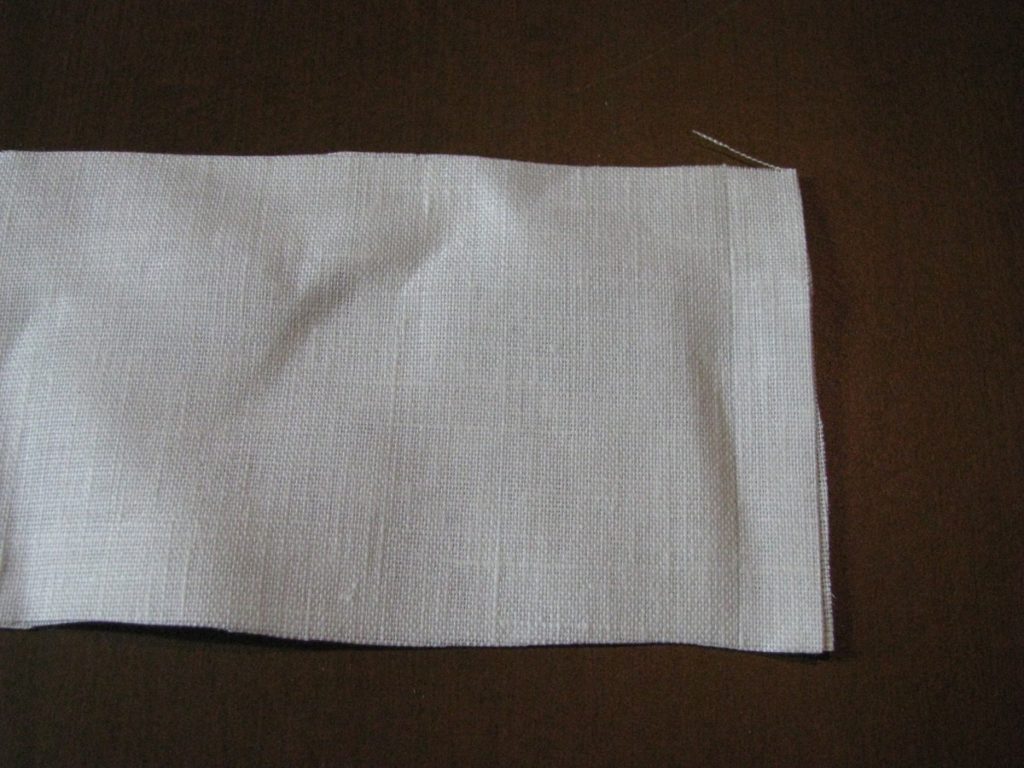
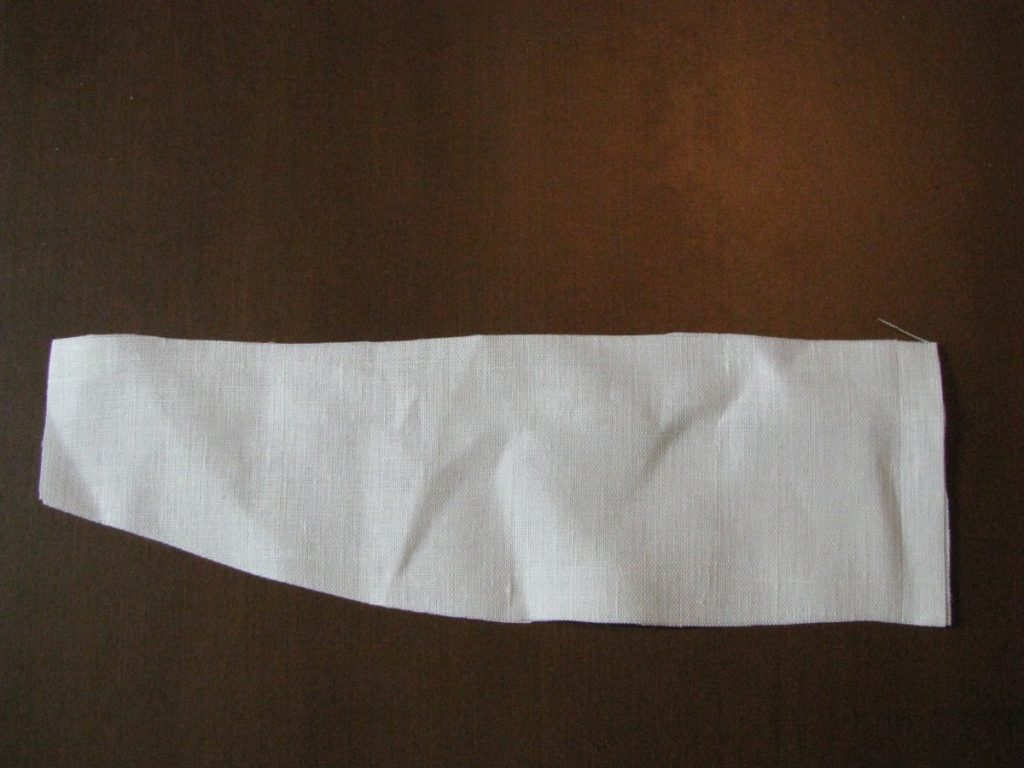
Stitch the under coller halves together using a backstitch. The collar is often under stress so it’s best to use a back stitch.
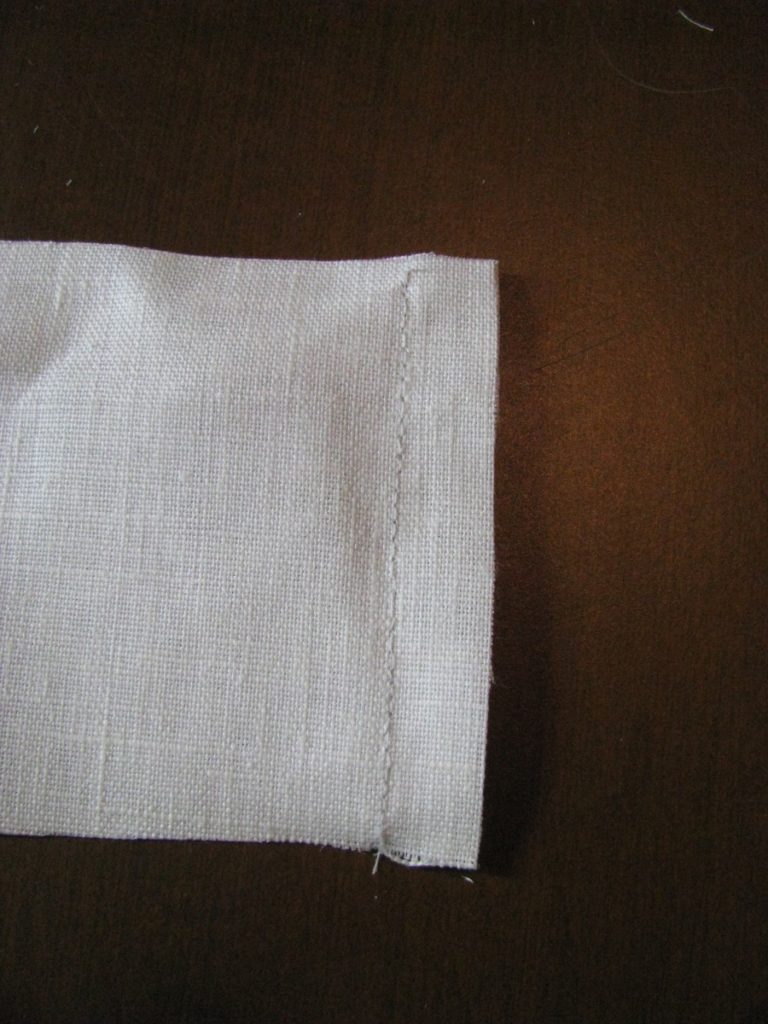
Press open the seam allowance. This can be trimmed to 1/4″ if you wish.
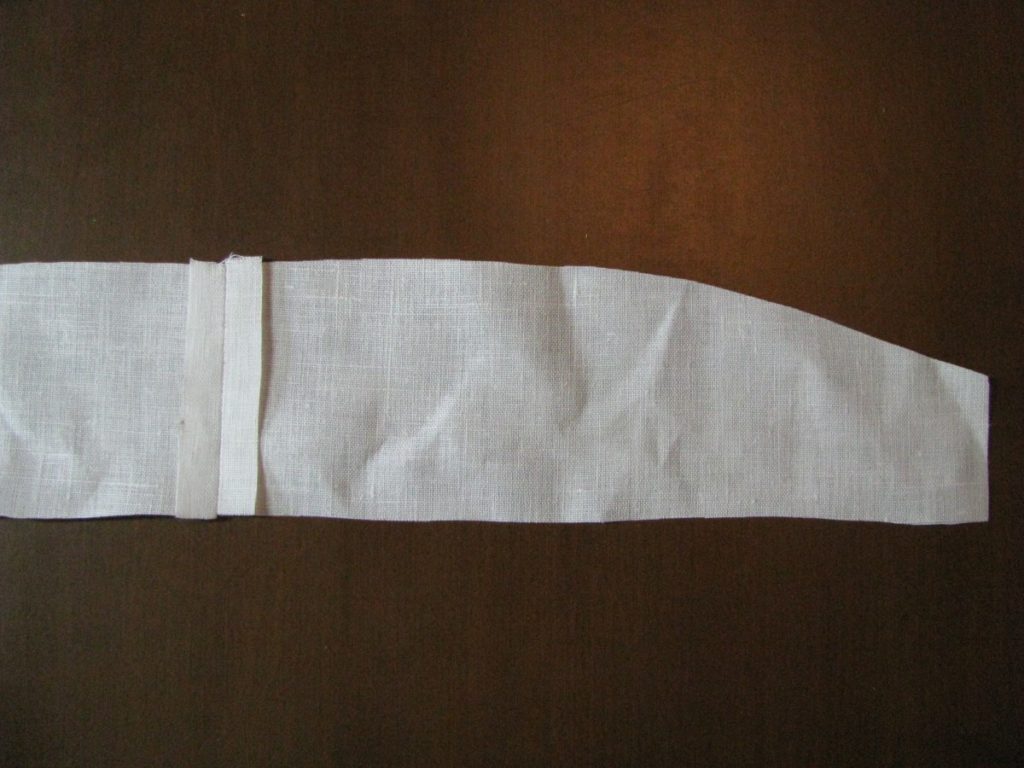
Transfer all seam allowances to the collar. Note here I accidentally put the 1/4″ seam allowance on the top of the collar instead of the curved bottom seam where it belongs. Figured that mistake out as I was basting the collar onto the coat.
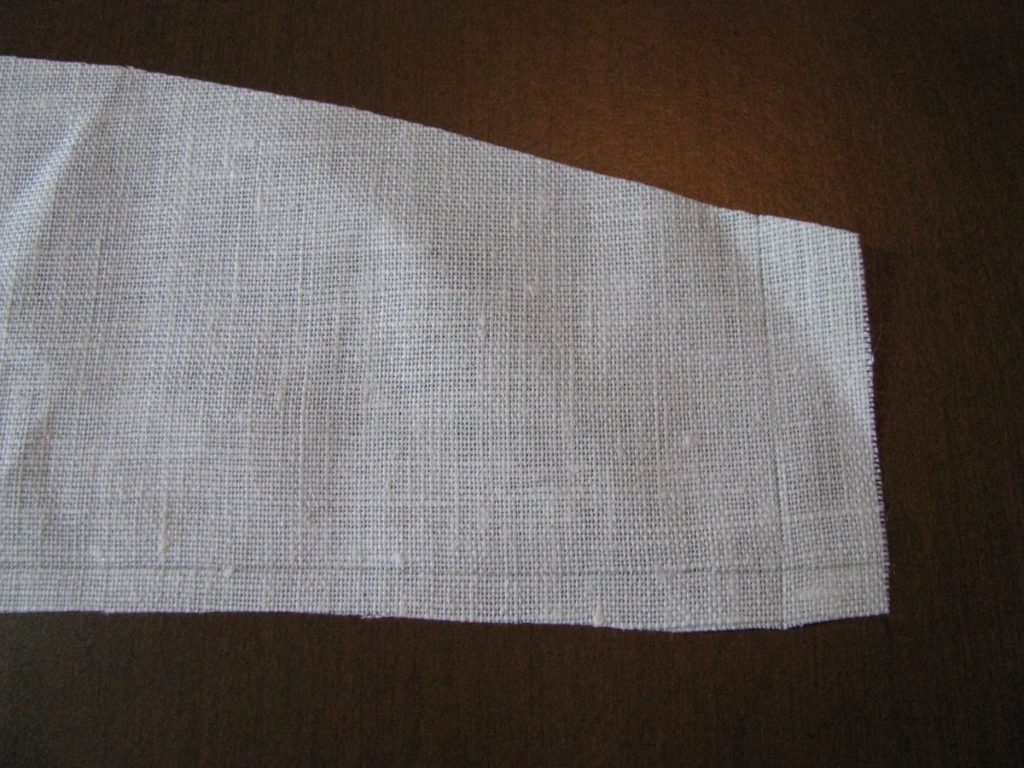
Also very important, is to transfer the roll line to the collar. I find it’s easiest to just cut the pattern in half along the roll line and use that to mark it on the under collar.
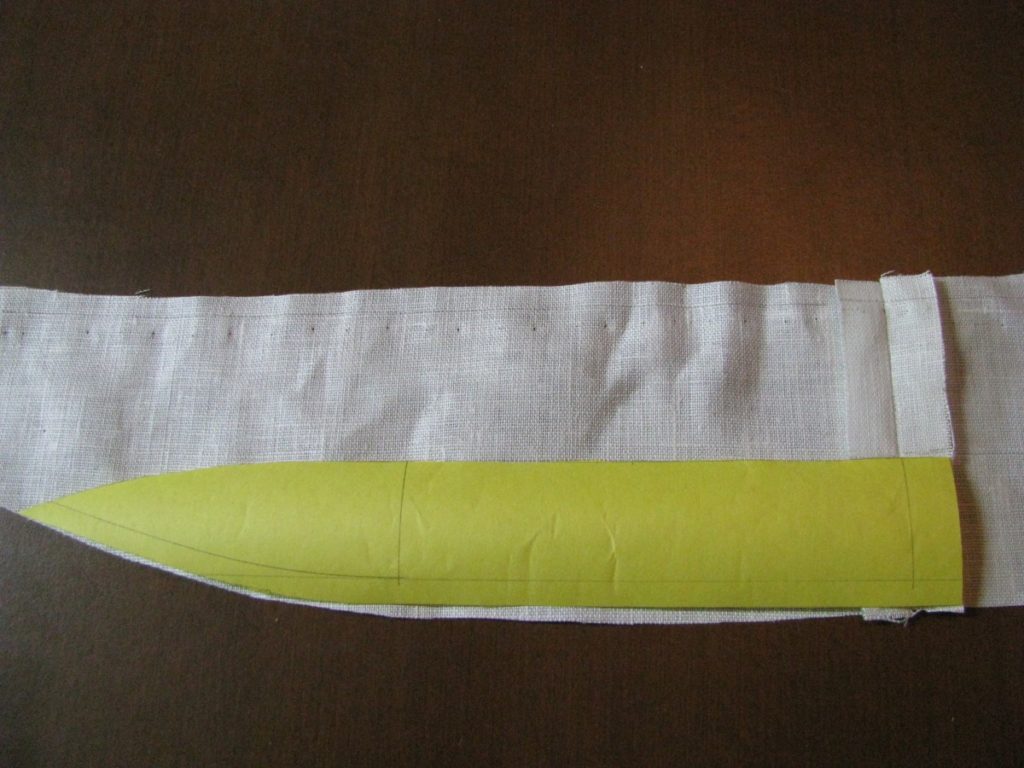
Mark the under collar more securely in thread, so that it shows through to the right side.

With right sides together, line up the curved bottom seam of the collar with the neck seam at the center back.

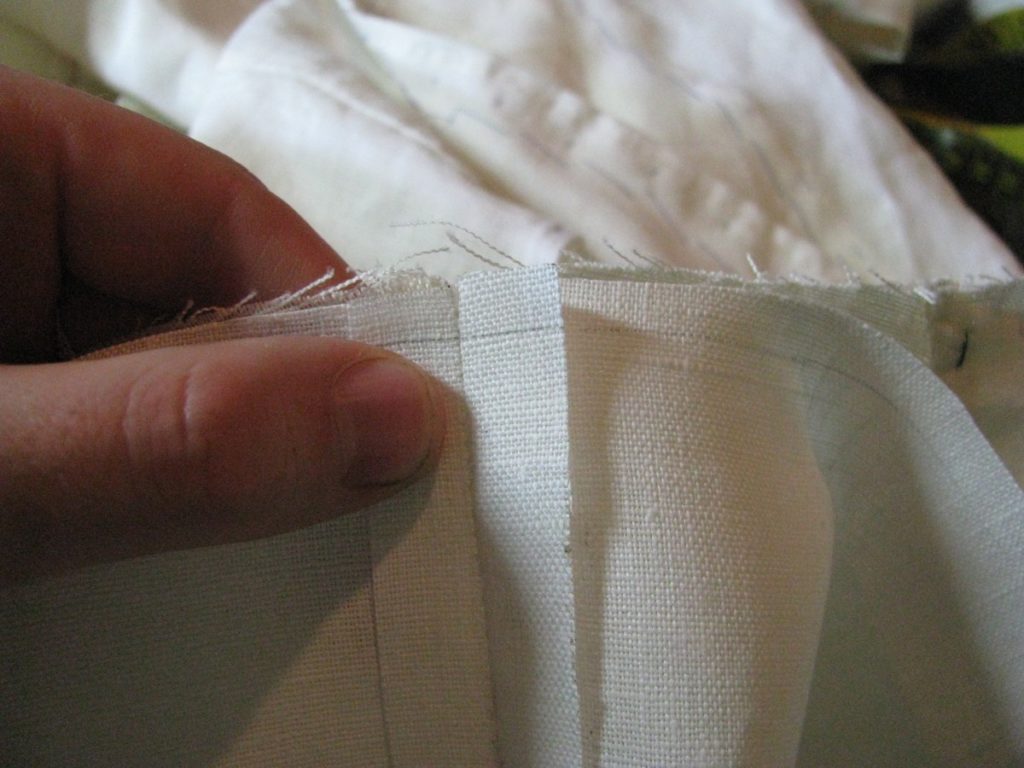
Baste securely together, starting at the center and working your way out (the direction depends on if you are right or left handed).
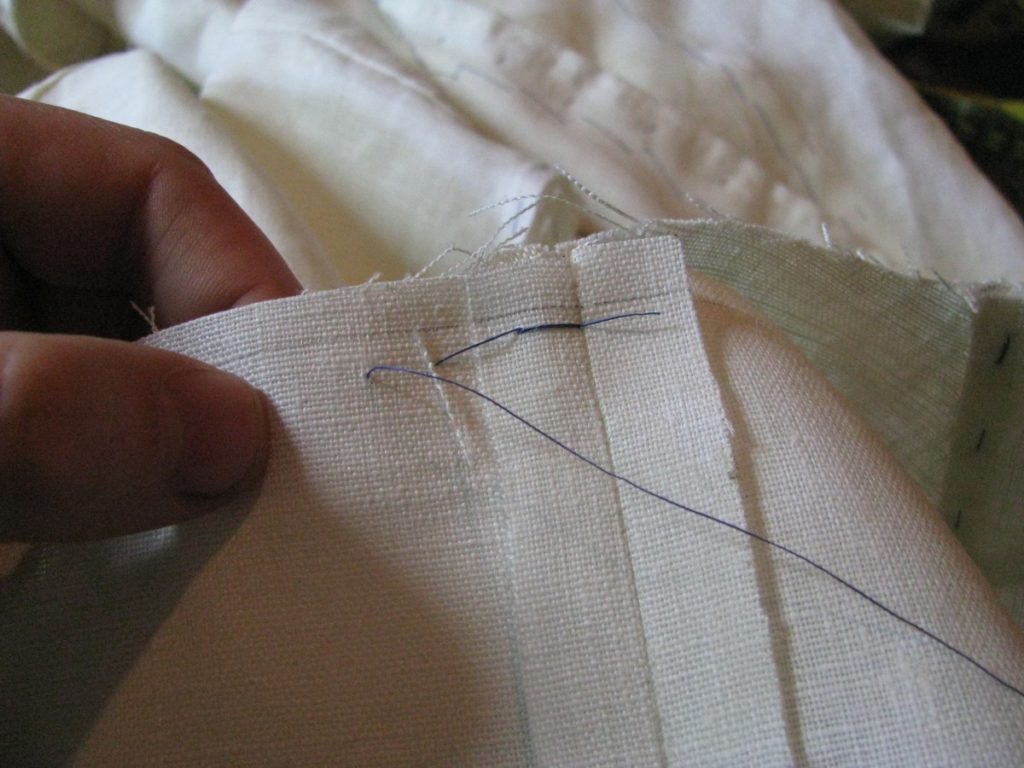
As you get to the curved part of the neck seam, you’ll find that the collar will naturally full itself in with about 1/4 – 1/2″ of extra fabric. This will help the collar roll properly.
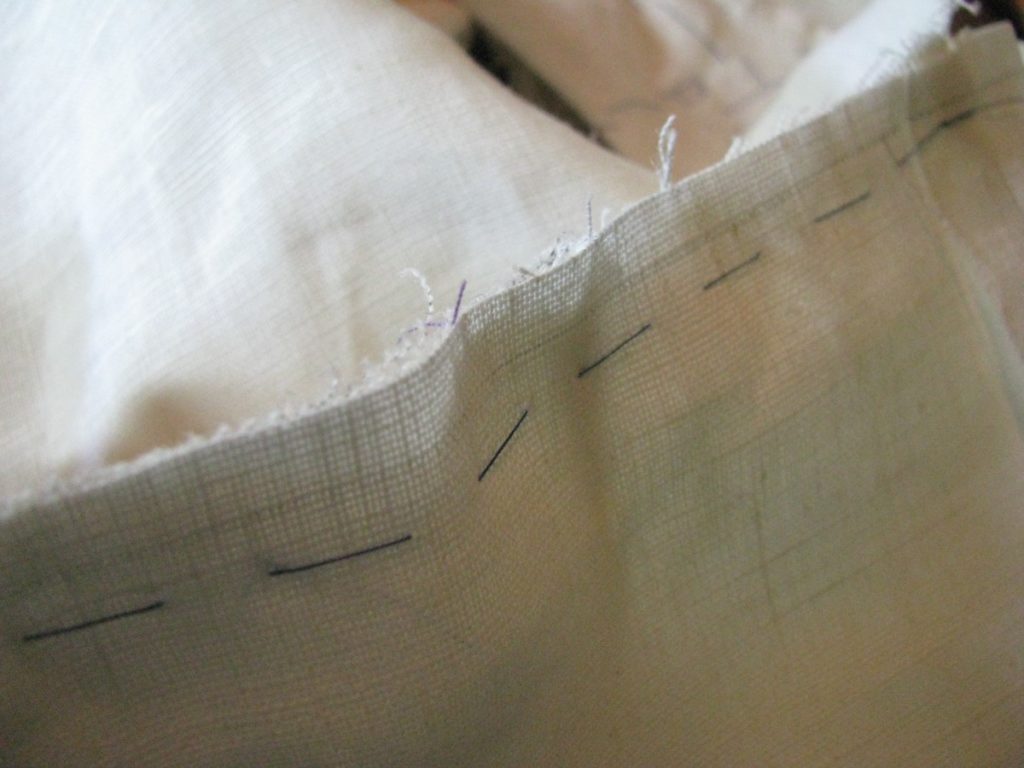
The most crucial point of the entire process, you want to make sure that the roll line of the forepart and the collar align exactly, 1/4″ from the edge.
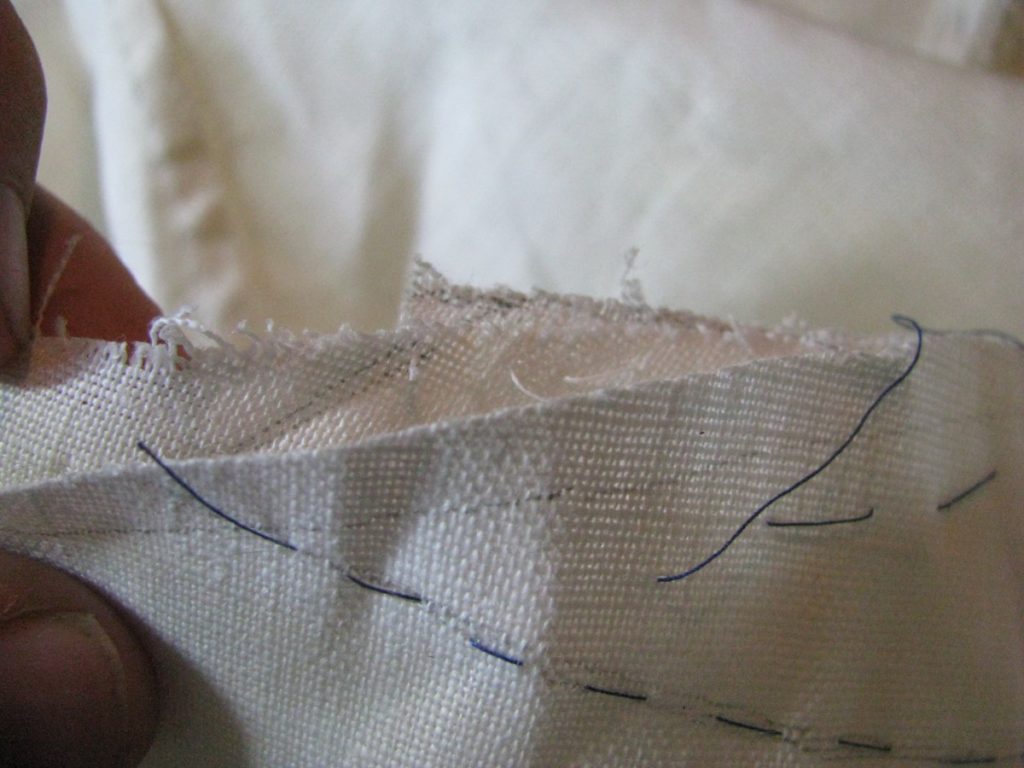
Continue basting to the front edge of the collar, aligning the cross hairs of the seam allowance with the top of the lapel dart directly underneath.
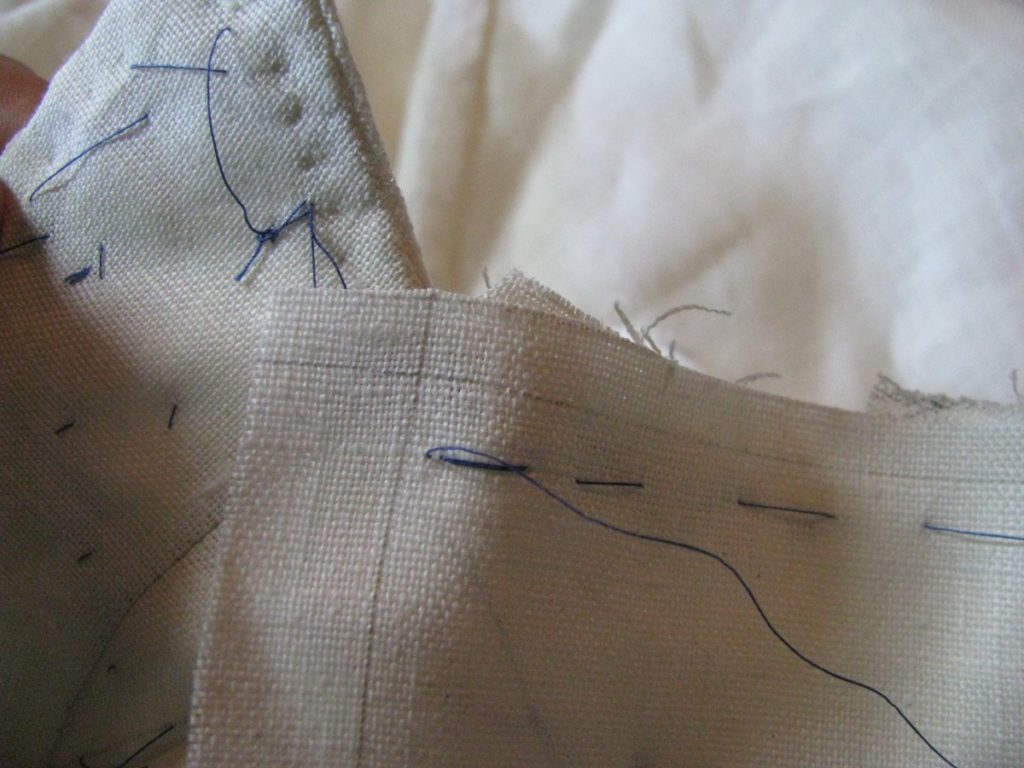
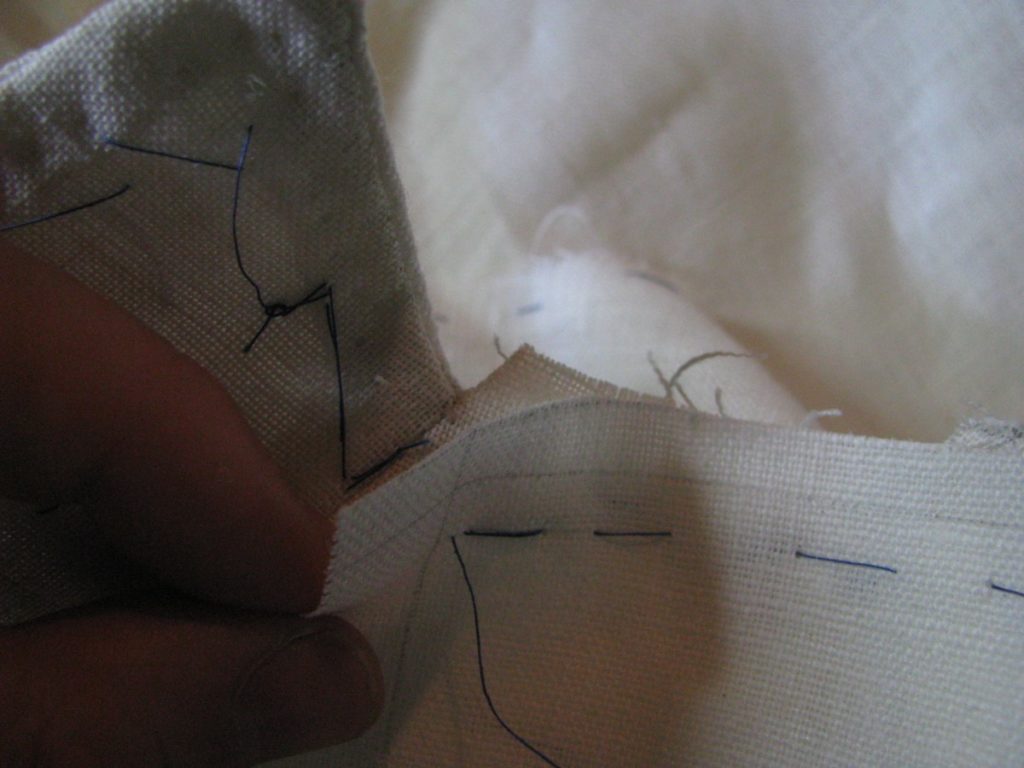
Repeat the basting process for the other half of the under collar. Here’s what the entire under collar should look like when basting is complete.
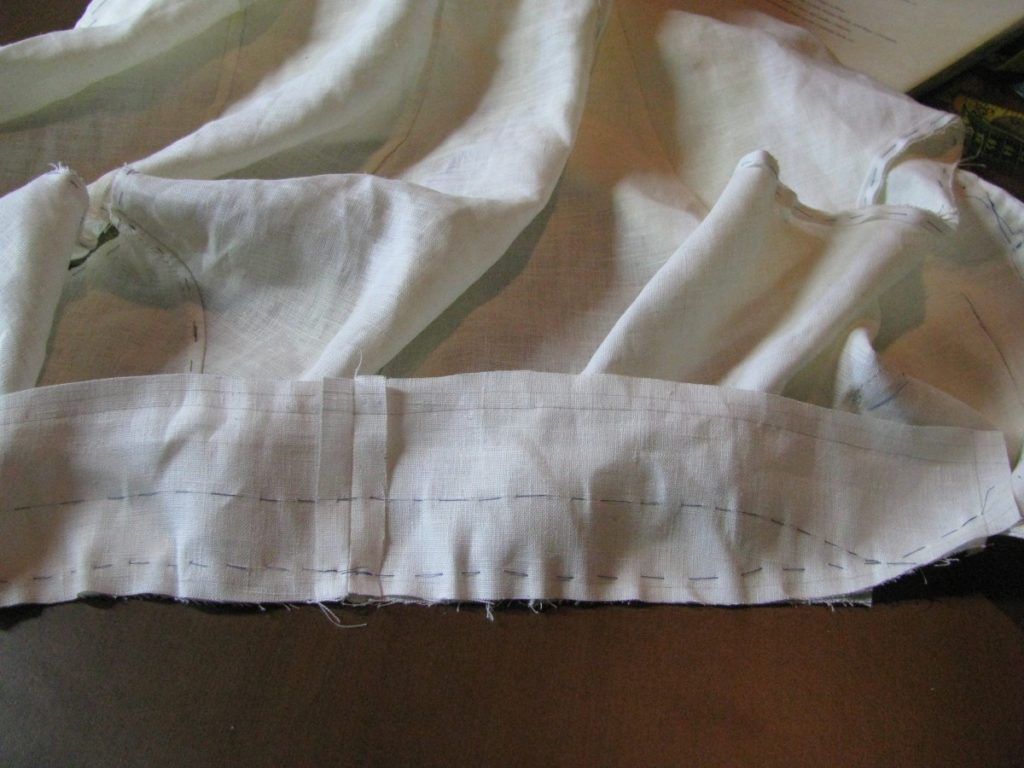
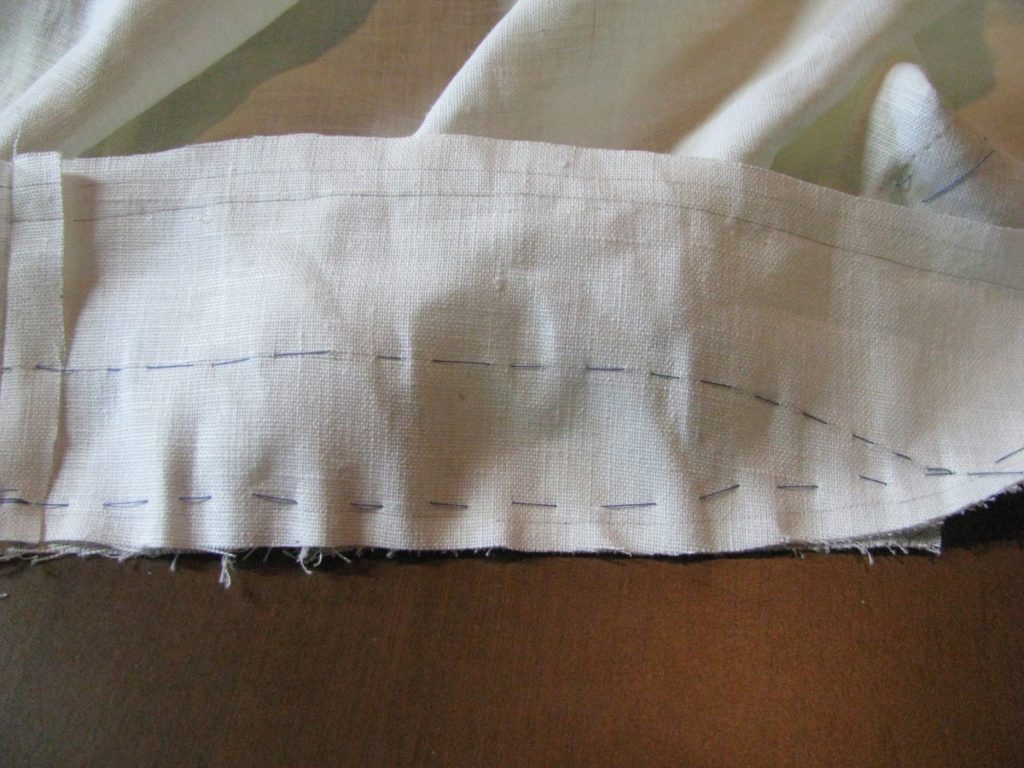
Beginning on one edge of the collar, at the crosshairs formed by the seam allowance, use a back stitch to secure the collar to the neck of the coat. At each end, it’s a good idea to reverse the back stitching on itself to give an extra secure finish to the ends of the collar.
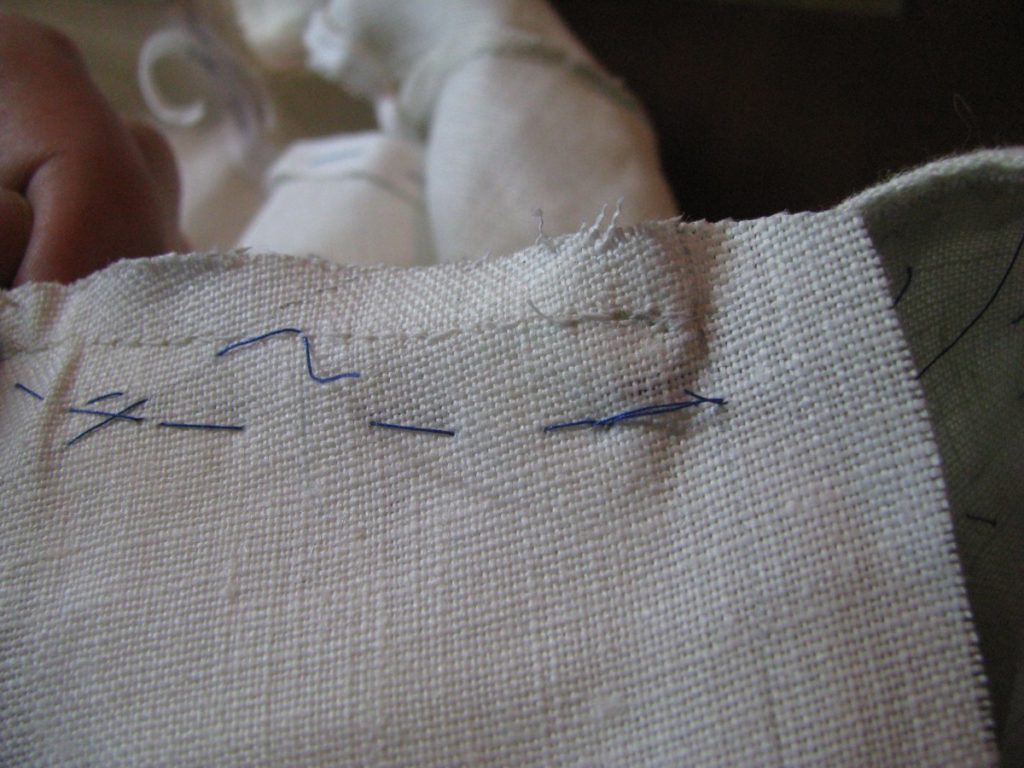
Backstitches continued along the center back.
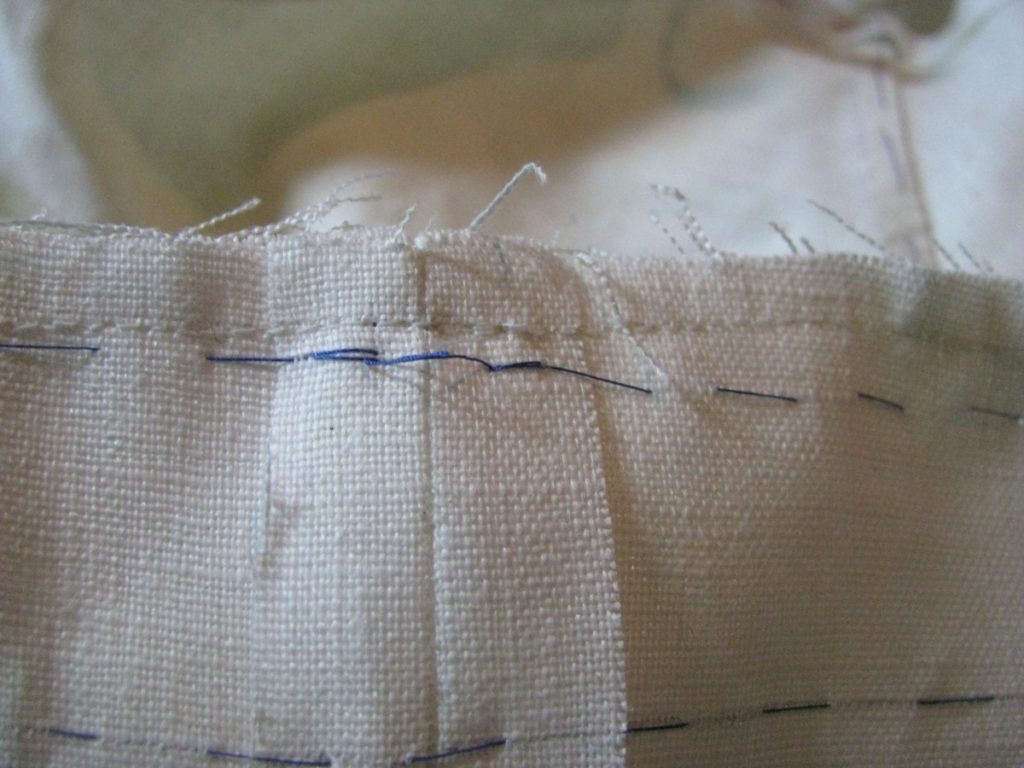
And finishing up at the other side.
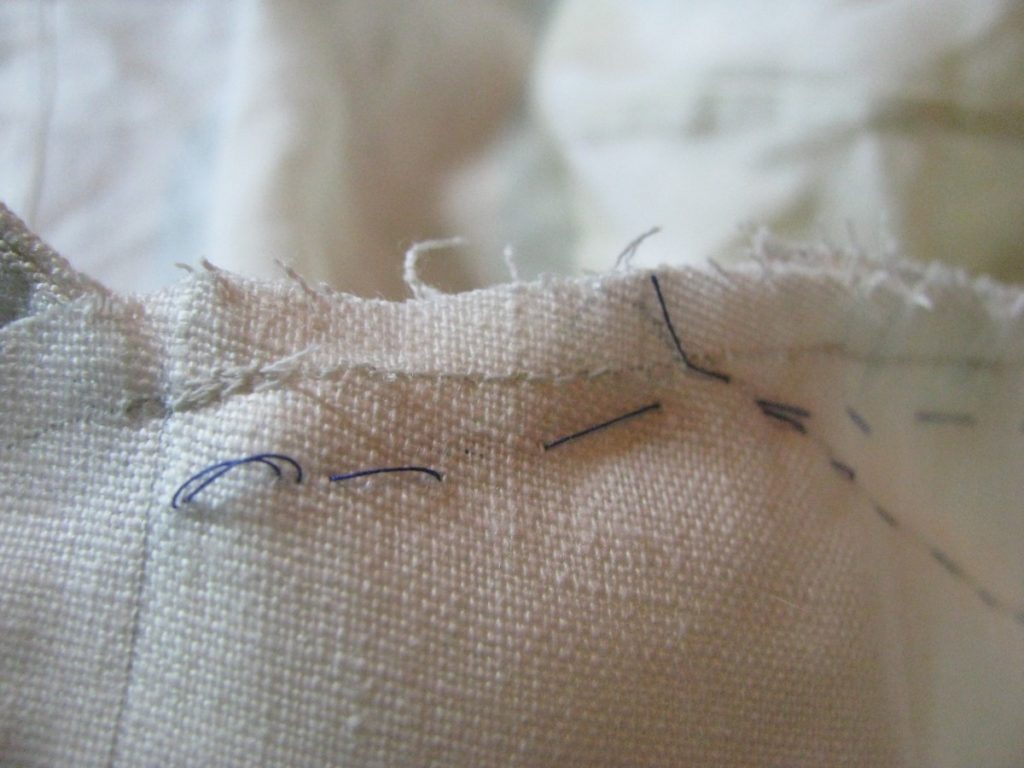
Using a tailor’s ham, press the collar upwards along its entire seam. Note here how the roll lines align perfectly between collar and lapel. If they’re off, you’ll have issues trying to get things to lay properly.
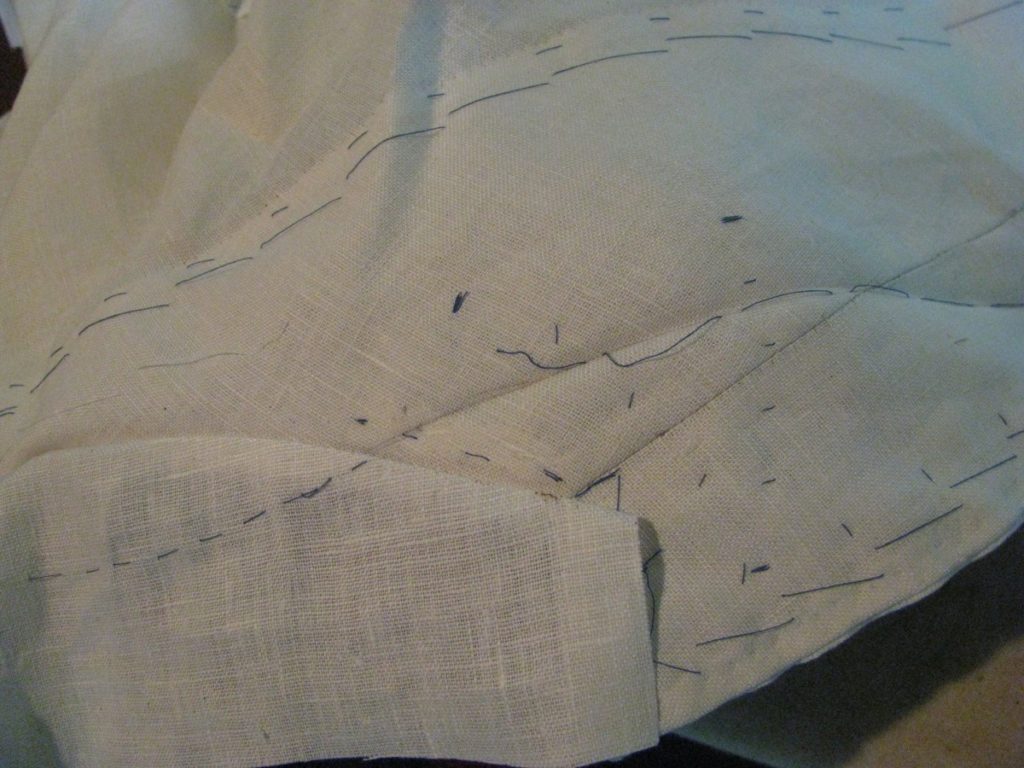
Here’s a view of the inside of the coat showing the back seam, shoulder seam, and center back of the collar, and how the seam is pressed up towards the collar – not opened up.
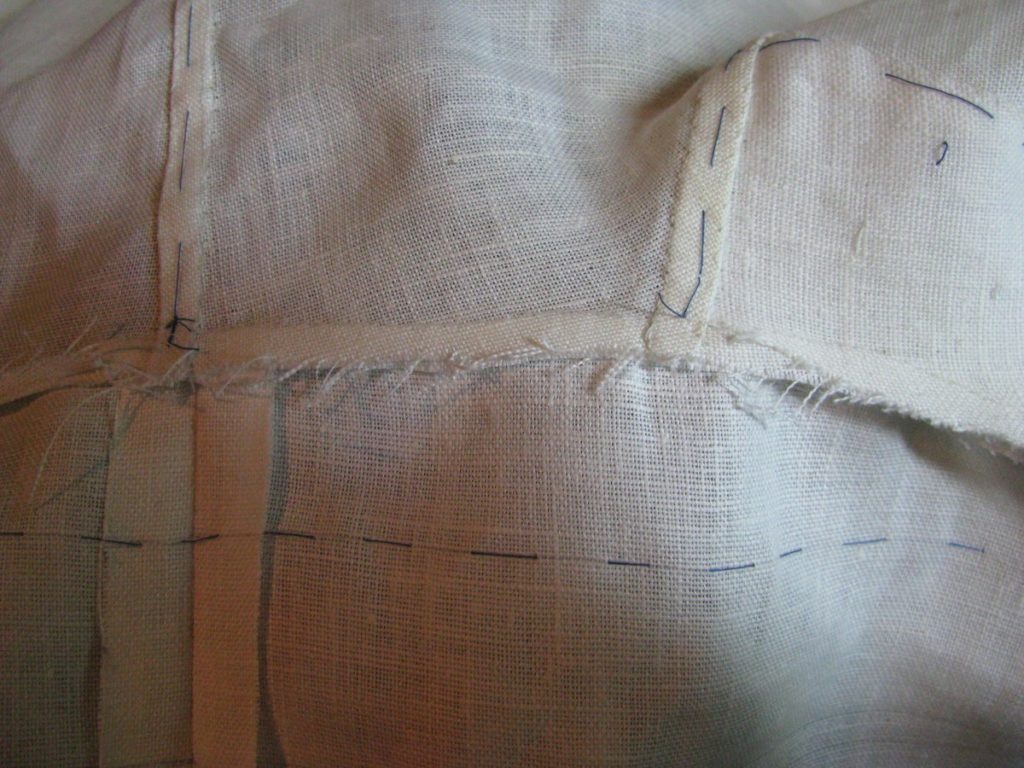
Drafting the Collar
The first step in drafting the collar is to draw the baseline. This should be 10 graduated inches in length, or the length of the collar from the collar notch (edge of the neck dart) to the neck and shoulder point, plus the width of the back neck.
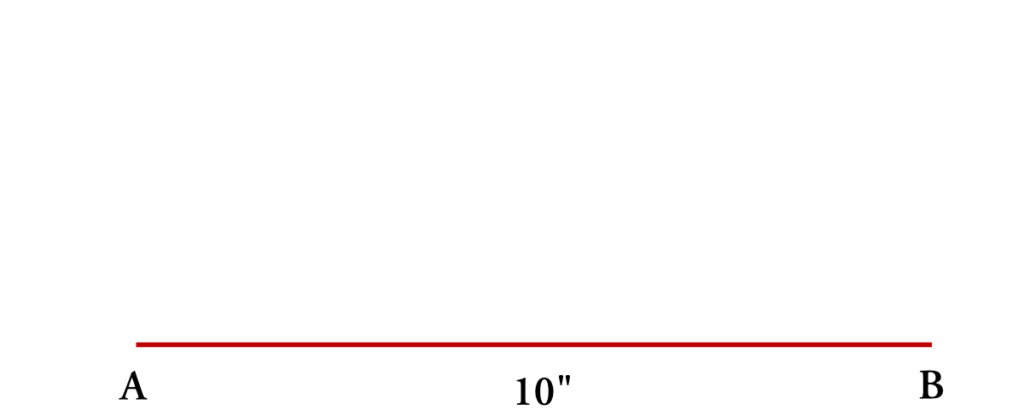
The next step is to square up from points A and B, and mark the appropriate distances. These are subject to fashion – Devere’s 1866 manual gives 1 1/4″ height for the collar stand, and 3 3/4″ for the collar fall. For an earlier type collar, say from the 1850s, Devere recommends 1 1/2 for the fall and 4 inches for the stand, giving a much higher collar.
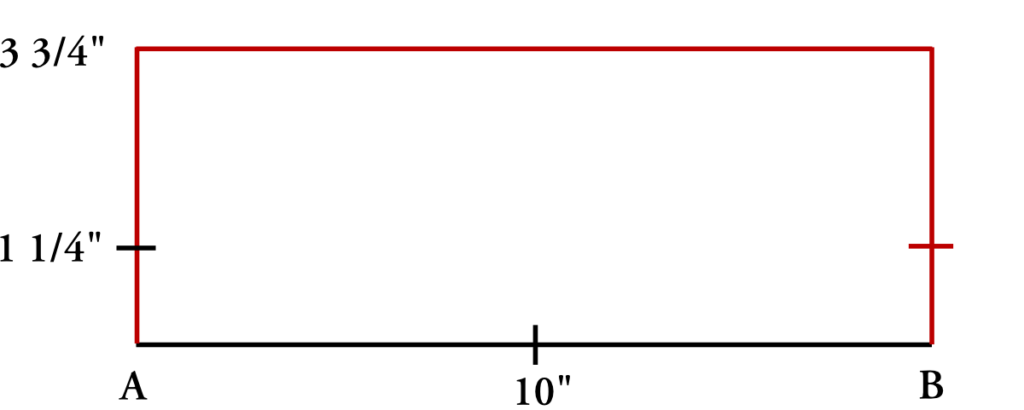
Mark halfway between A and B. Draw a curved line from the mark at 1 1/4″ to this halfway mark. This is giving some curvature to the collar, which will give tension to the area and help it stand properly.
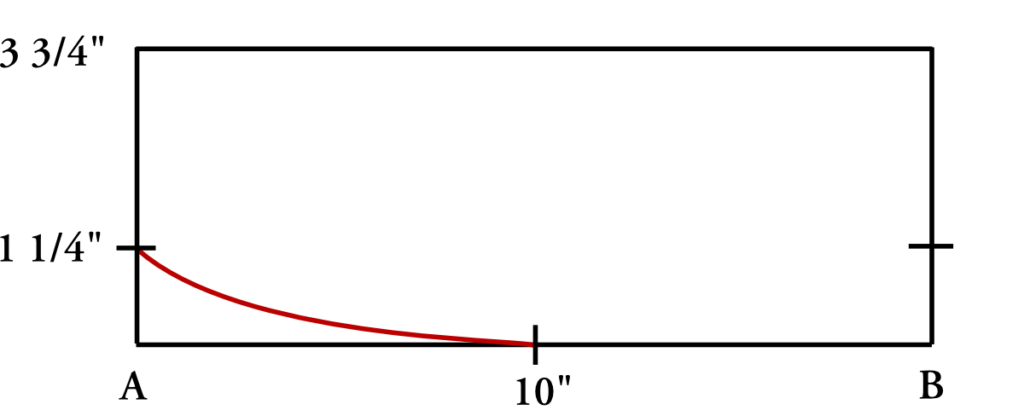
Next, measure the distance from the collar notch to the roll line. Measure that distance out on the curved line, and from there, draw the rest of the roll line on the collar. At about the half way point, the curve of the roll line straightens out.
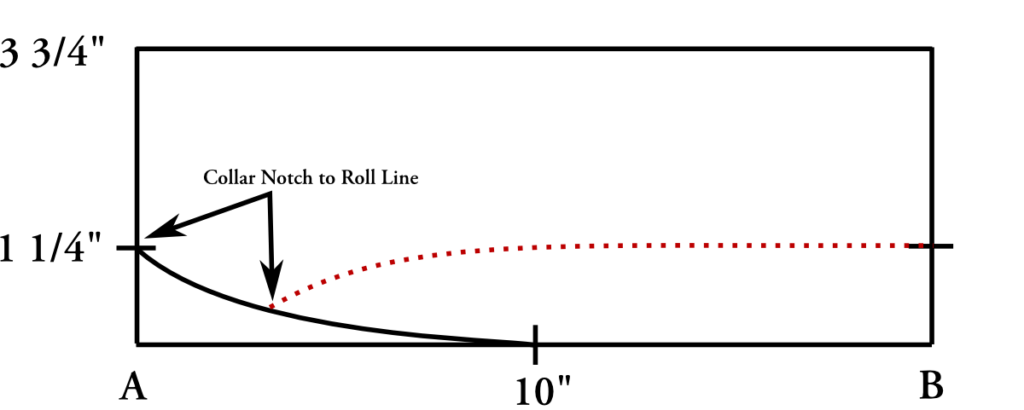
Seam allowances are added all around for the undercollar. The canvas is cut the same size as the pattern, and the top collar has 2 inches seam allowance all around.
Long Turn of the Collar
If you have a high buttoning coat, you will have to edit your collar pattern slightly. This is due to the fact that more fabric is needed on the outside to get around the longer curve.
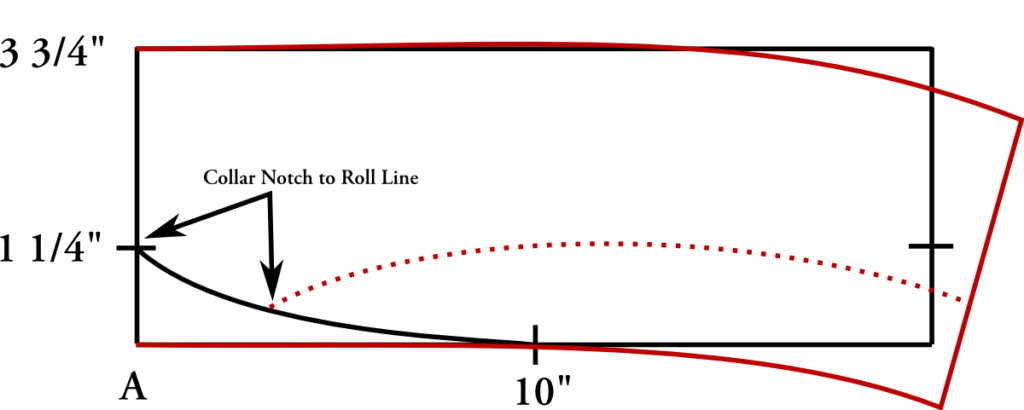
To do this, move point B downwards, up to half an inch, and to the right, about 1/4 inch. Form a right angle from the new baseline at B, which will curve outward now. Measure up the appropriate distance, and redraw the top of the collar. Also be sure to redraw the roll line on the collar, it must curve as well.
Short Turn of the Collar
On the other hand, if your coat buttons rather low, the curve will be less severe at the collar, and you will need less fabric there. Raise point B up to half an inch and outwards slightly, redrawing the bottom seam in pretty much a straight line. Draw a right angle up the same distance as the original collar, and redraw the top curve as shown. Redraw the roll line as well.
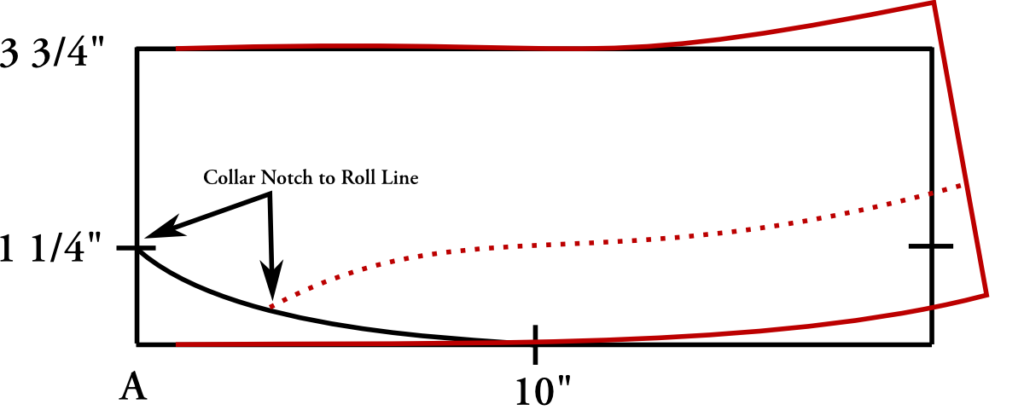
For Both of these instances, there are no set numbers on how far to adjust the collar. Rather, it’s up to your fitting skills, which will only get better with more practice. Usually 1/4 – 1/5″ will suffice for the alteration. I highly encourage you to practice with some scrap canvas the different cuts of the collar, and see how they affect the fit of the coat.
The Back Facing
Before moving on to the collar and sleeves, it’s a good idea to get the back facing out of the way. This facing hides the top of the plait pockets and the vent, and also provides a little structure and stability to the back of the coat.
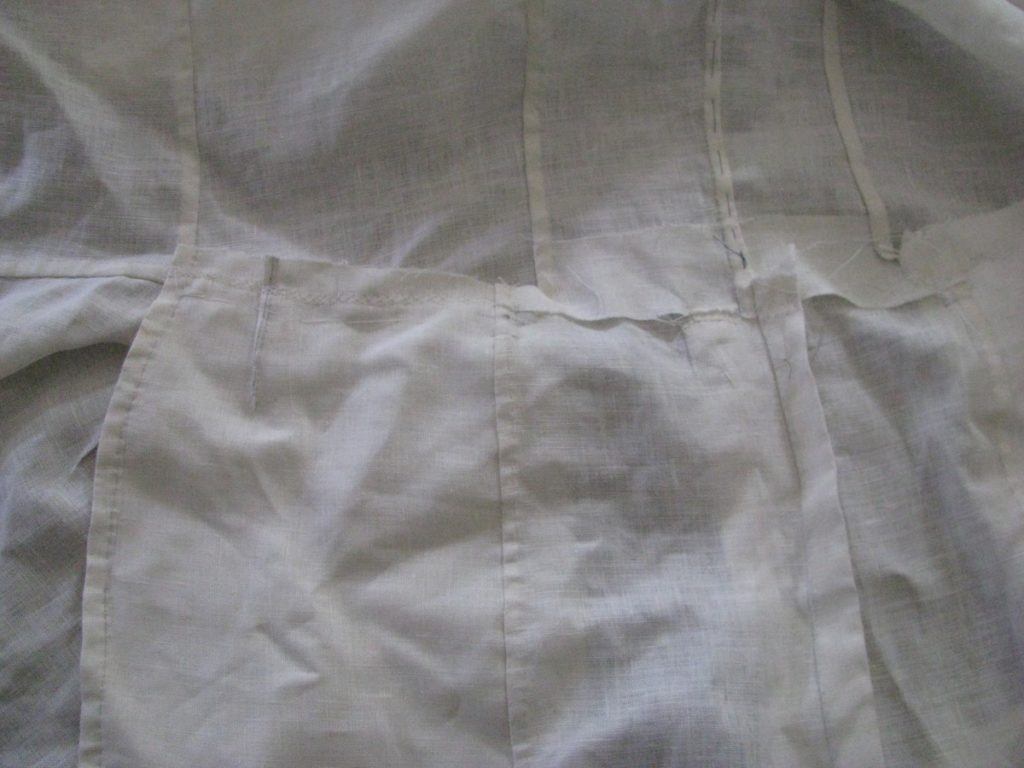
Begin by measuring the inside of the coat, from the center back, to the far edge of the plait pocket. Add 2″ or so to this measurement for seam allowances and for some extra room to work with. Also measure the height of the area that needs to be covered and add two seam allowances to that measurement.
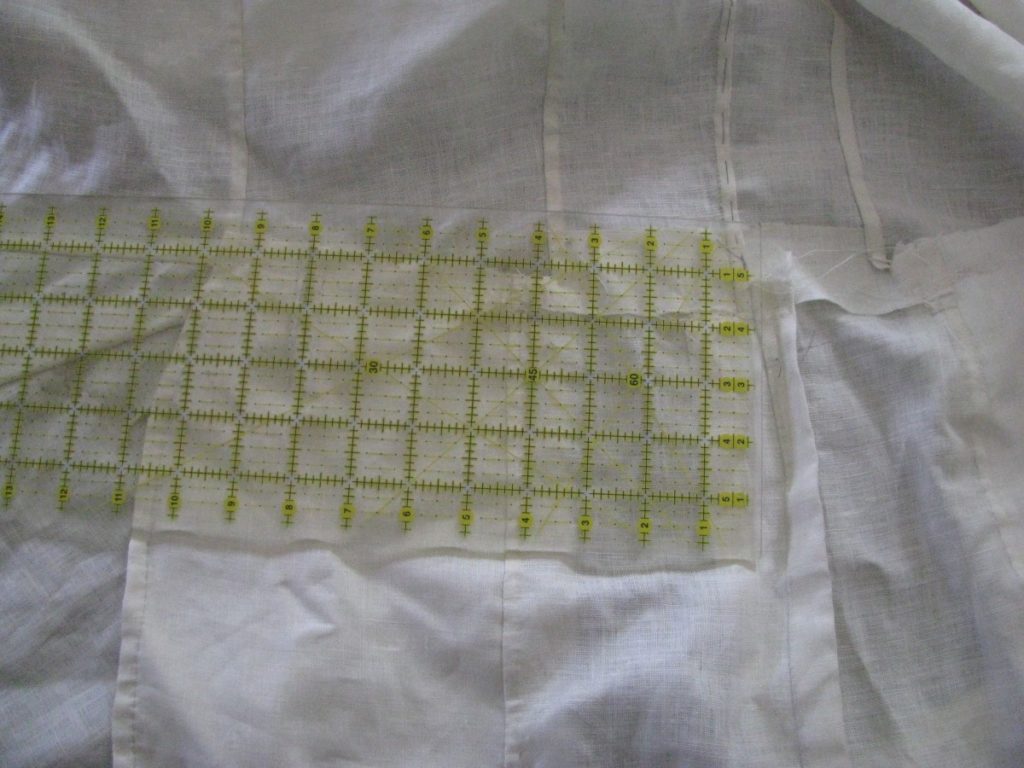
Using these measurements, cut out two facing pieces, one for each half of the coat. Mine turned out to be 3″ by about 13″ in length.
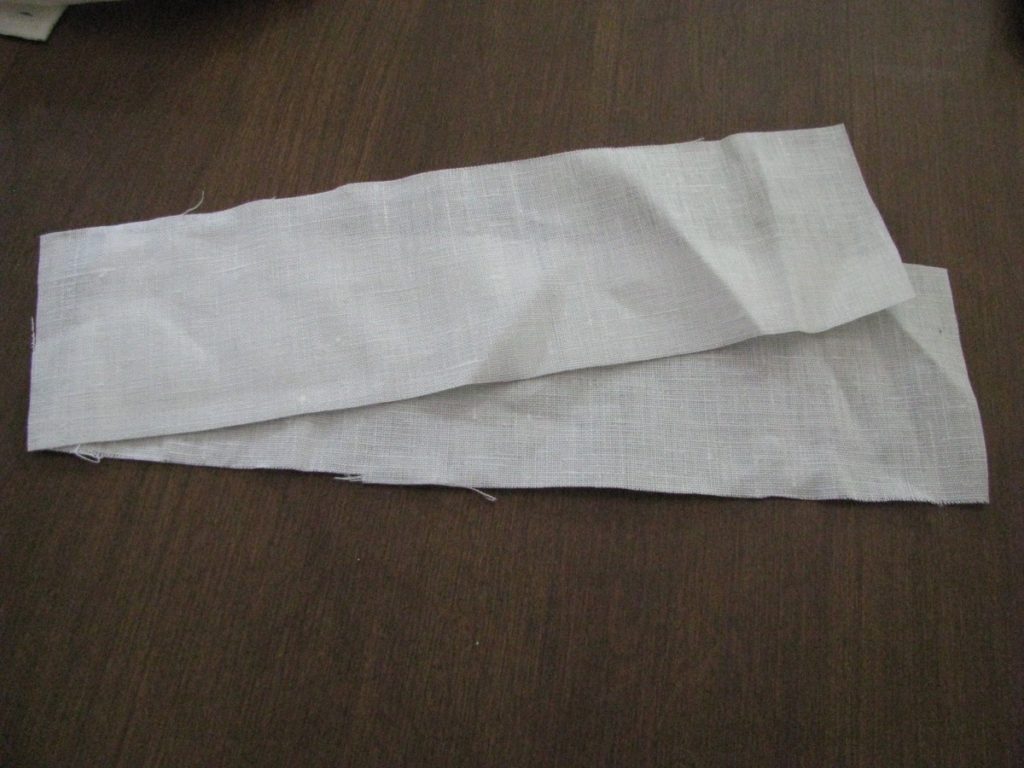
Place both halves together, and lay them on one half of the coat, covering the messy raw edges. When you’re happy with the positioning, lay a ruler along the back seam, and draw in the seam line for the back waist facing. It will most likely be at a similar angle to mine.
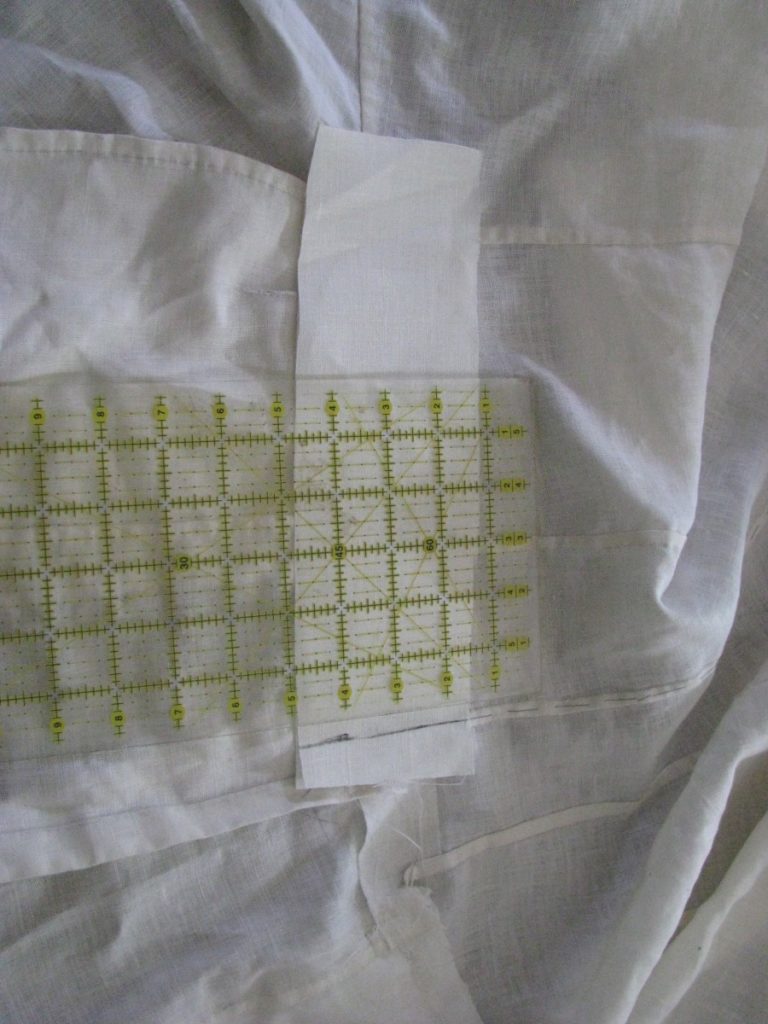
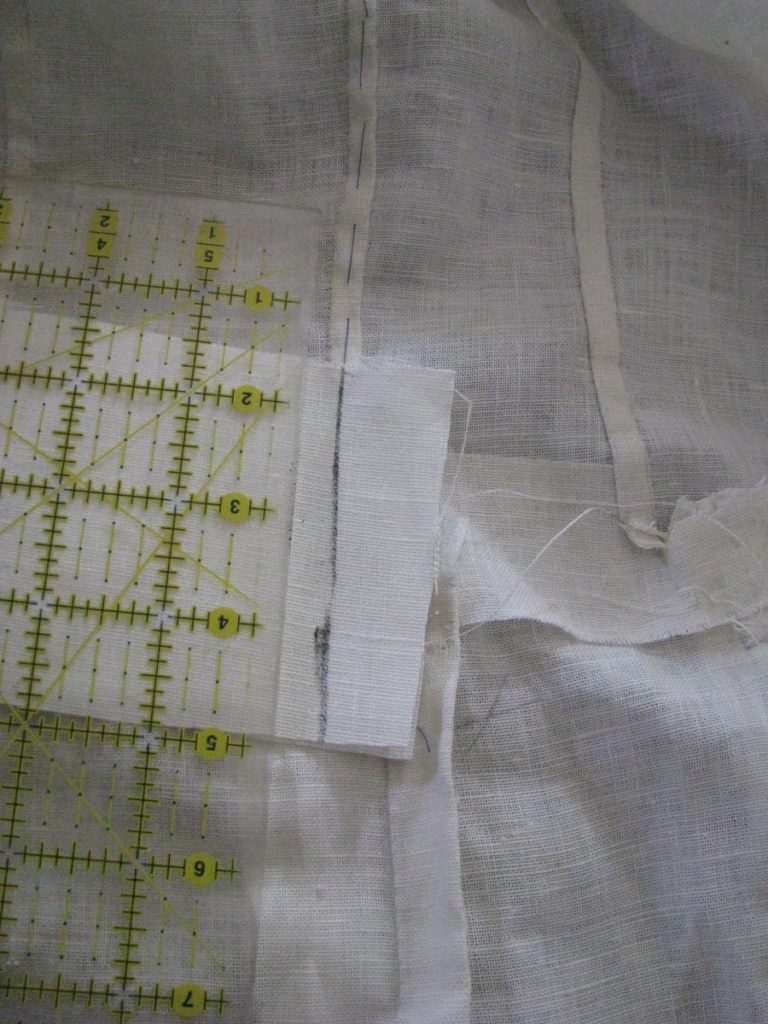
Stitch along this line with a back stitch, for extra strength.
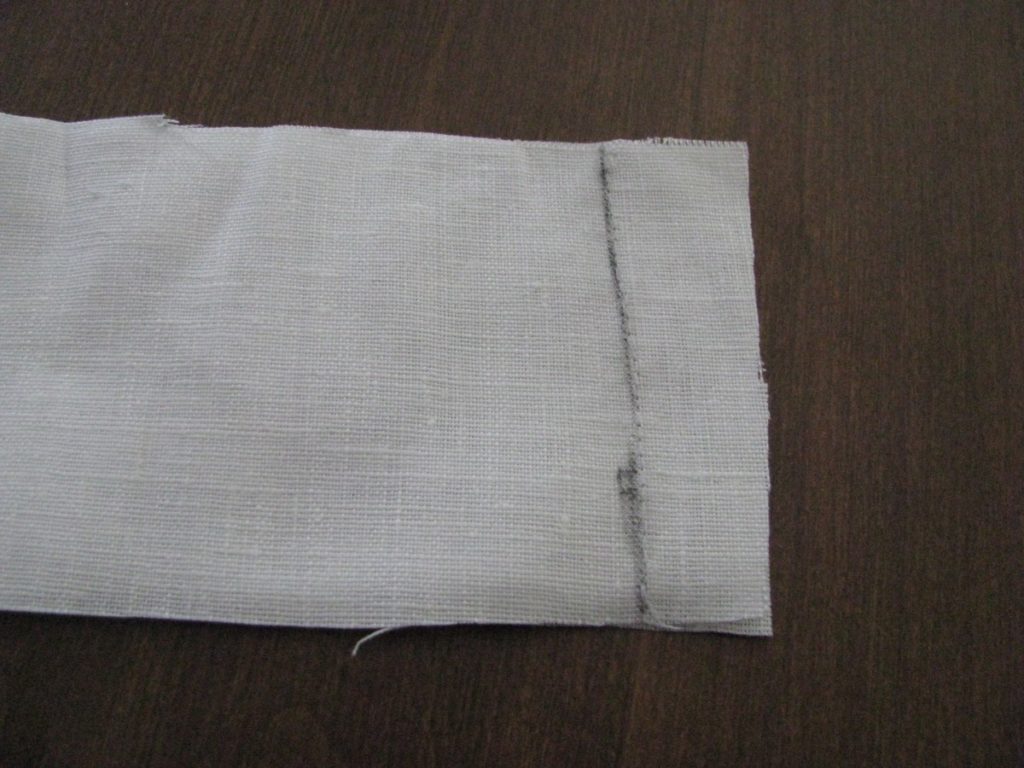
Trim the seam to 1/4″.
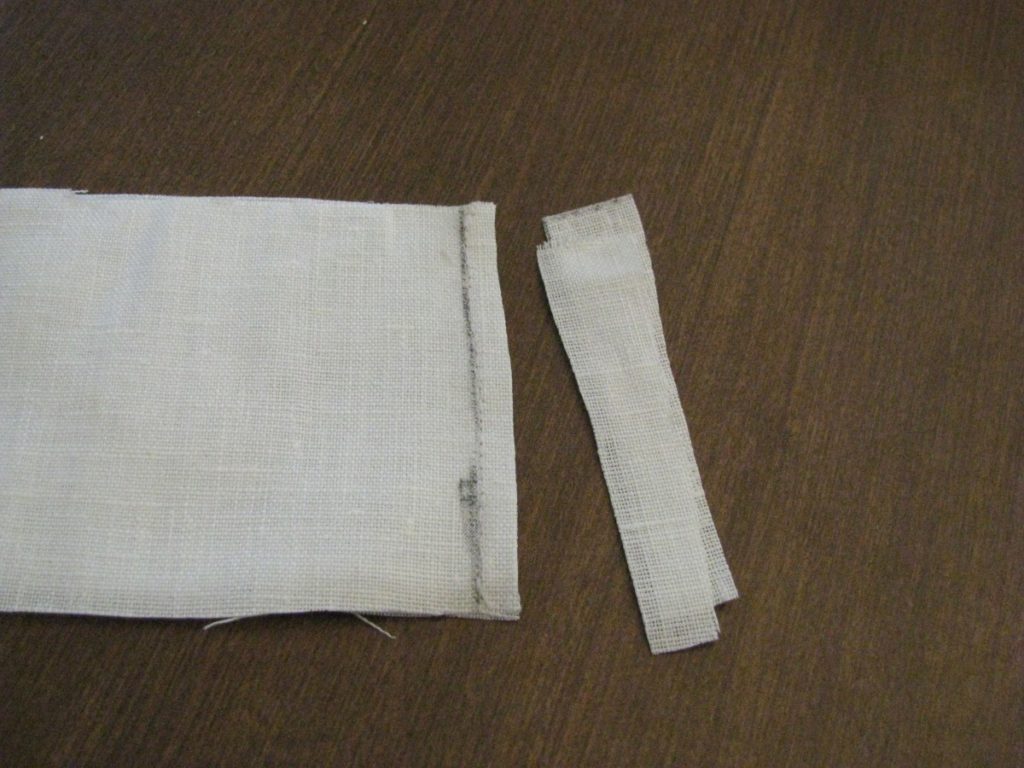
Press open the seam.
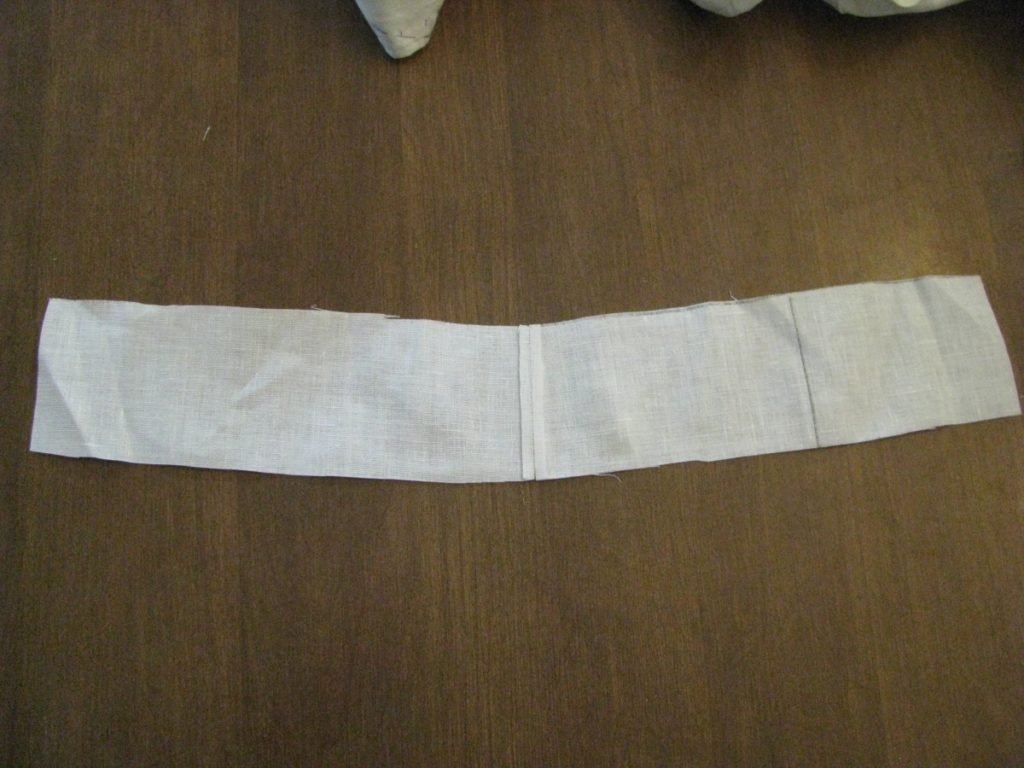
Lay the facing, wrong side down, on the inside of the coat, aligning the center line with the center back seam.
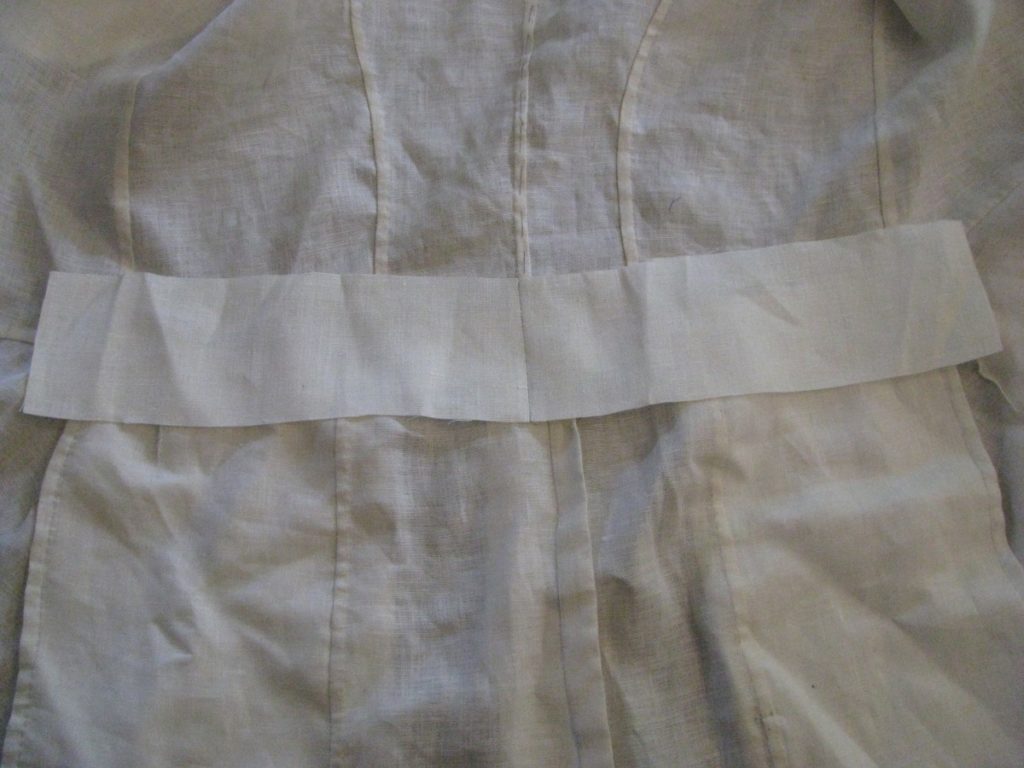
Baste from the center line, along the middle of the facing, towards one end.
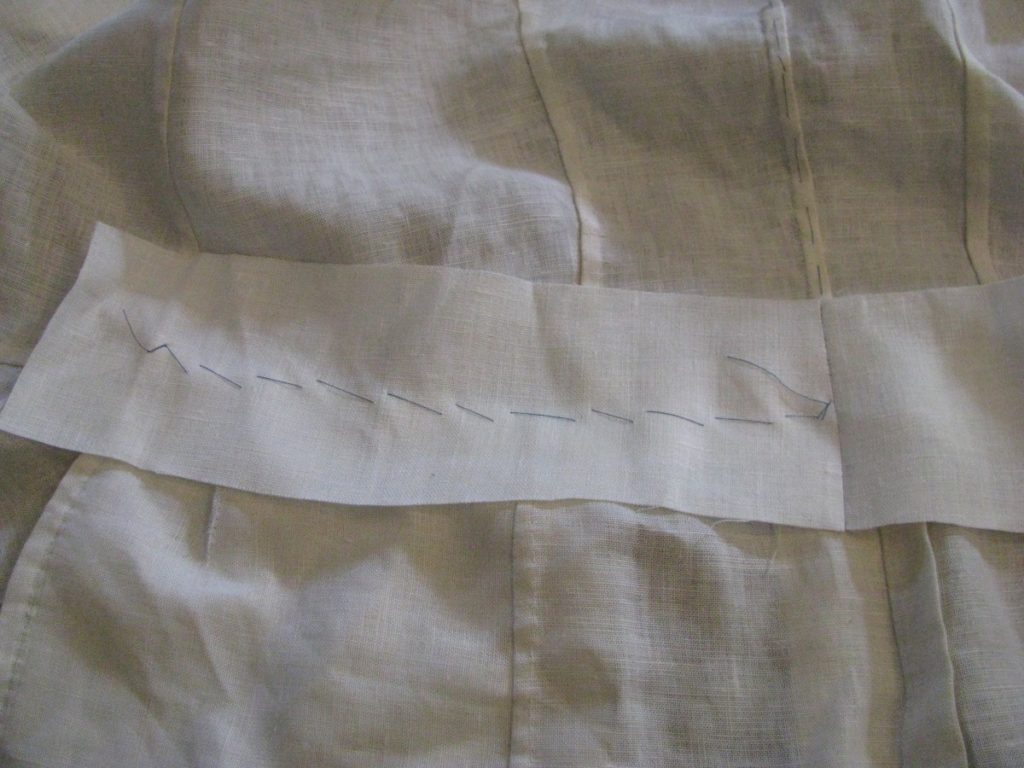
Repeat for the other side.
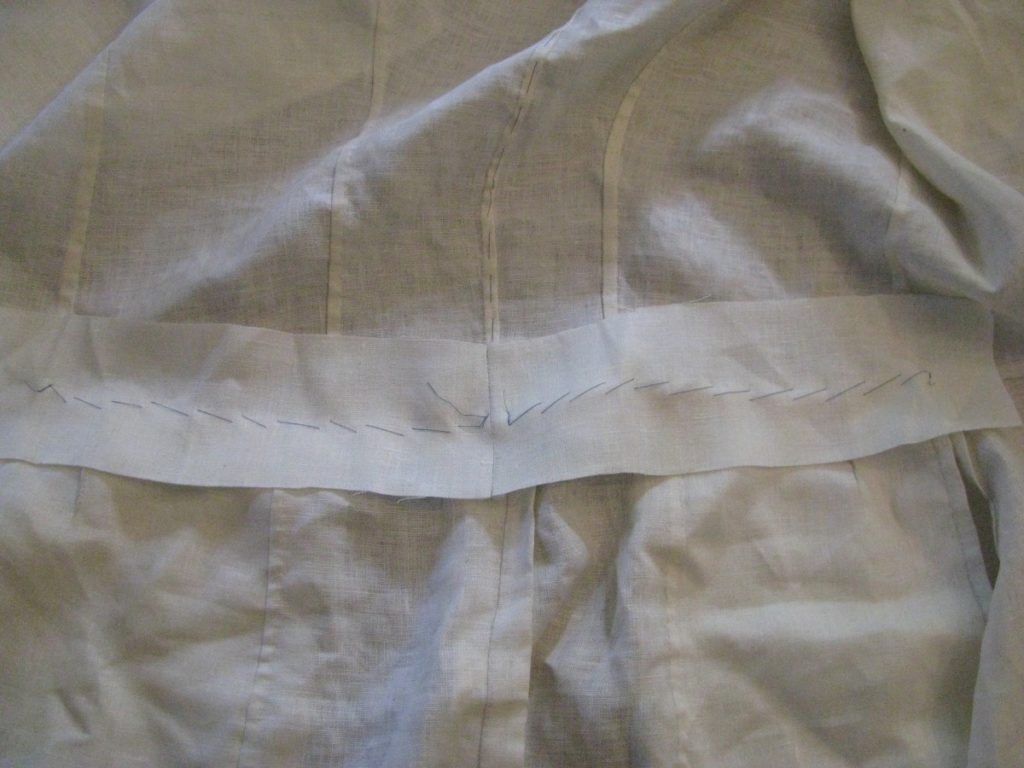
Fold under the raw edges and baste the facing down along the entire edge.
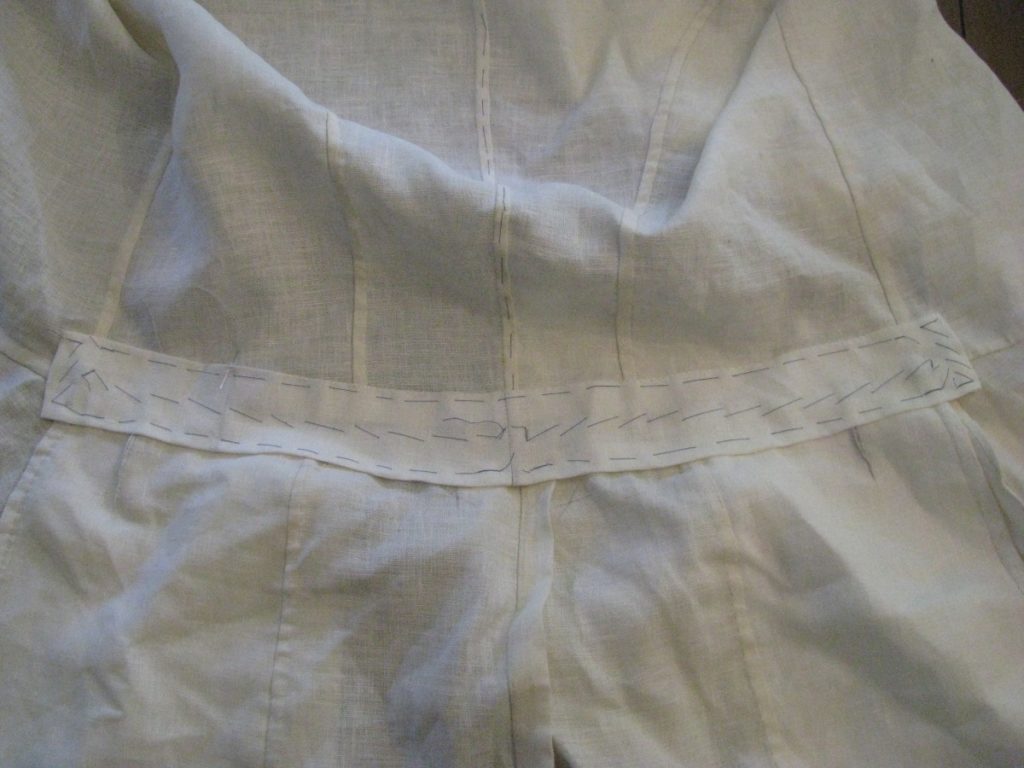
Using a felling stitch, fell the facing to the coat all the way around. Make sure you are only catching a couple of threads of the coat, as these stitches are visible from the outside.
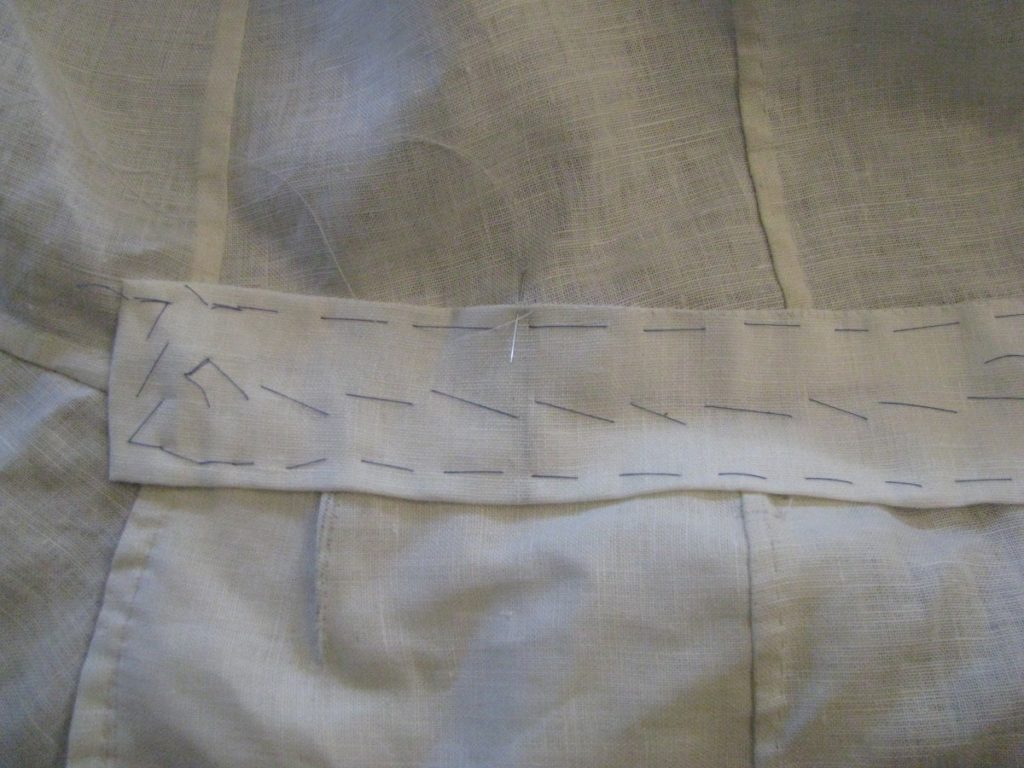
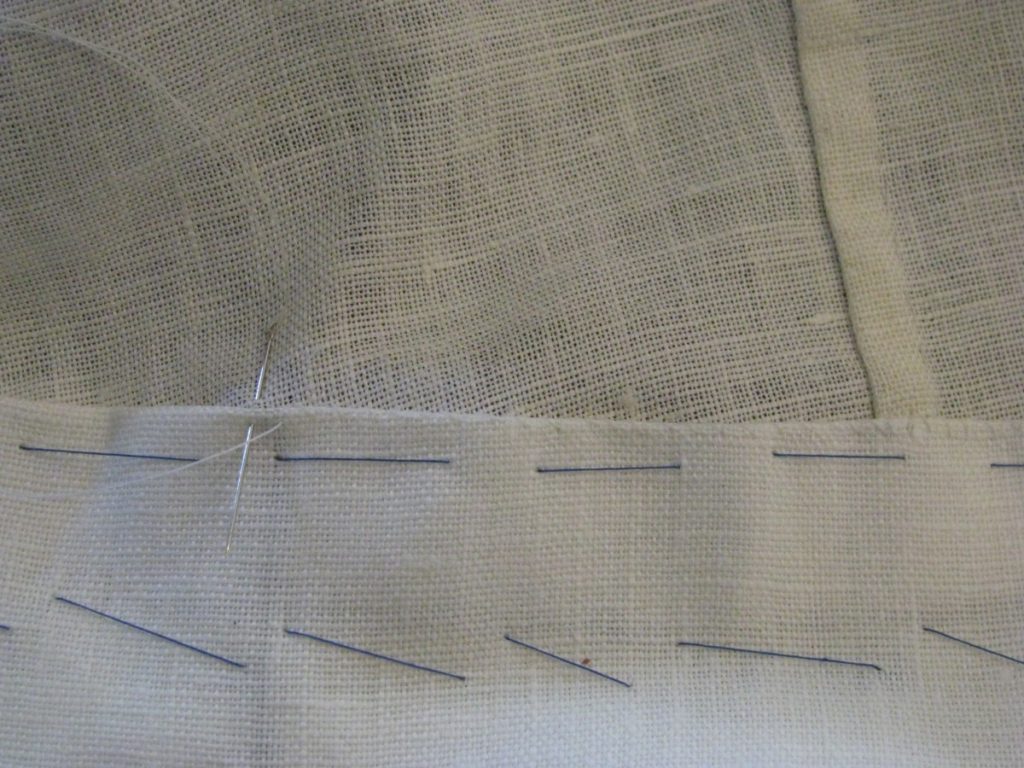
The Back Vent
As soon as you finish the back seam, you’ll want to immediately begin work on the back vent, to prevent any tearing in the area. The left vent should overlap the right side of the coat. The exact position can be very difficult to figure out. It depends on the wearer’s posture and sometimes the default position will leave gaps in the vent. So I highly recommend doing a fitting and getting the position exactly. You want both halves of the vent to fall parallel to each other.
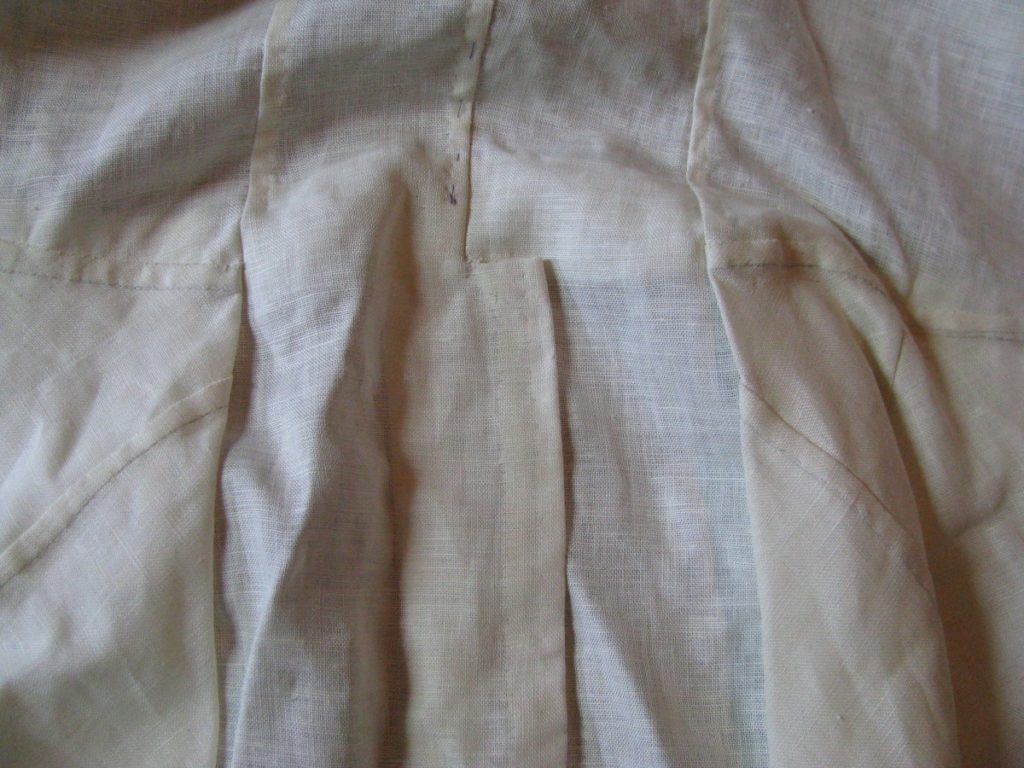
When you are happy, pin the vent in place and then remove the coat in order to baste more securely. Baste up the right side of the vent.
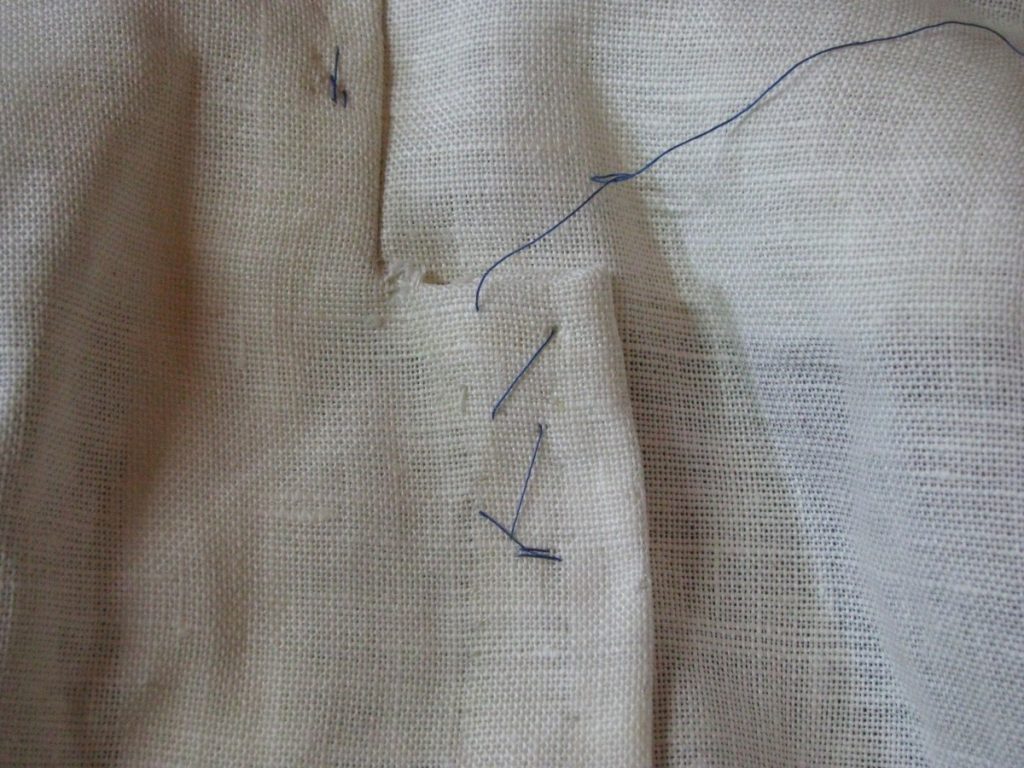
Across the top, and down the other side.
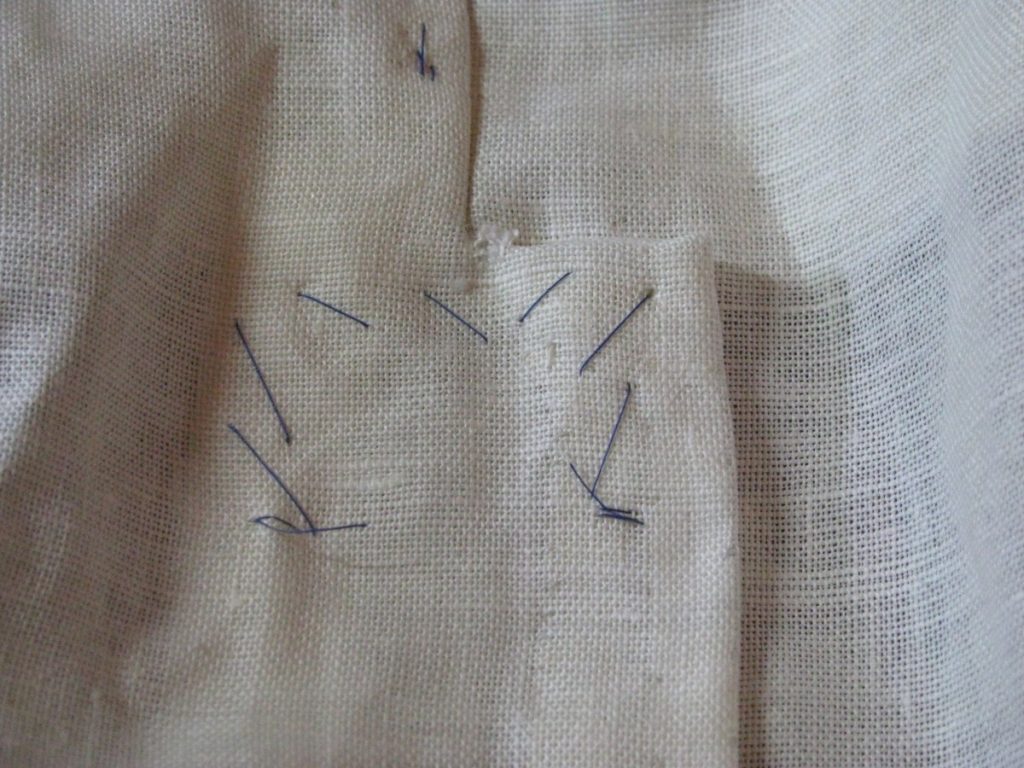
If you look closely, you’ll notice a little fraying at the inside corner of the vent. This is due to fraying during the construction process and not being accurate enough while sewing the back seam.
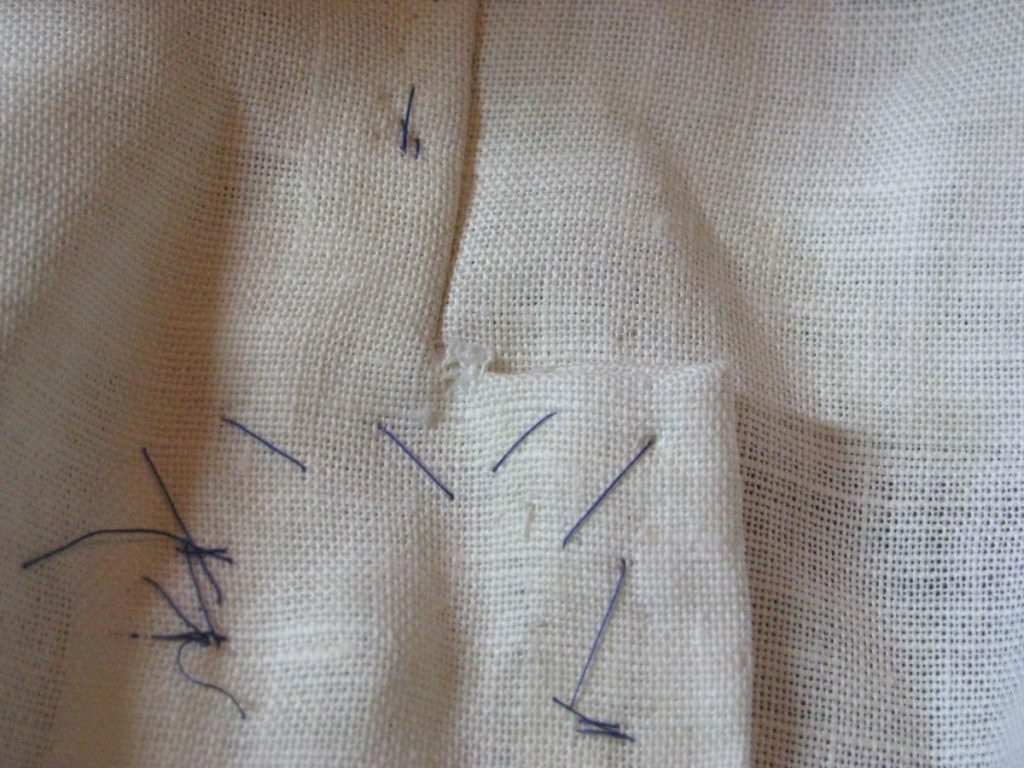
To fix this, and help secure the top edge of the vent, fell across the top edge of the vent, hiding any loose threads as you go. You can continue a short ways up the back seam if necessary.
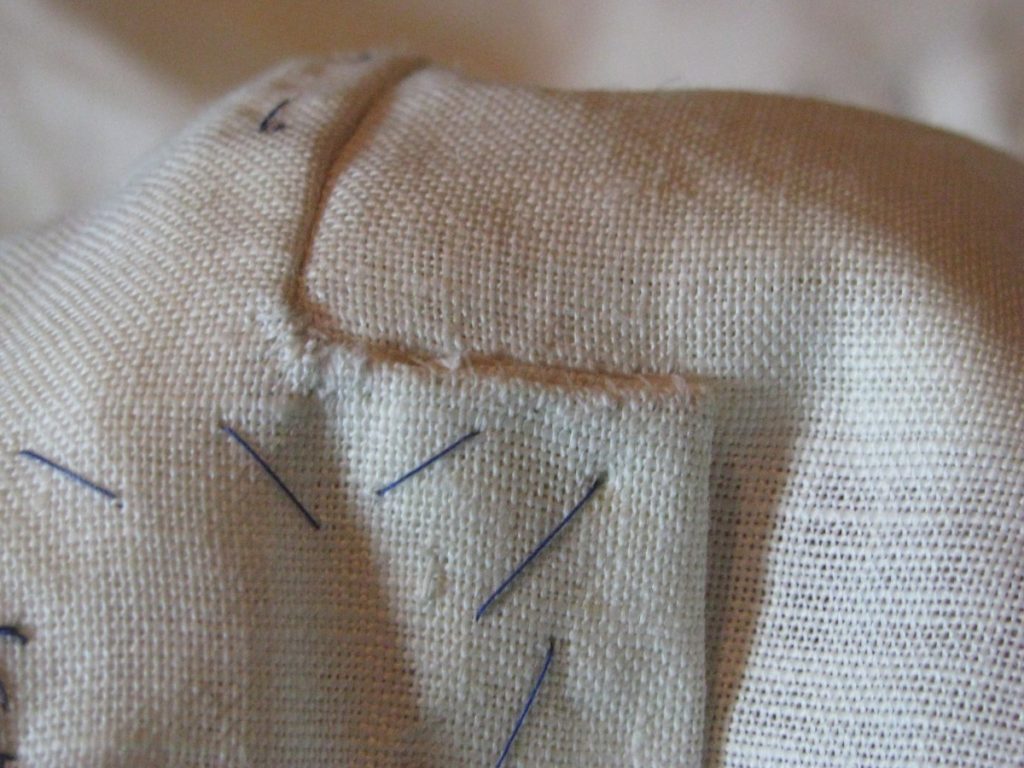
The back vent must now be top stitched to permanently secure it. I’m going to use a box stay here, which is probably most secure. Draw a rectangle just below the top of the vent. Mine is about 1/4″ in depth and slightly narrower than the vent in width.
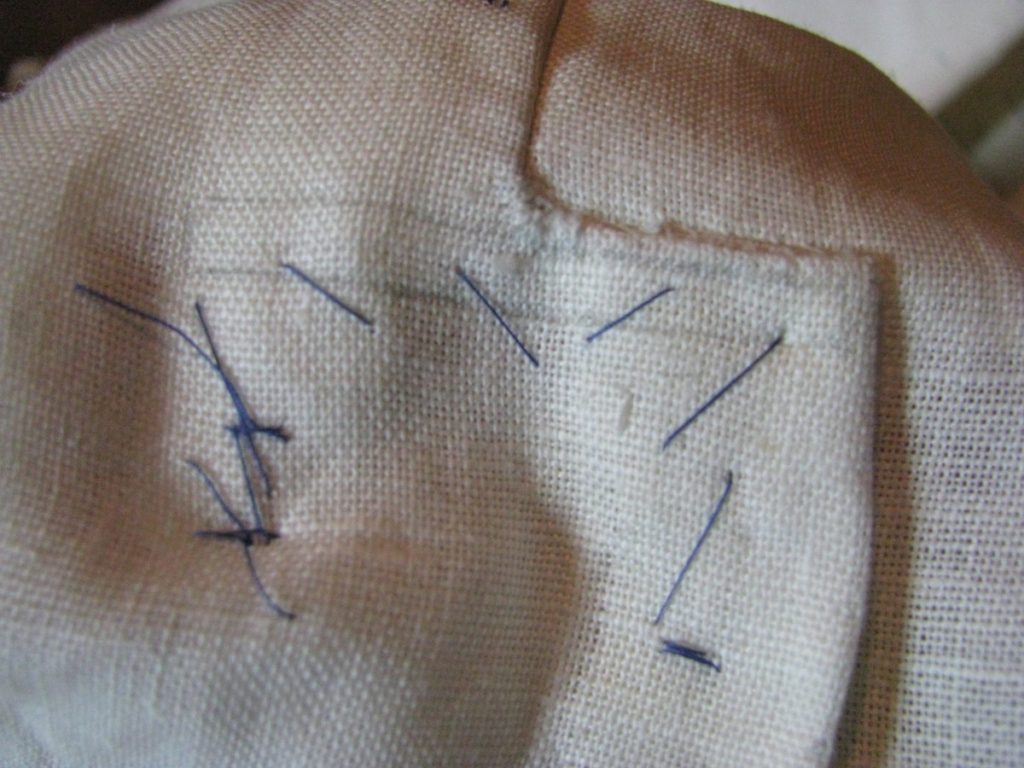
Using a side stitch, secure the back vent around the rectangle you just drew, using stitches about 1/8″ apart at most. On the right edge of the vent, fell the right edge of the vent from the top to the depth of the box stay.
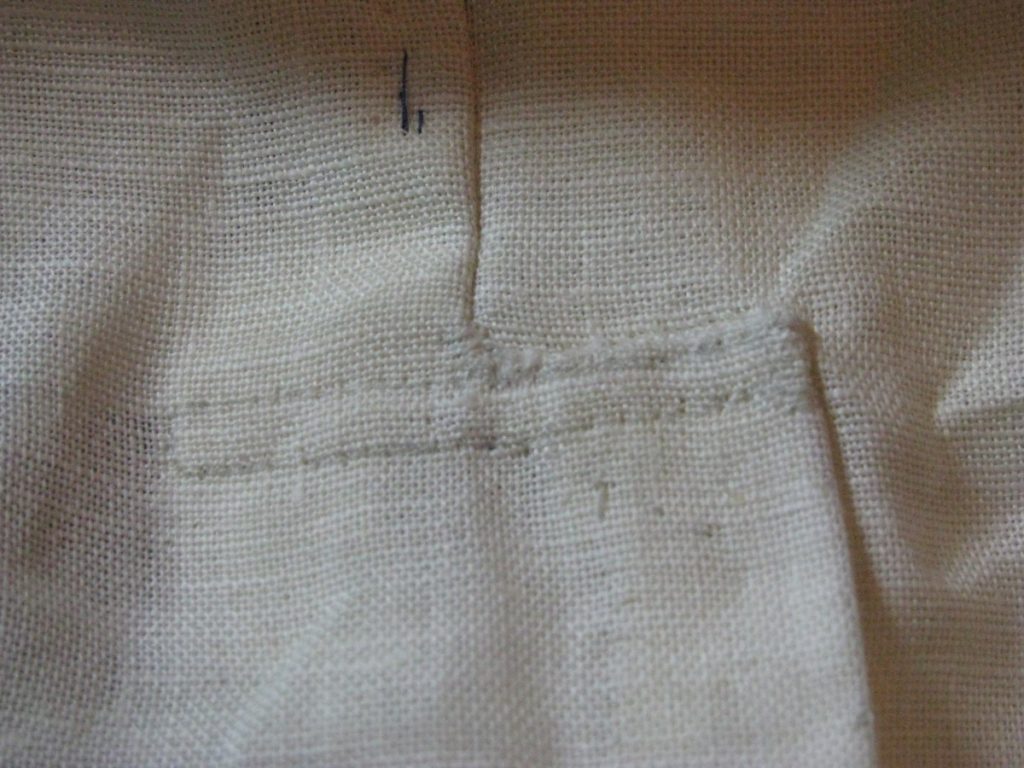
Completing the Back Seam
It’s now finally time to sew the two halves of the coat together. Lay the two halves, right sides together, on the table and align the back seam.
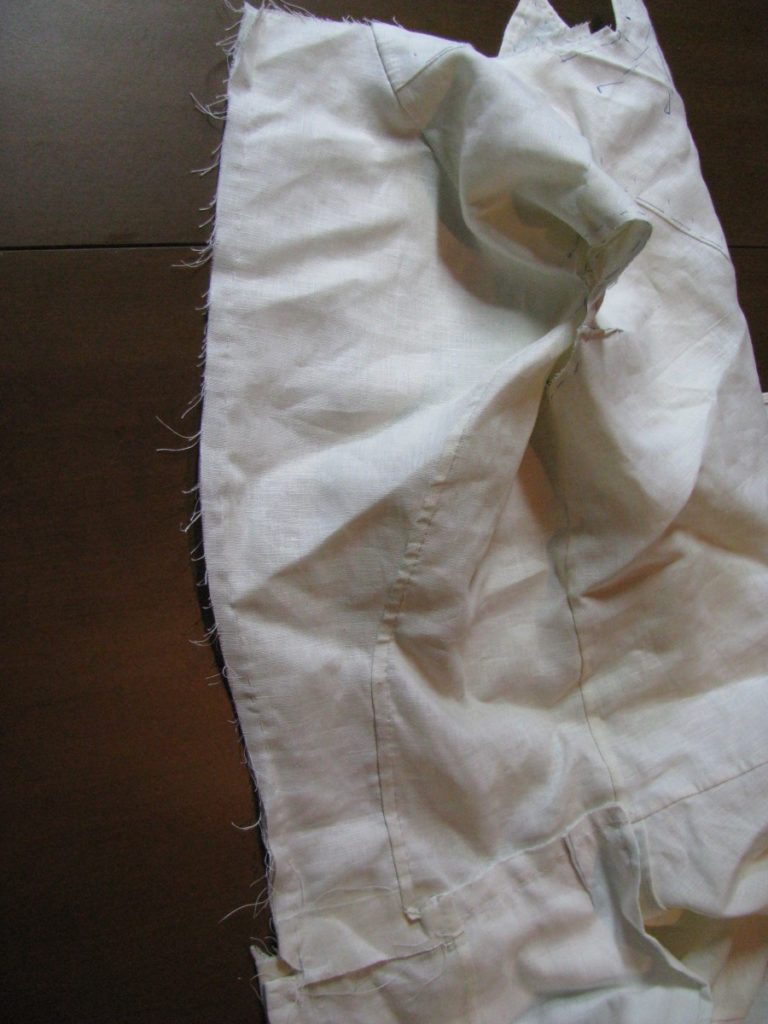
Baste along the seam about 5/8″ from the edge, just outside of the seam allowance.

At the bottom near the vent area, the top of the diagonal cut on one half of the back should align with the square edge of the other coat half.
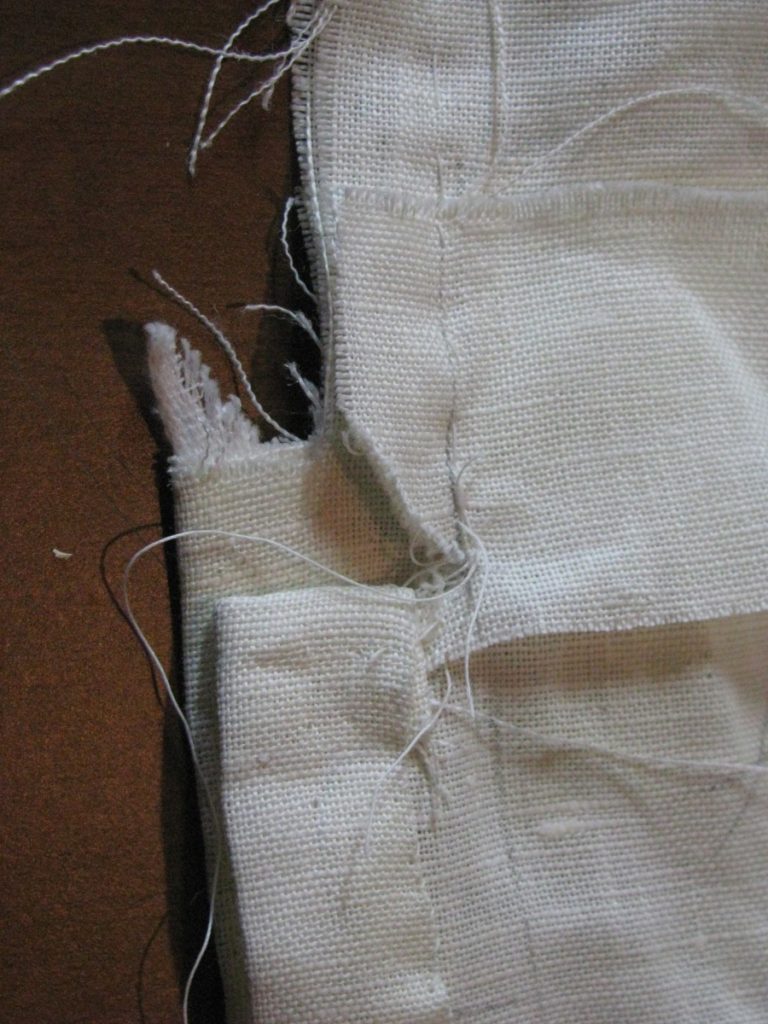
The inside point of the angled cut is the precise location that you want to end the stitch line on.
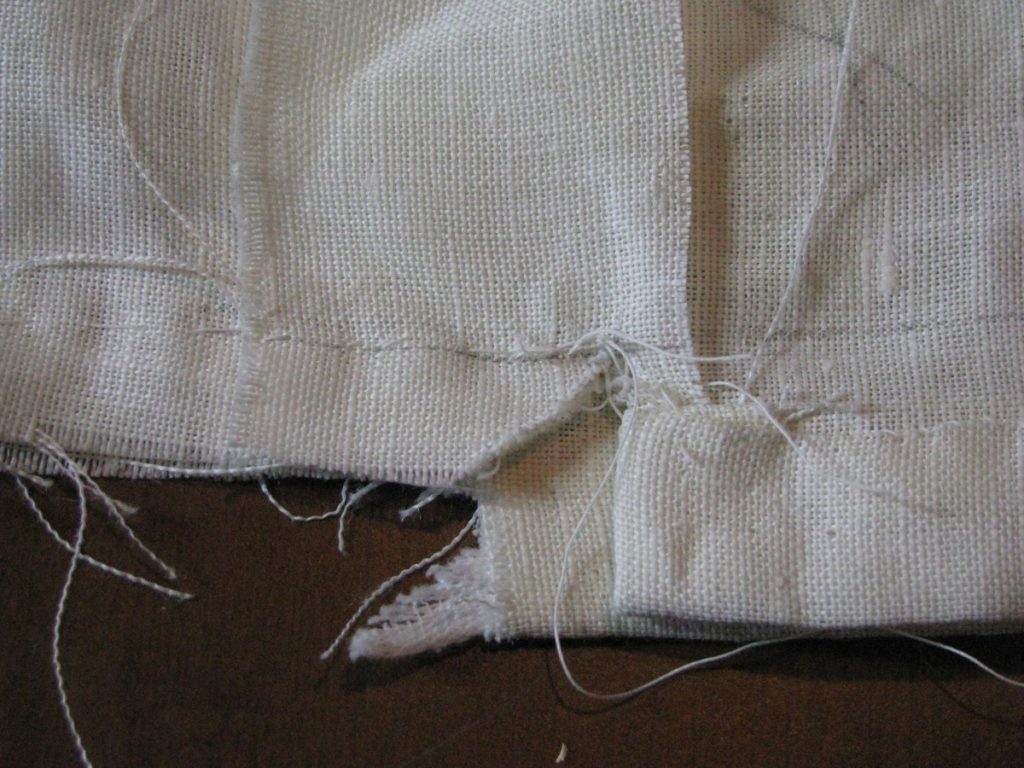
Transfer that point to the other half of the coat and mark the point with cross hairs. This should correspond with the 1/2″ seam allowance of the back seam.
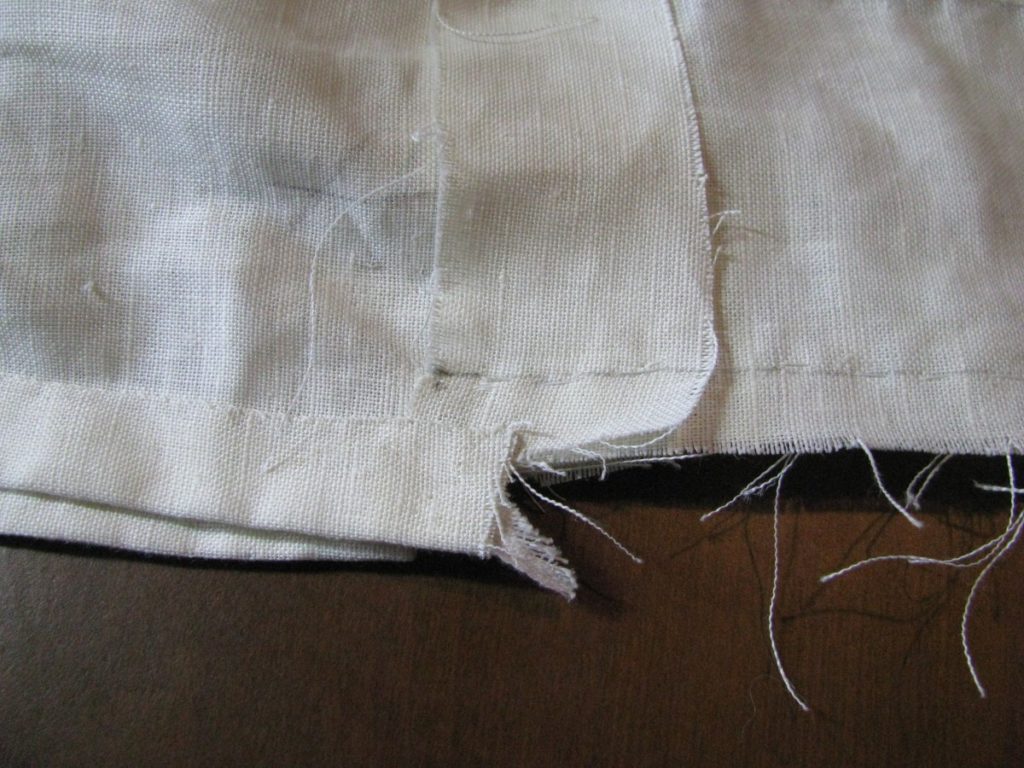
Continue drawing the seam allowance along the edge of the coat to the neck.
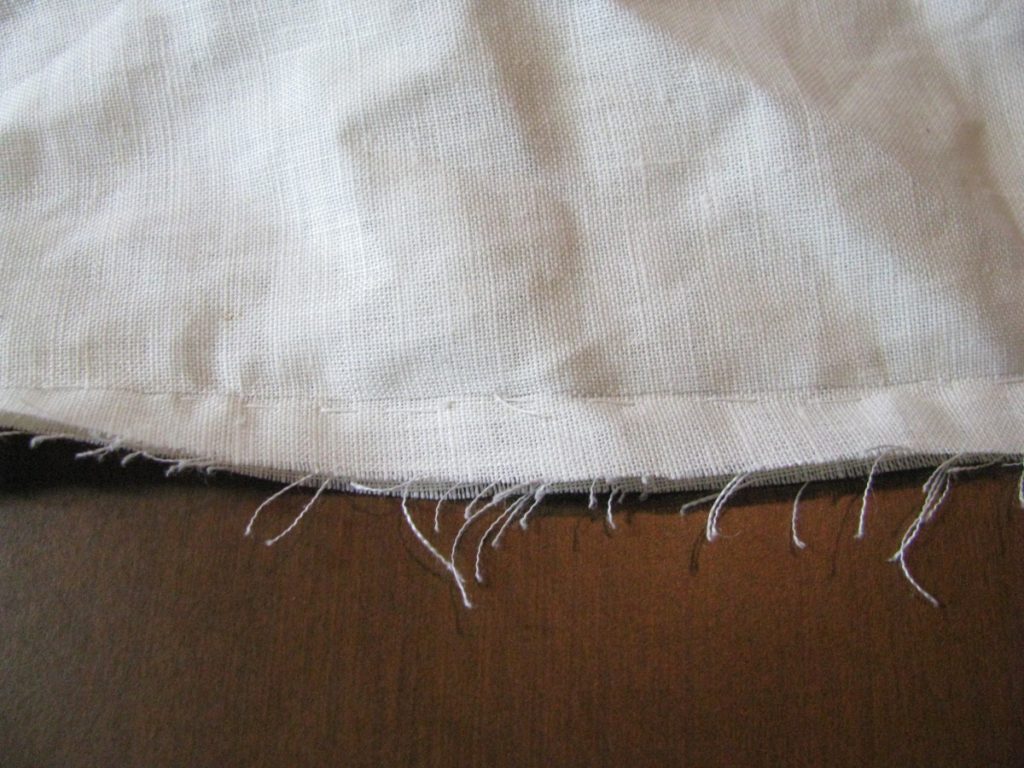
With the ‘right’ side of the stitching on the half of the coat without the diagonal cut, sew the back seam using a back stitch or back and fore stitch.
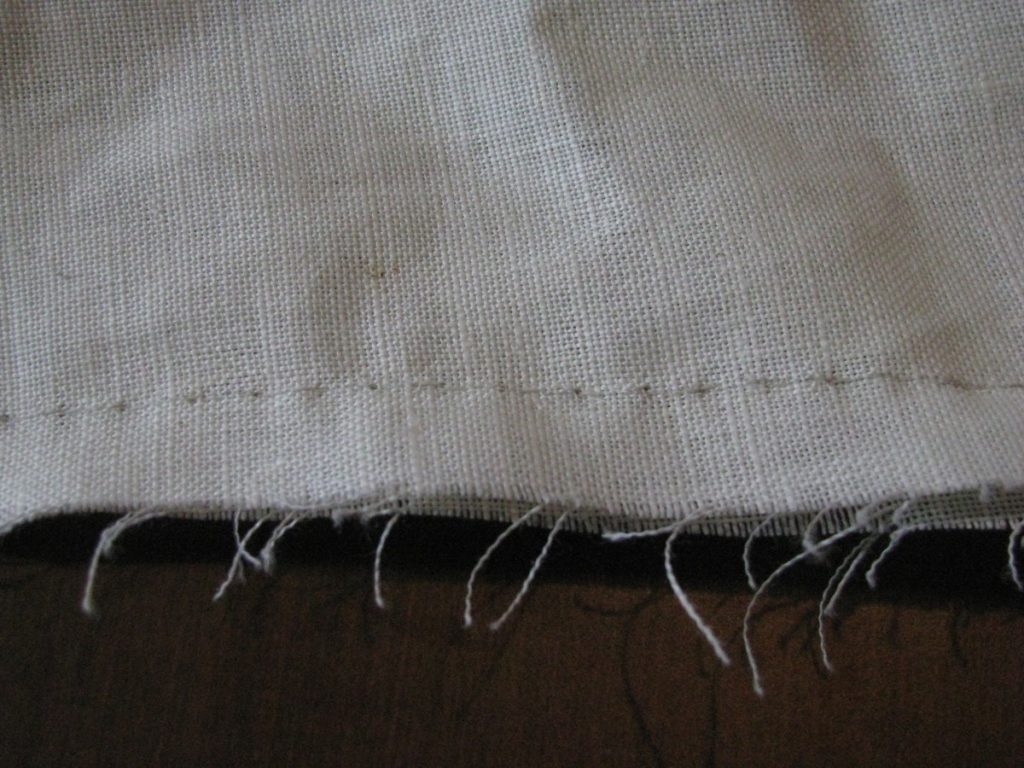
As you get to the bottom two inches, switch to a back stitch. This is one of the most stressed areas of the coat, and so any extra strength in this area is most welcome. Note how the stitching stops at that point.
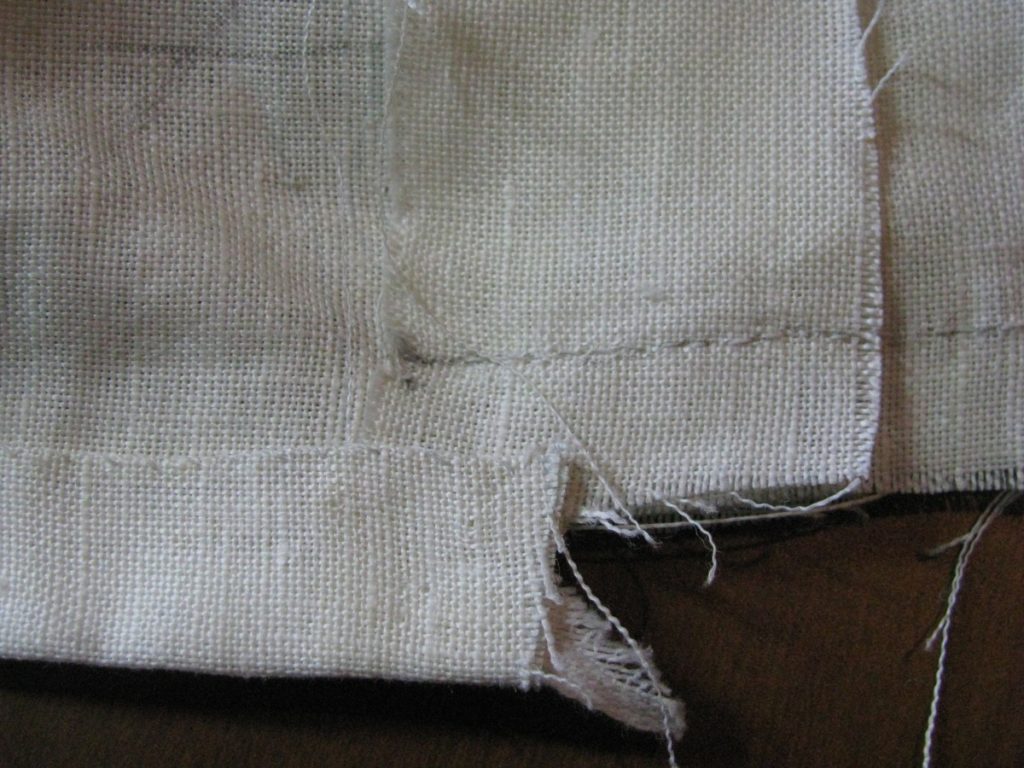
Here’s the view of the back vent area from the other side. I was off with my stitching by about 1/32″, which is workable. The fraying linen sure doesn’t help!
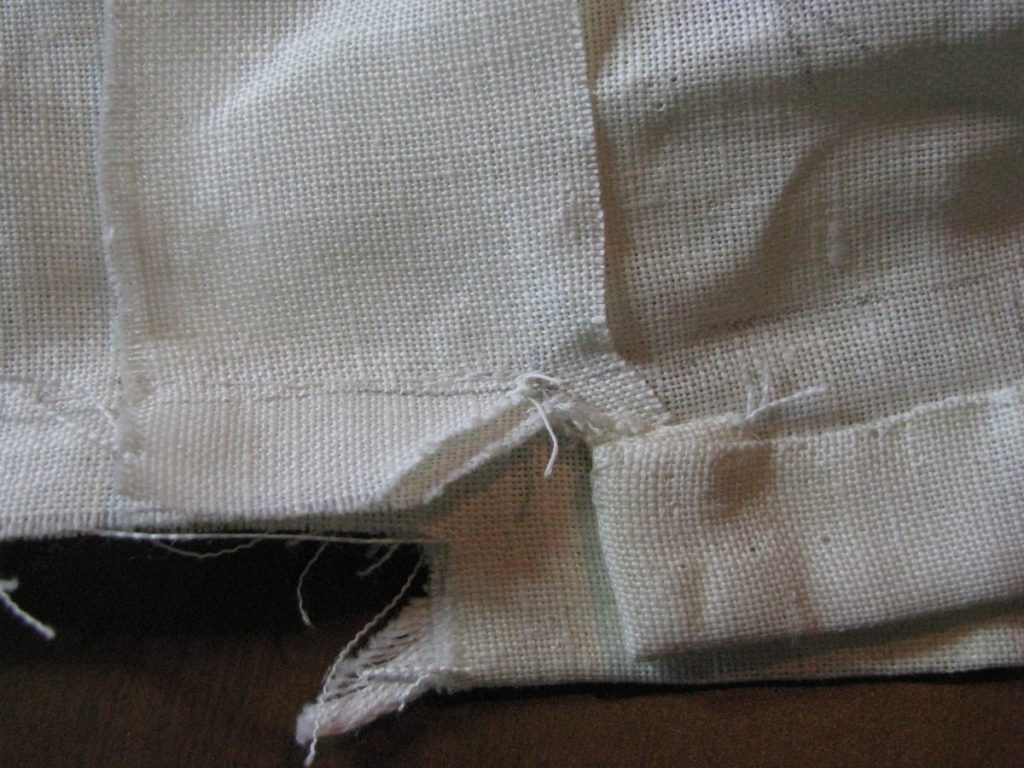
Trim the seam allowance of the back to 1/4″ inch on the side with the diagonal cut.
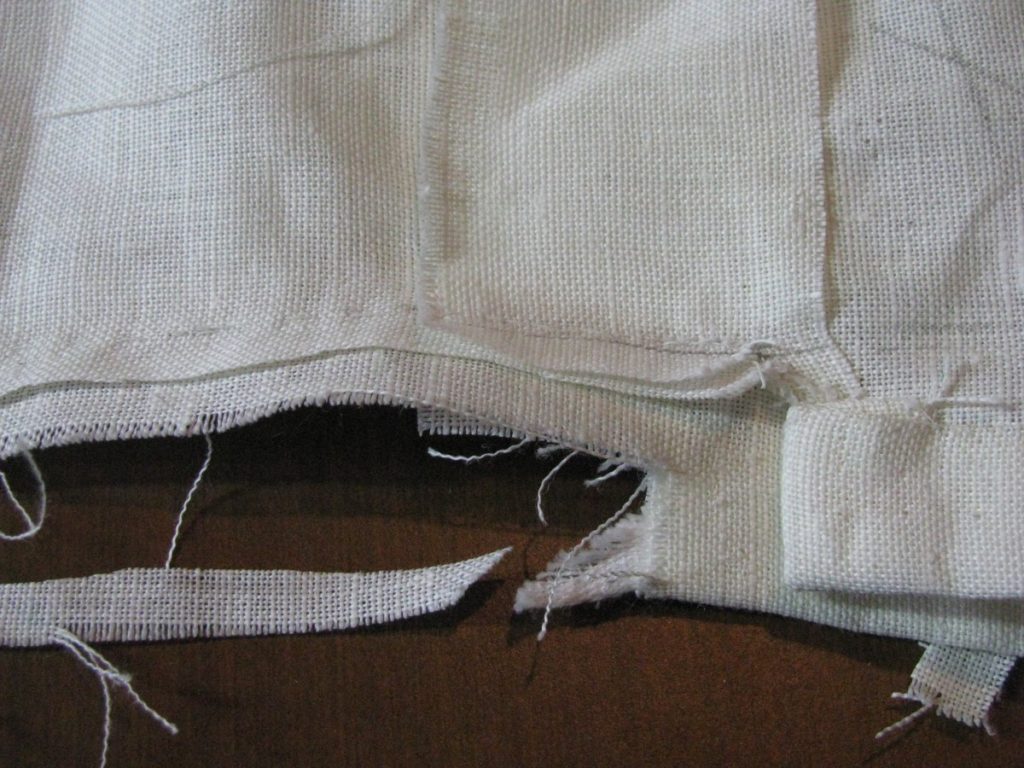
Turn the coat over and make a small diagonal cut, this time just a hair over 1/4″ in depth. This will allow you to fold the seam over, baste, and whip stitch as with the other seams. For some reason I did not photograph the felling, but you should be able to figure it out by now.
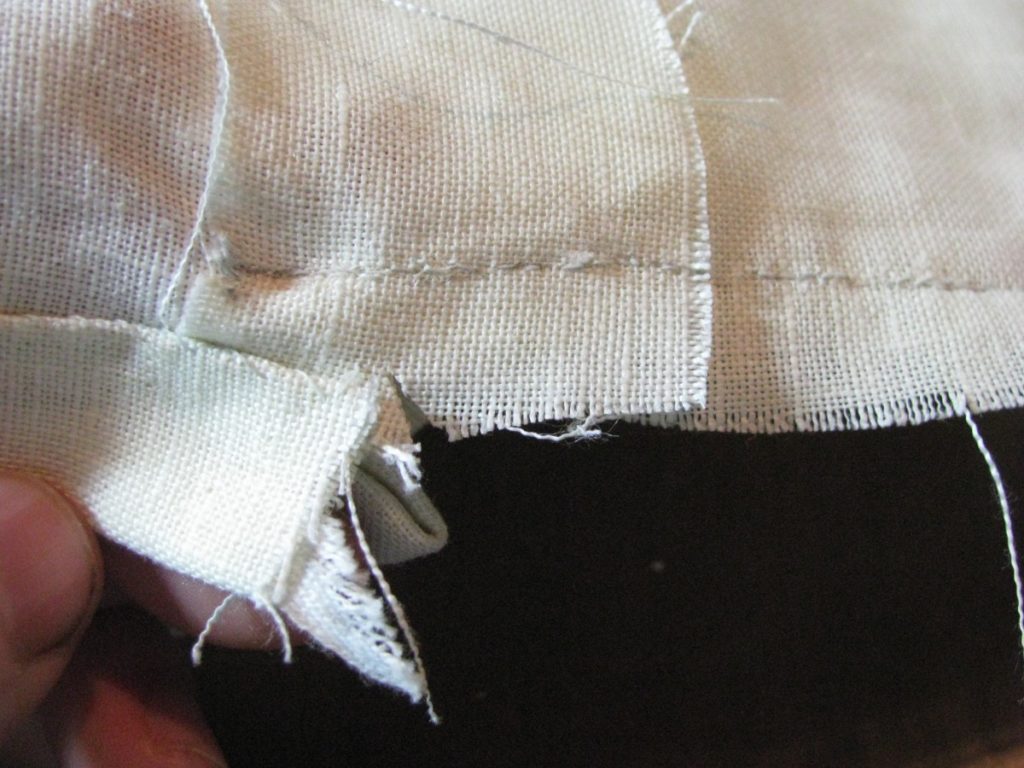
The Shoulder Seams
It’s finally time to move on from the facings! We’ll begin sewing the shoulder seam by first removing any unnecessary inlays. Feel free to have a fitting beforehand if you want to fiddle with the fit more closely.
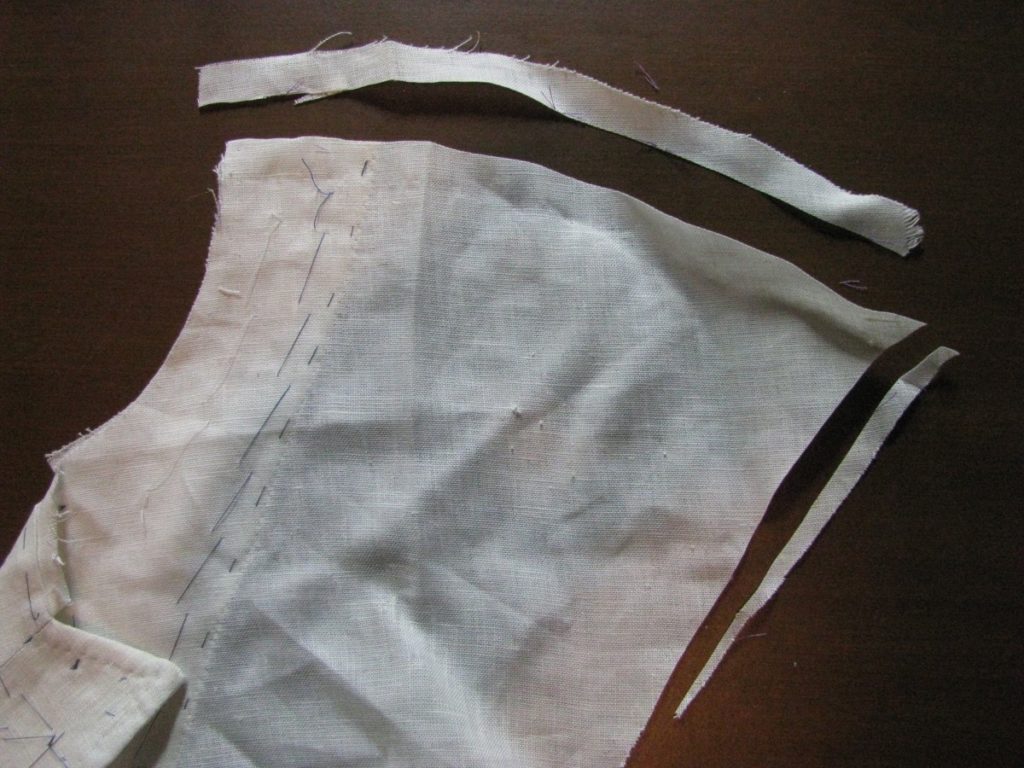
With right sides together, line up the neck edge of the shoulder seam on the forepart with the corresponding point on the back. You want the seam allowances at the very edge of the neck. to meet perfectly. Hold in place with a pin. If you’re feeling brave and want to experiment with techniques, you can hold this between your pinkie and the palm of your hand, allowing your other fingers to manipulate the fabric – this takes some practice though.
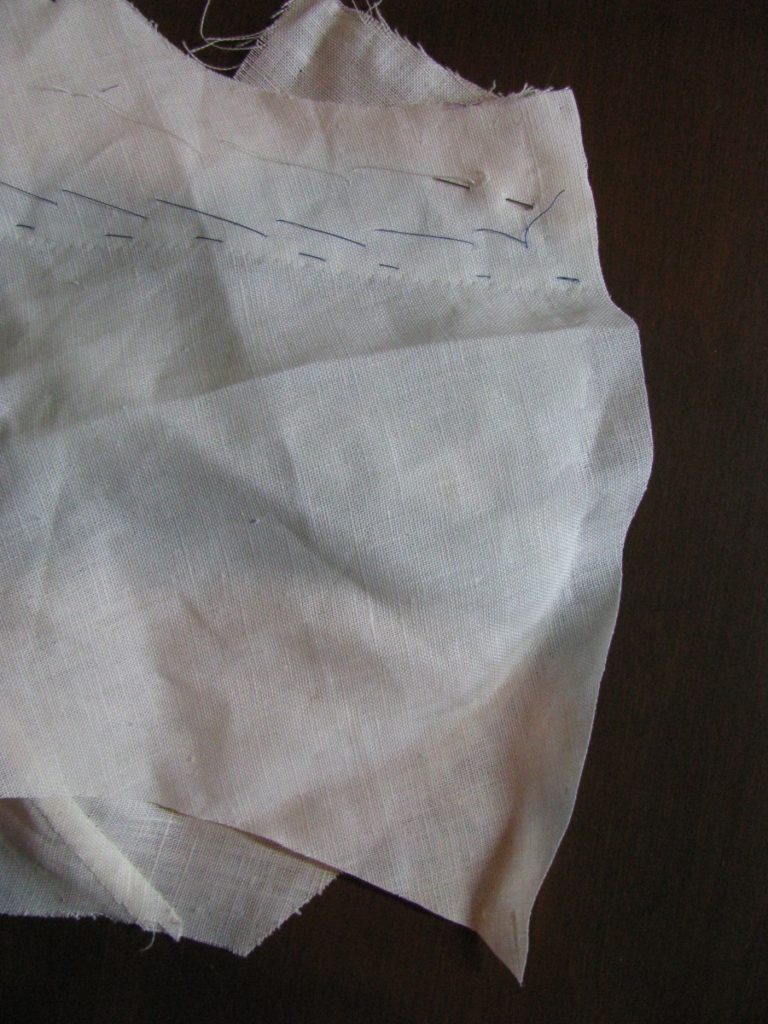
Line up the other edge of the shoulder seam and the armscye of the back at their seam allowances, and baste across the shoulder seam. You’ll notice that the back seam is longer than the forepart, which will give added room for the shoulder blades. Just gradually ease it in as you are basting.
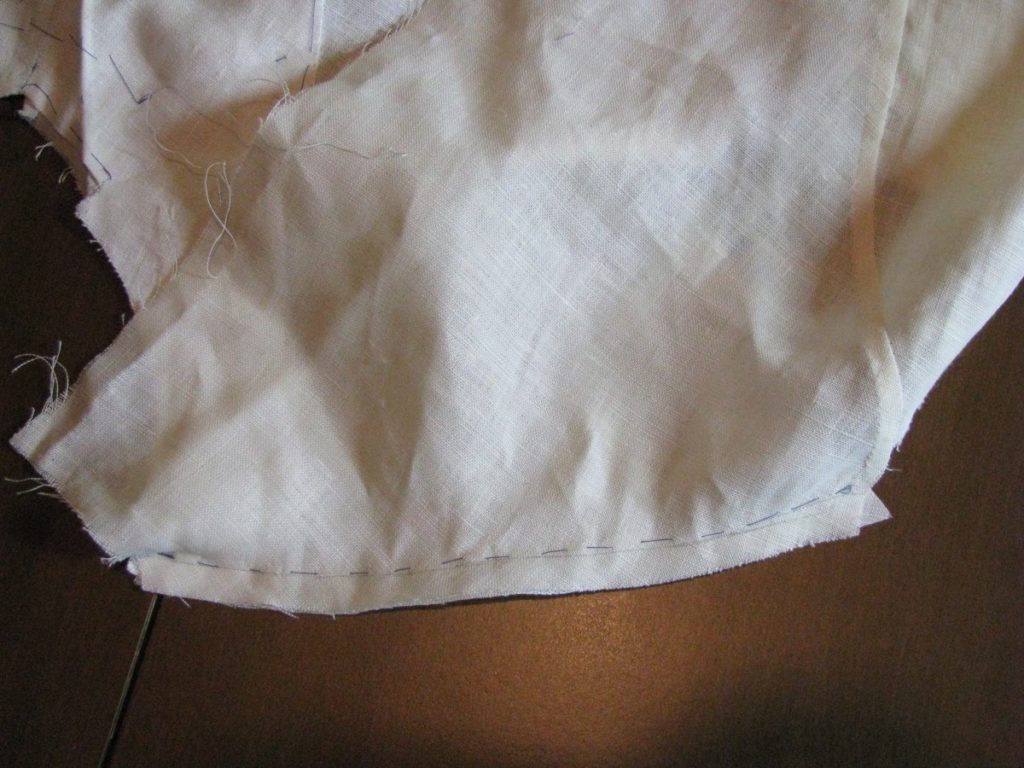
On the back, mark in the .5″ seam allowance if you wish. The right side of the stitching should be on the back of the coat body, so that the seam allowance can be folded towards the forepart.
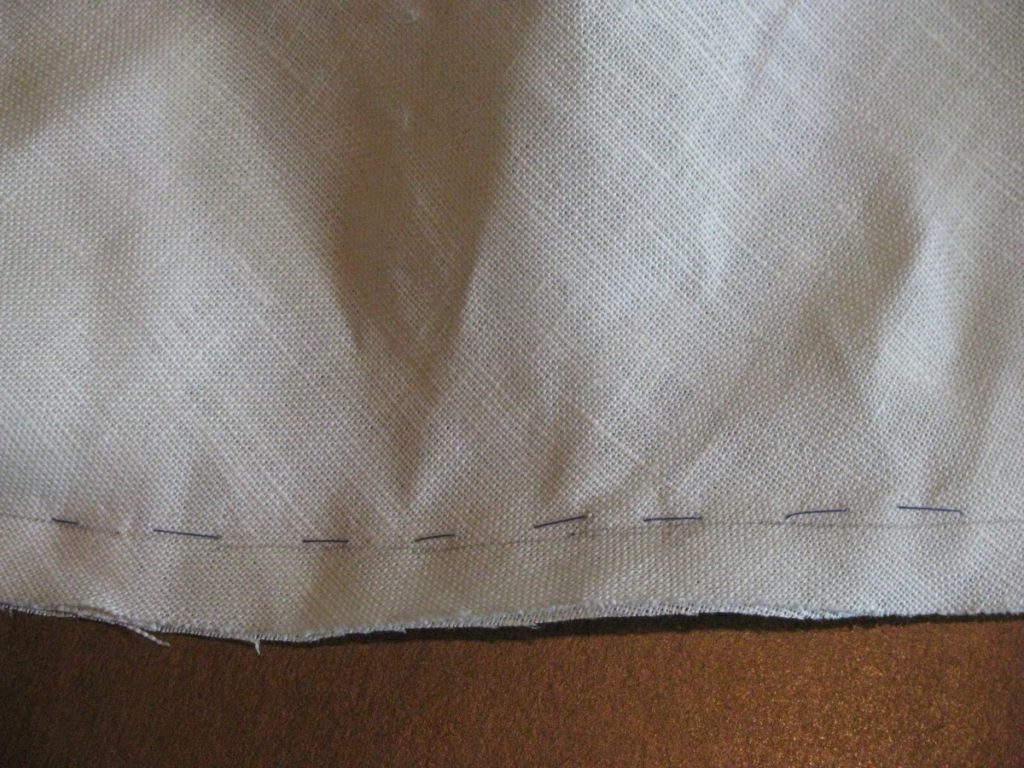
Sew the shoulder seam with a back stitch or back and fore stitch, and then turn the coat to the forepart side and trim the forepart seam allowance to 1/4″.
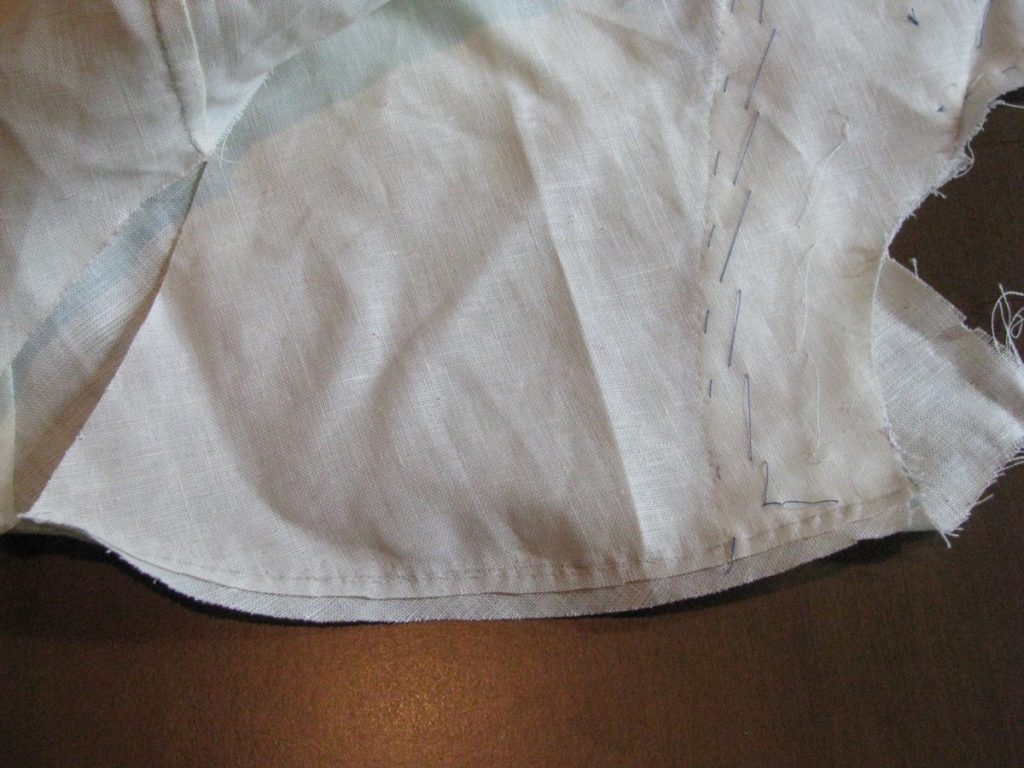
Fold over the remaining seam allowance and fell in the usual method. Note that by folding the seam allowance towards the forepart, we preserve the width of the back at the armscye. If we had gone the other way, it would look much narrower.
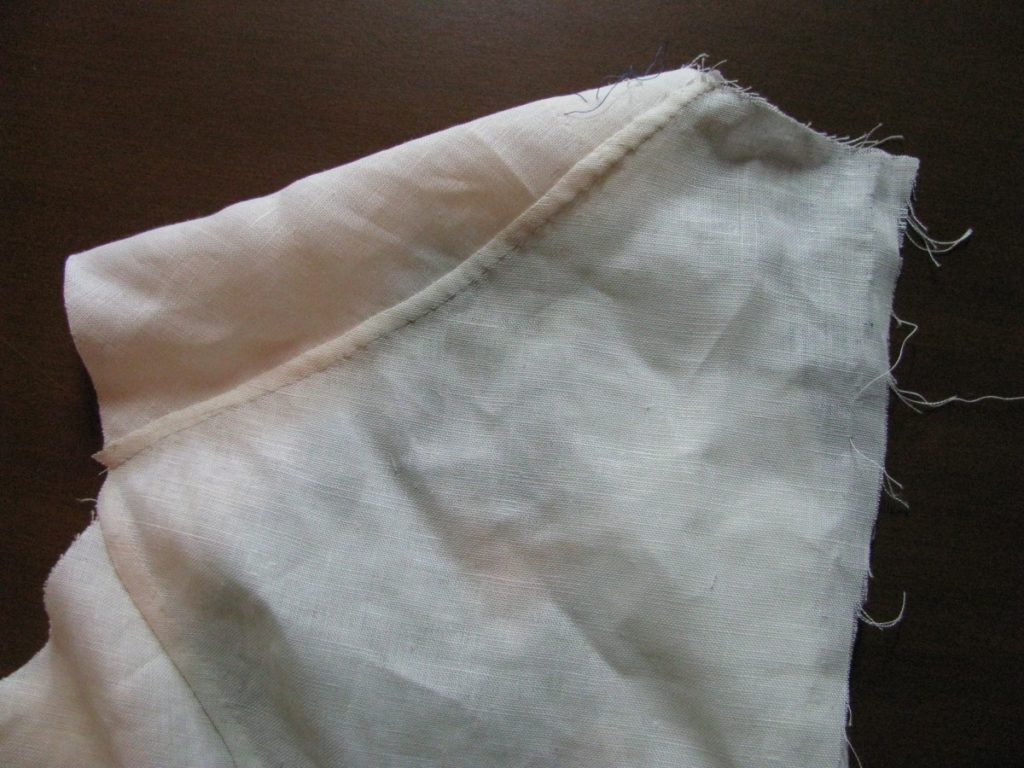
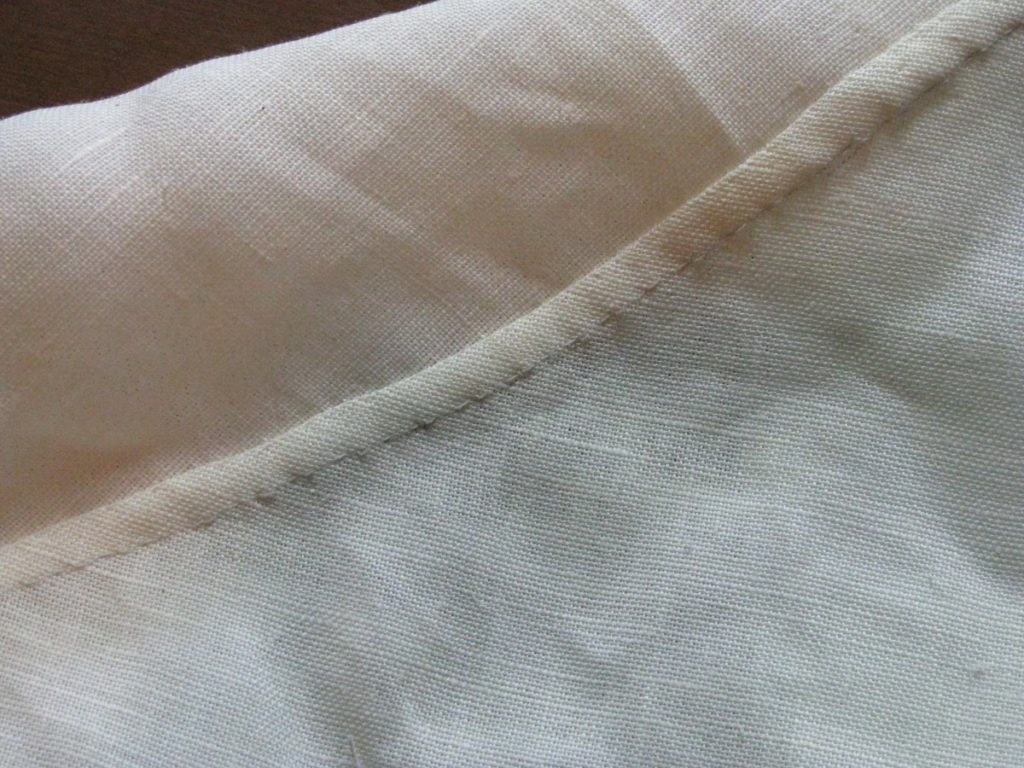
Repeat for the other shoulder.
Finishing the Facings
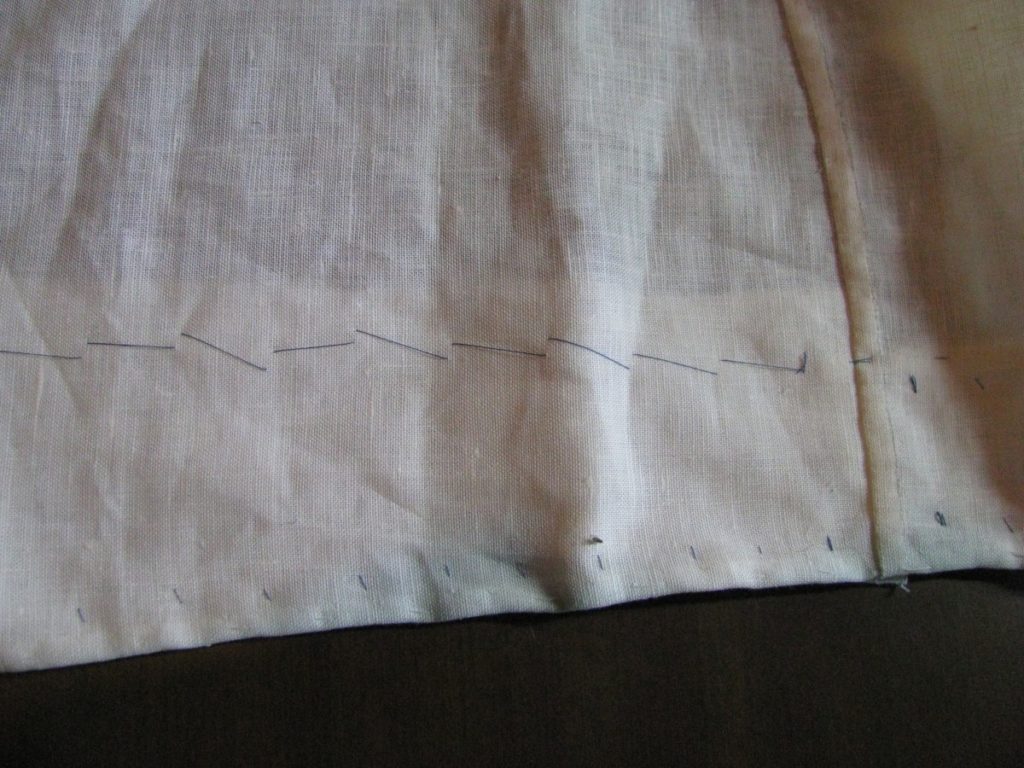
Working from the outside of the coat, baste the facing to the forepart, about 1 inch from the inner edge of the facing. By working from the outside, you can ensure that the tension between the coat and the facing below are neutral, which will avoid any pulling or stress when the coat is finished.
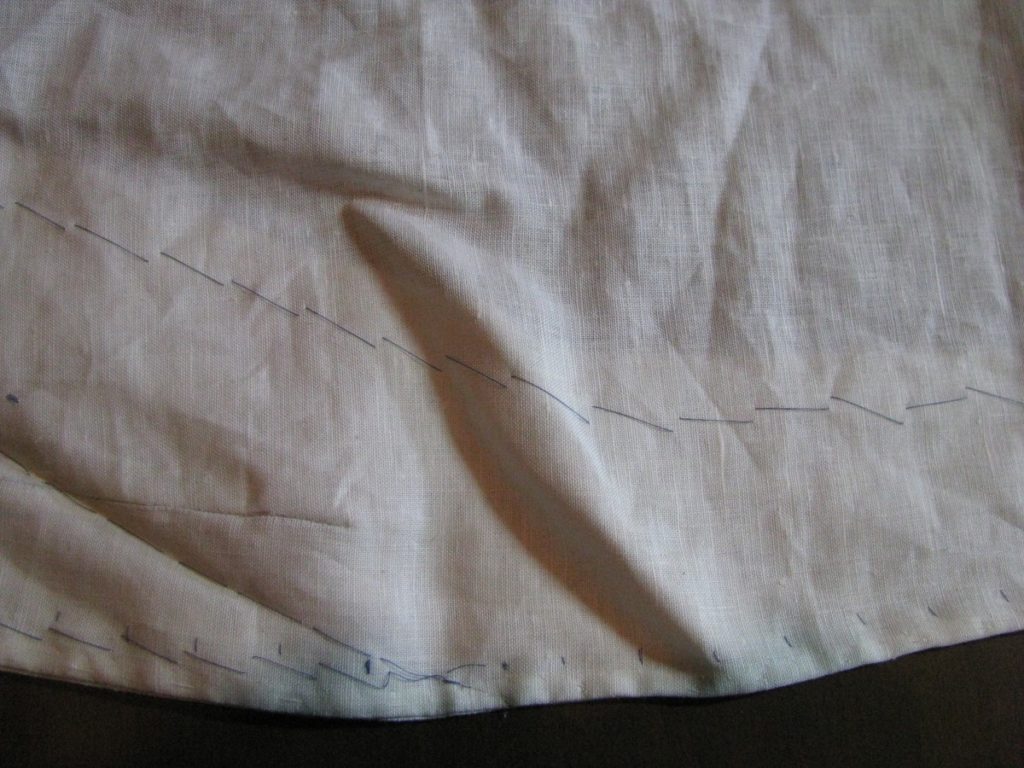
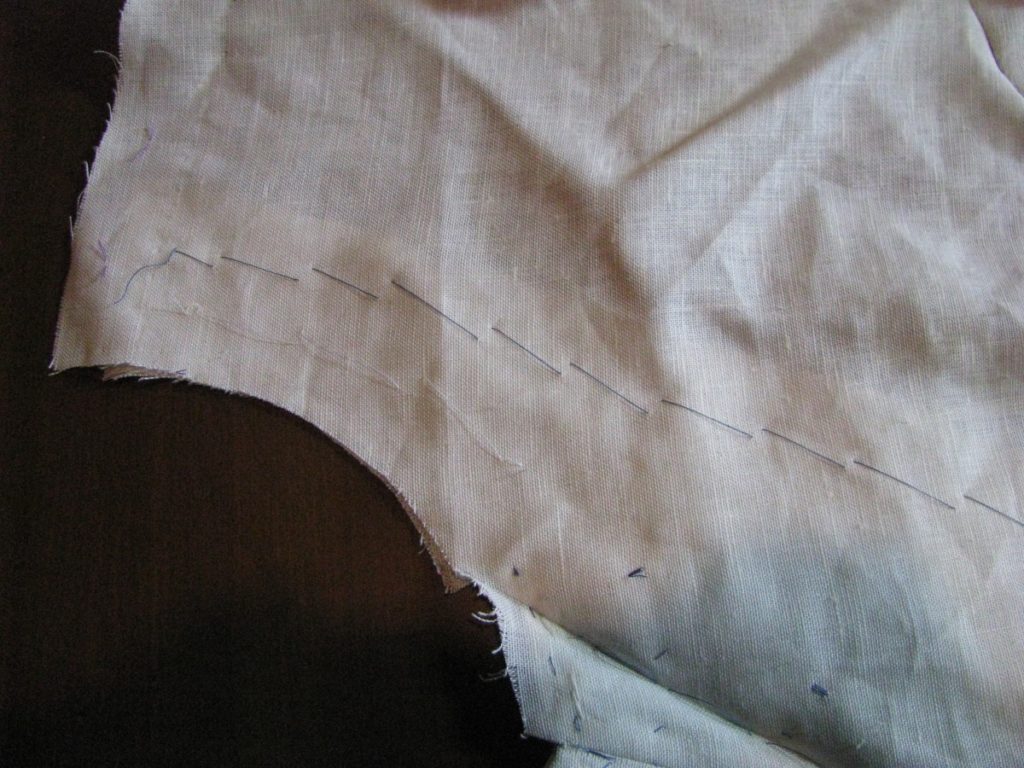
Fold under the raw edge of the facing and baste it securely, as you did for the front skirt facing.
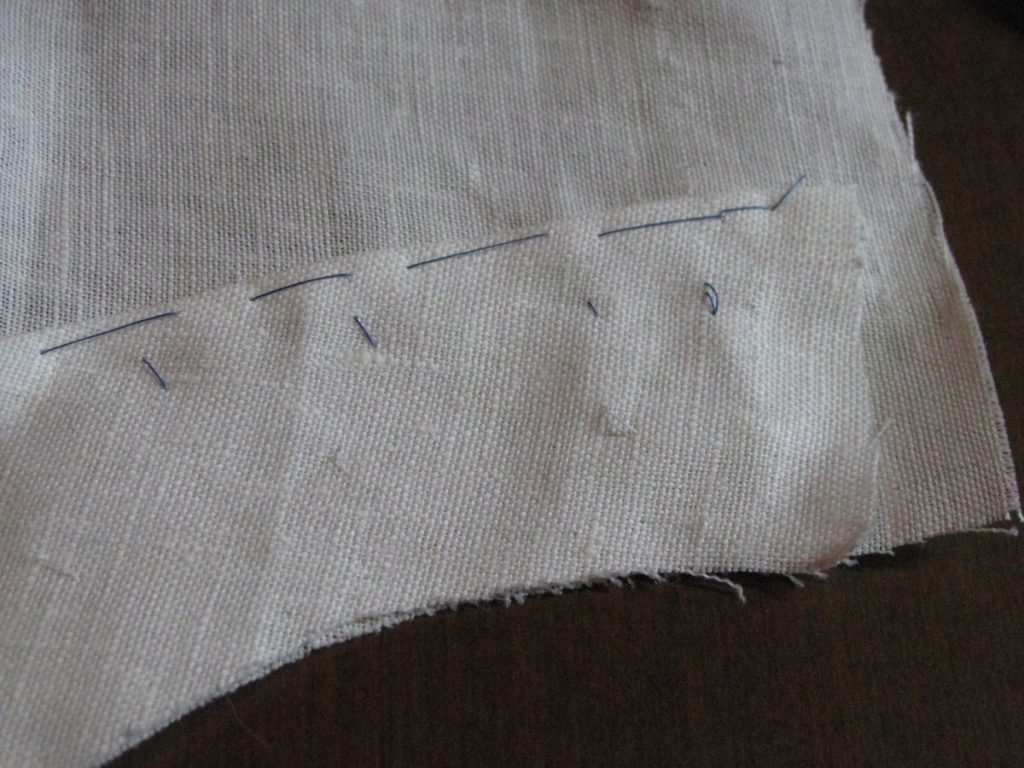
Leave about an inch of the facing free at the bottom, which should overlap the skirt facing.
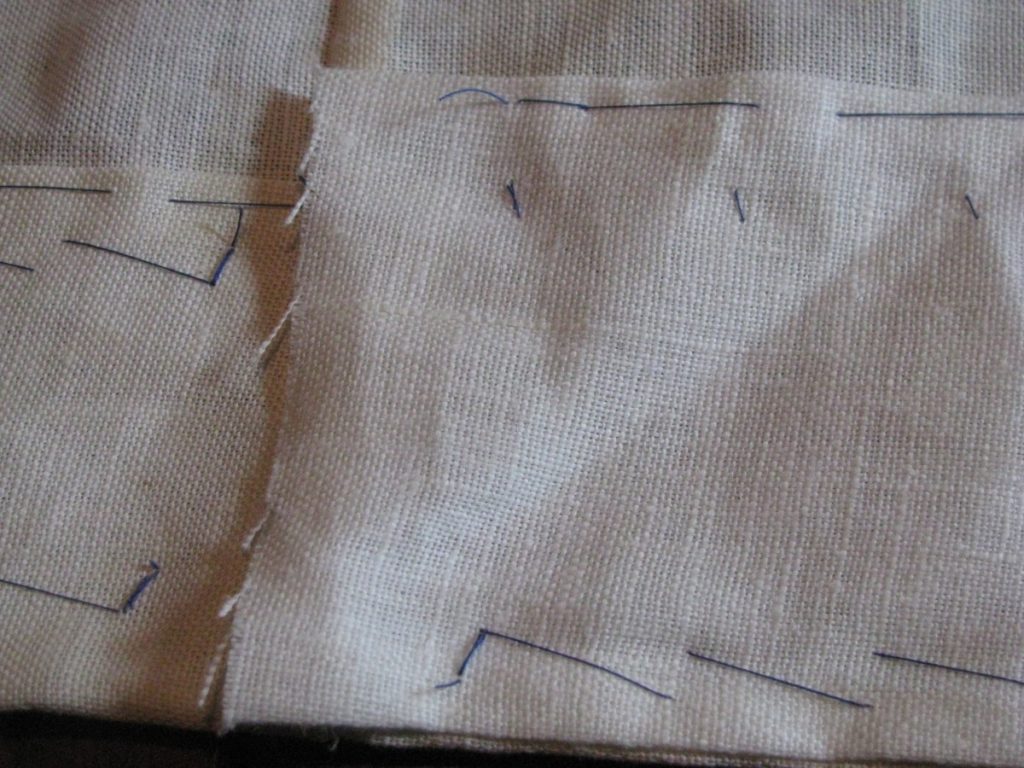
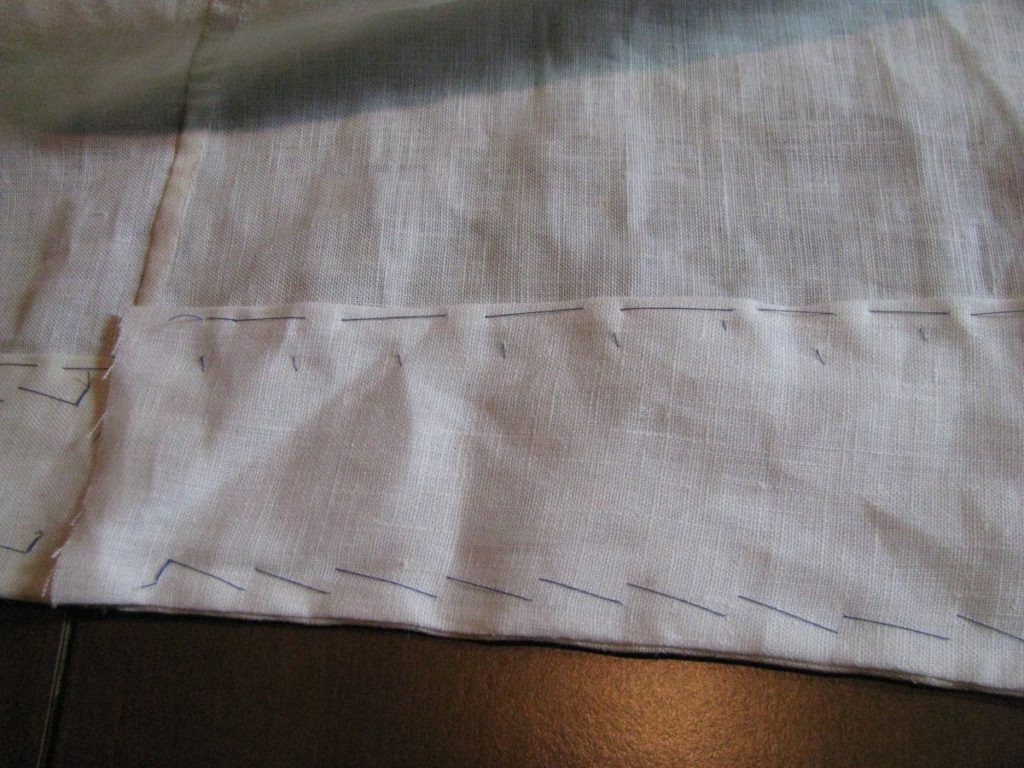
Felling the Edges
Starting at the waist seam, fell down the folded edge of the skirt facing. These stitches will be visible on the outside, so try to catch only a thread or two of the skirt fabric.
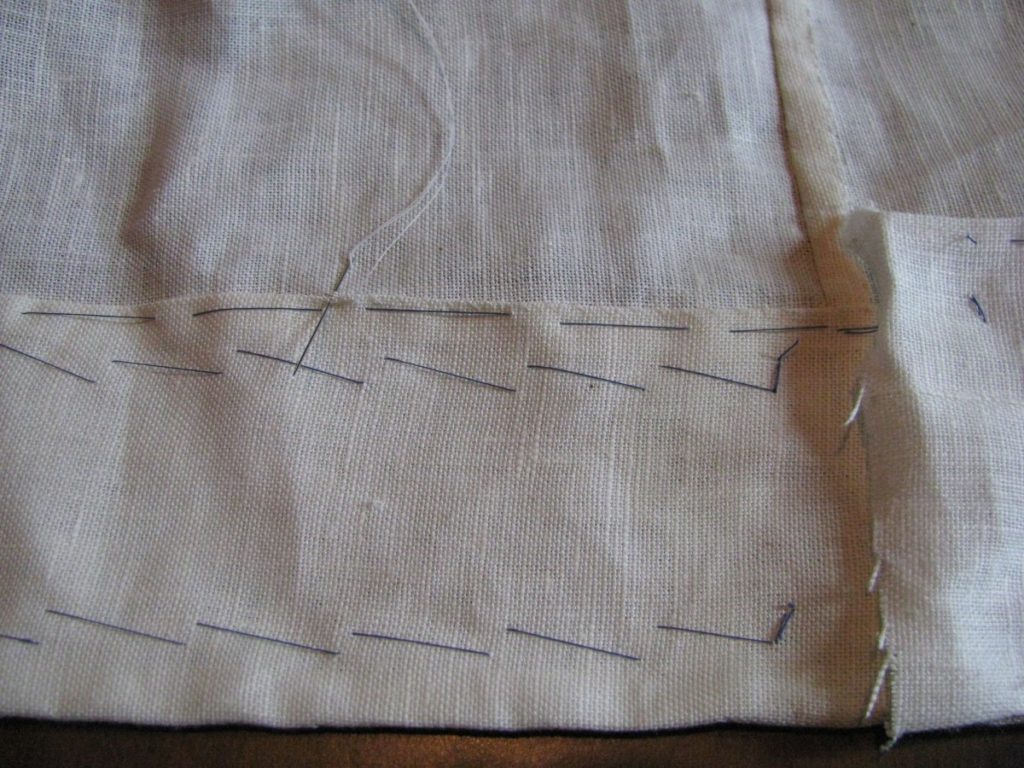
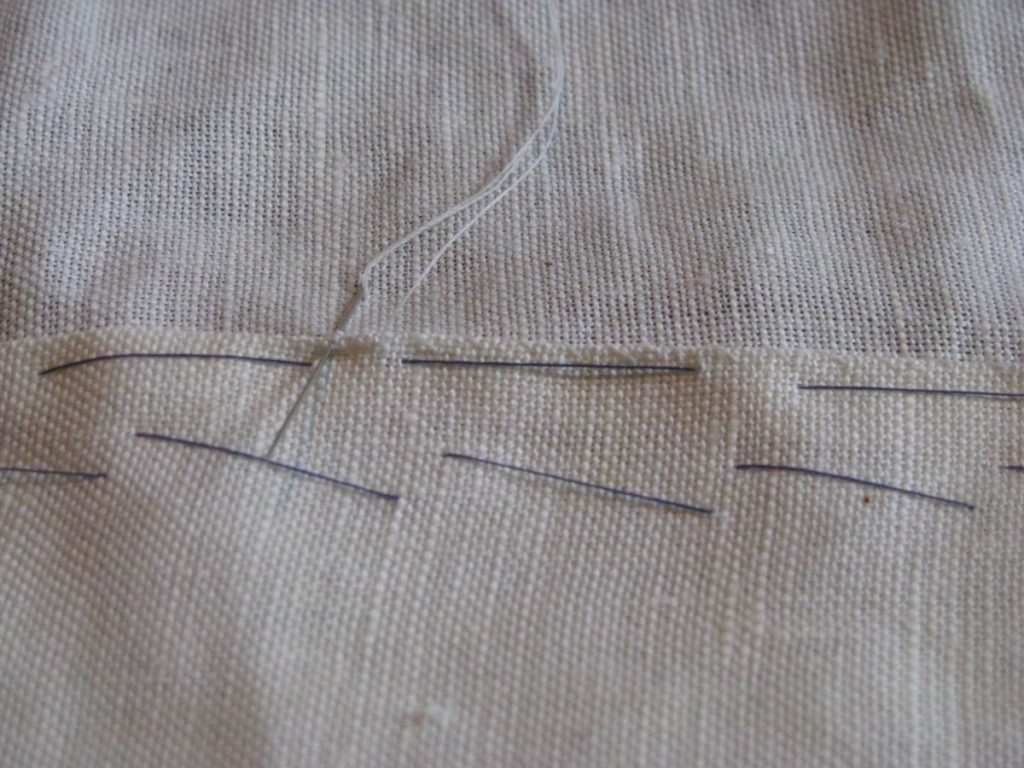
Continue felling all the way to the bottom of the skirt, and continue around the bottom of the facing.
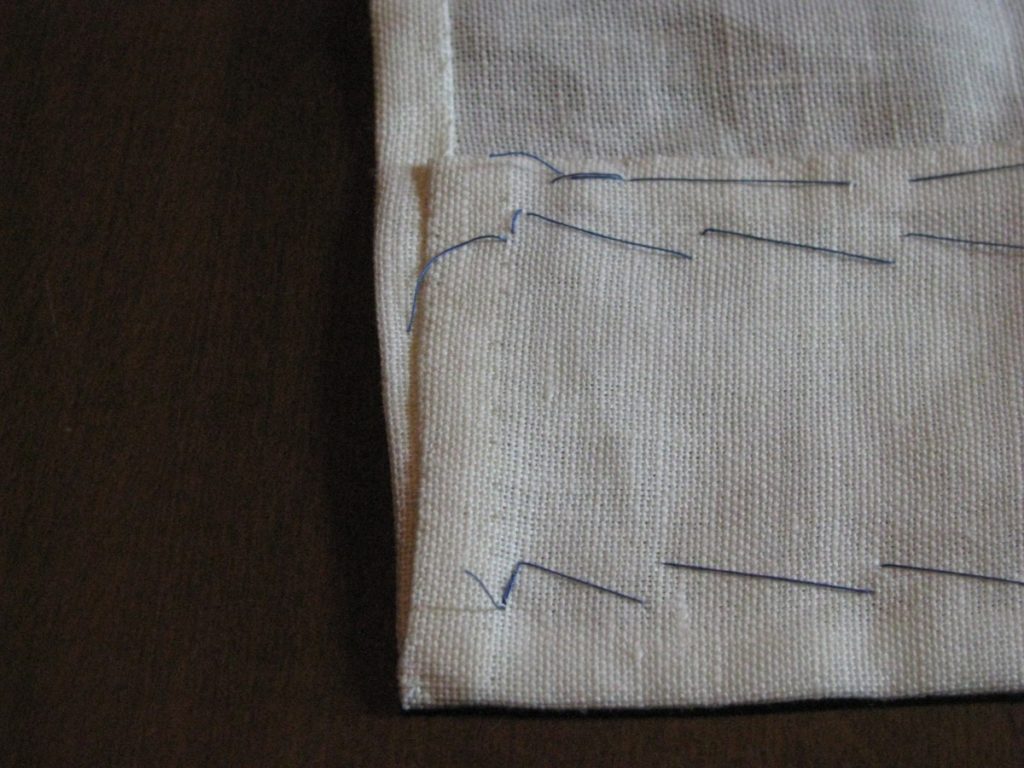
Now that the skirt facing is complete, you can basted down the bottom of the forepart facing. Fold the raw edge under about 1/4″, or whatever looks best in your particular case.
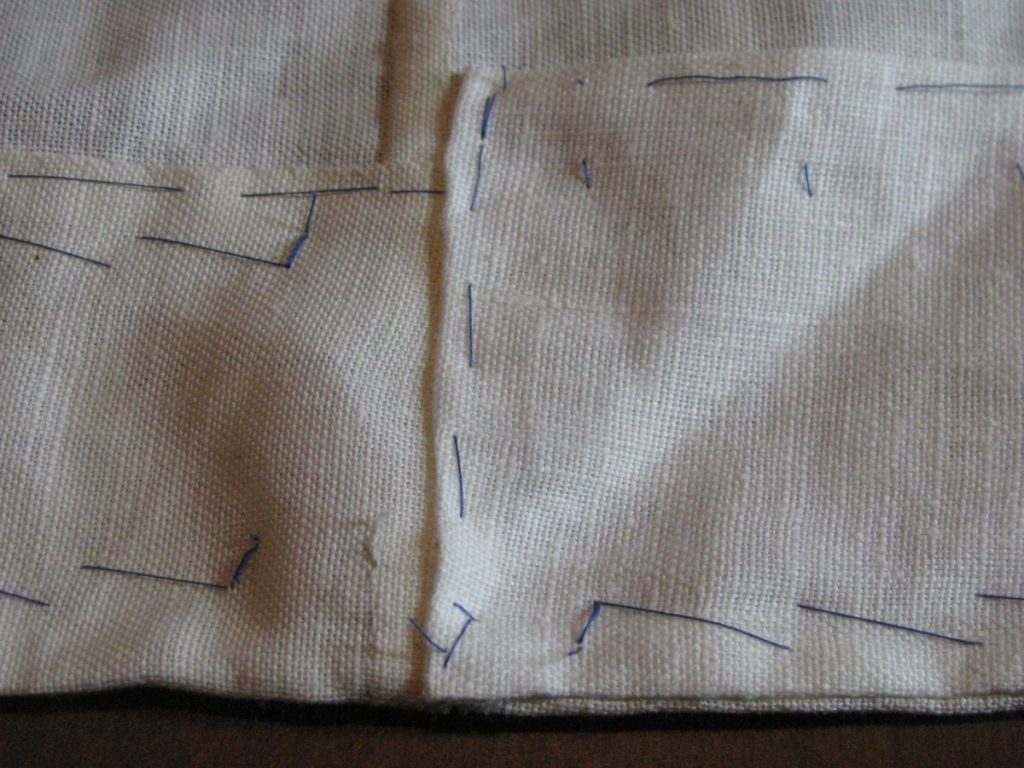
Baste the facing down along the raw edge, starting at the shoulder seam . . .
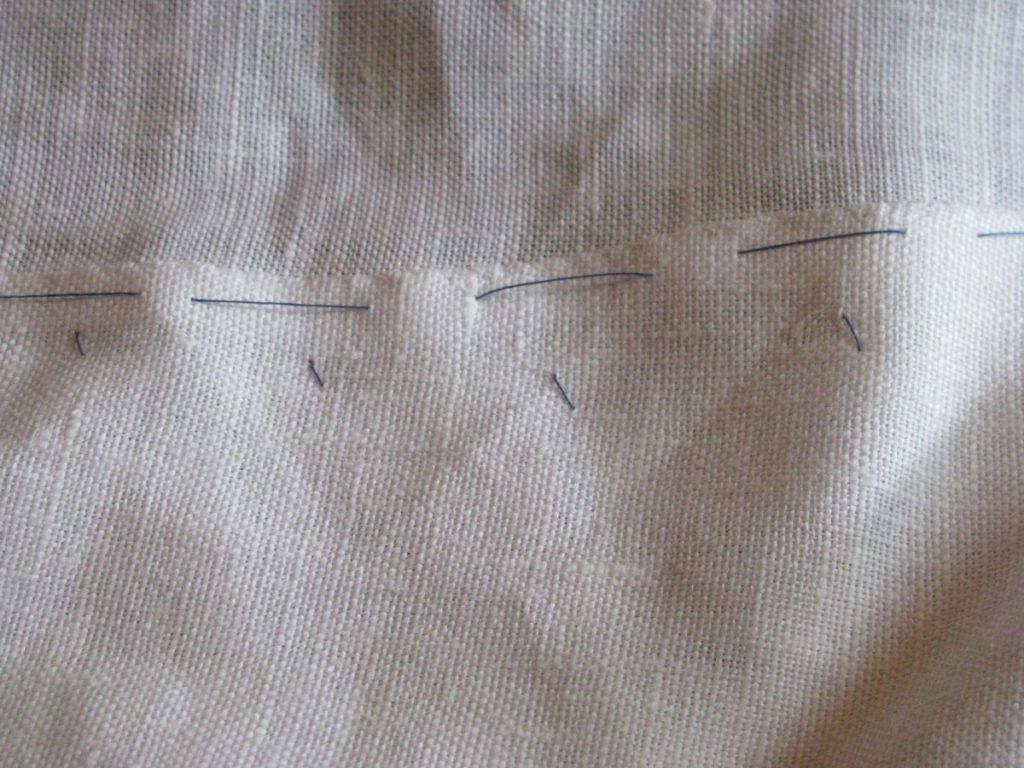
. . . and continue to the waist seam, felling along the bottom edge, and then the first 1/2″ or so of the front seam (remember you had stopped the backstitches about 1/2″ to 1″ above the waist).
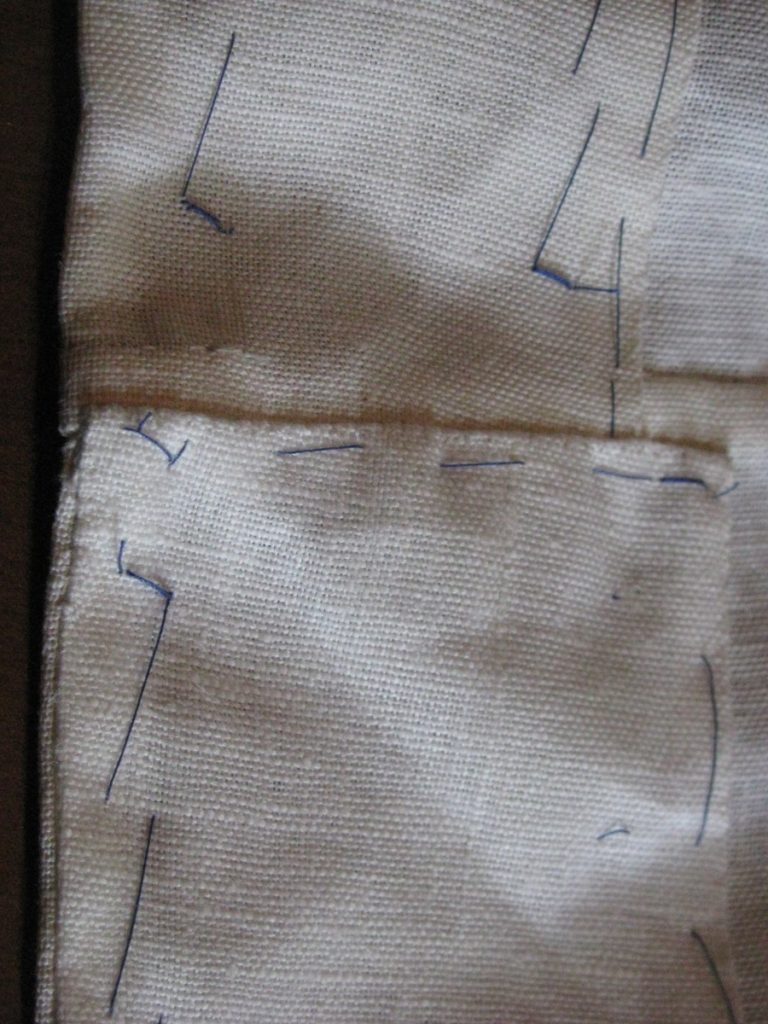
Now it is time to top stitch the edge of the coat facings, which serve to give a firmer edge to the coat, and also to prevent the seam from rolling out of its position. This could be done with either machine stitching or by hand, depending on your preference. I’ve chosen to use a side stitch here.
Begin at the top of the lapel, just at the lapel dart, and about 1/4″ from the edge. Ideally, you’ll catch the edge of the stay tape in your stitches. Work from the right side of the lapel at this point, as this is what will be seen when the coat is worn.
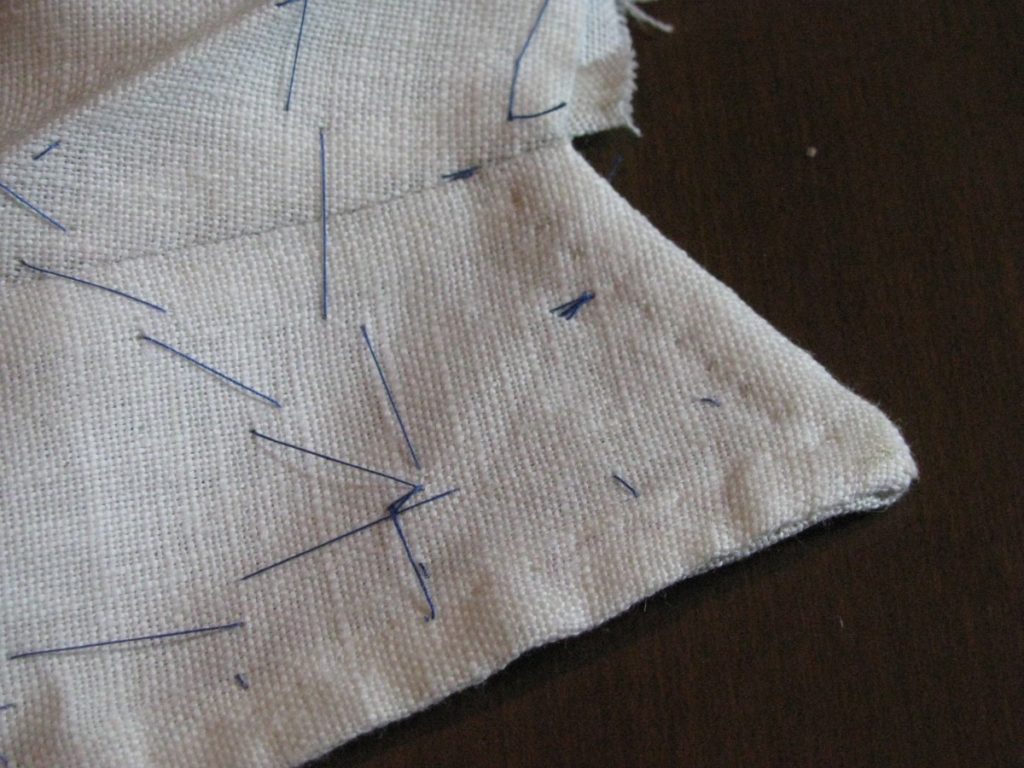
When you get to the roll line, turn the fabric over so that you are still working from the outside of the coat.
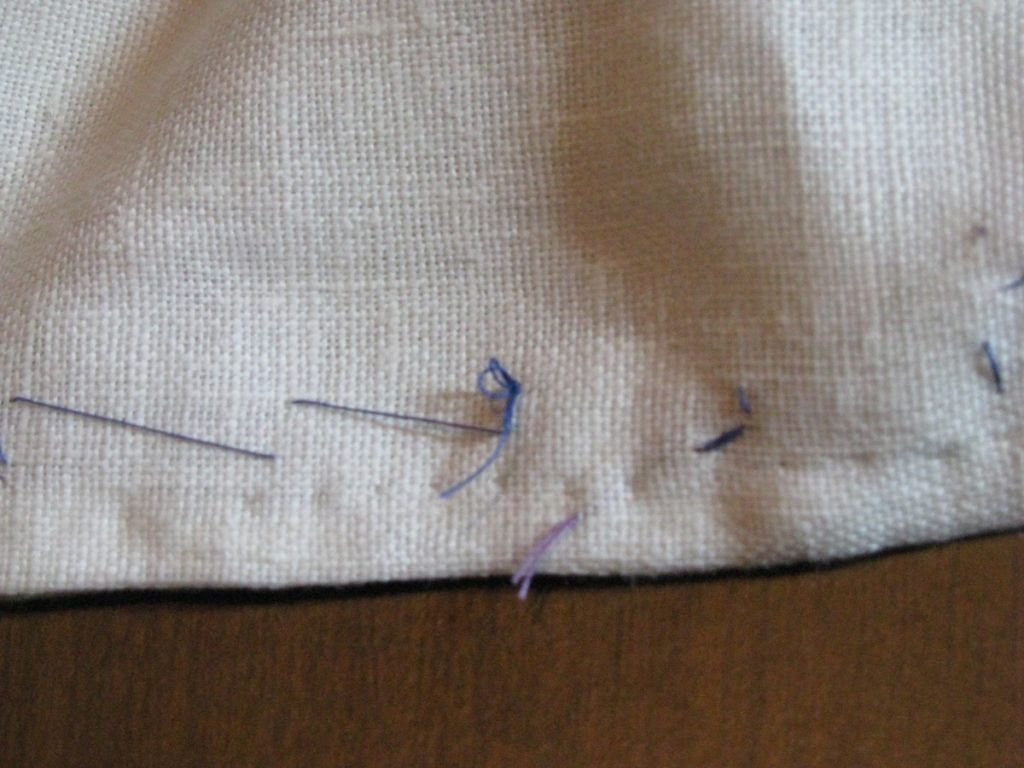
Continue stitching past the waistline, all the way to the hem of the coat.
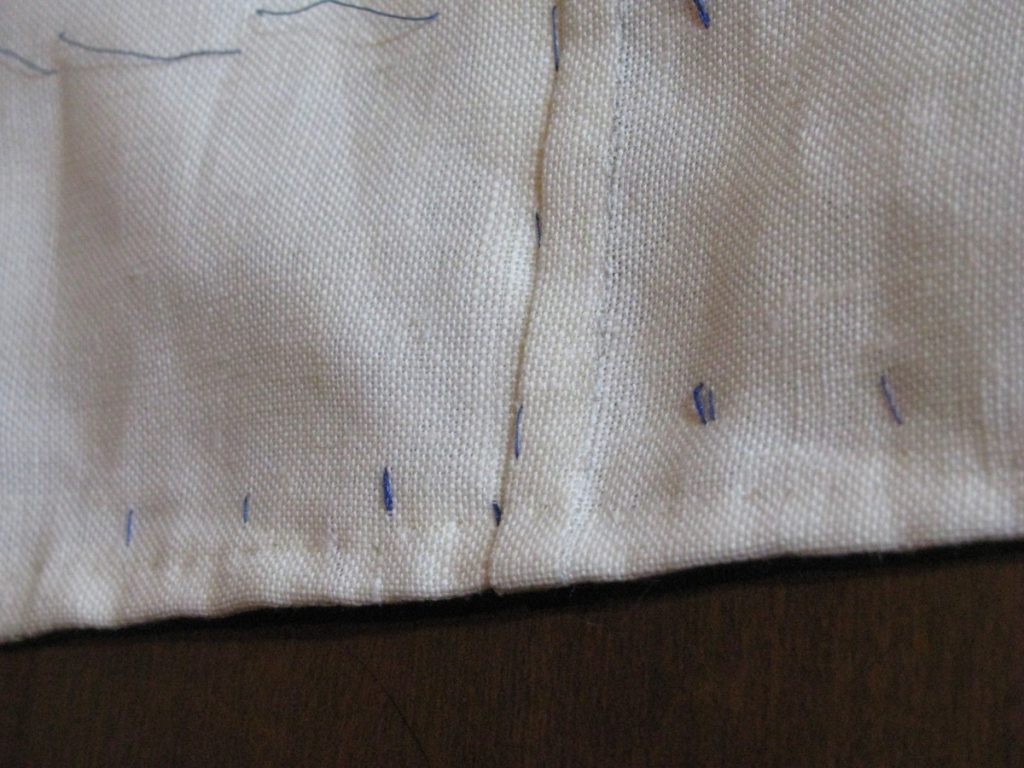
If you wish, you can do the same thing to the facings on the back of the coat. I usually do not, as they are thinner in width and tend to stay in their proper position.